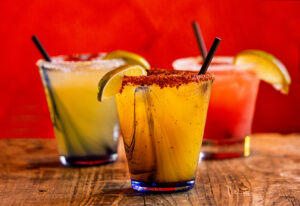
Whether it's Cinco de Mayo or National Margarita Day, Sonoma County serves up some marvelous margaritas any day of the year.
The post Where to Get the Best Margaritas in Sonoma County appeared first on Sonoma Magazine.
]]>
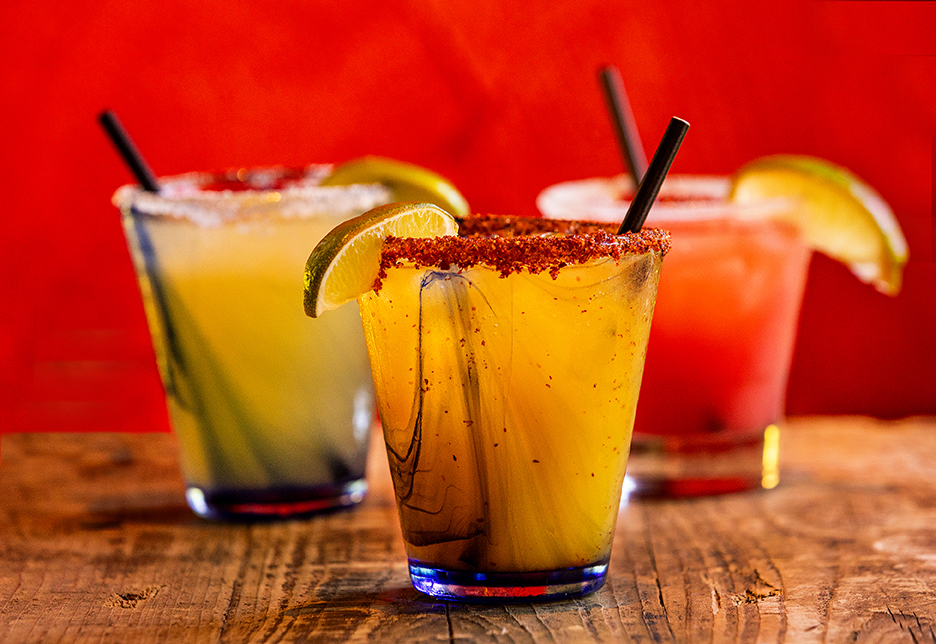
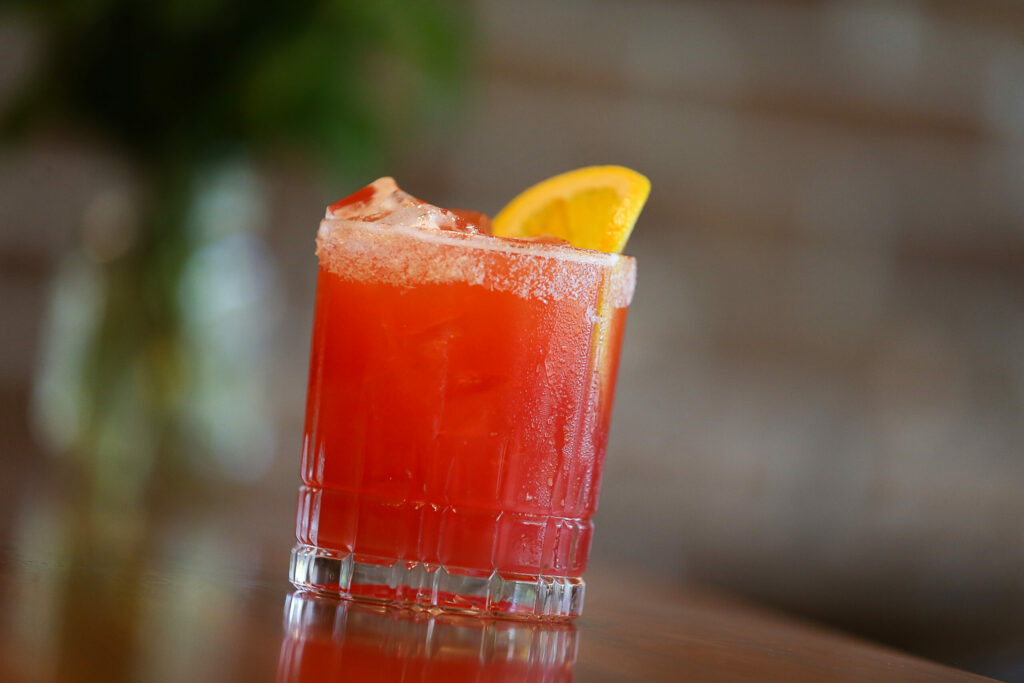
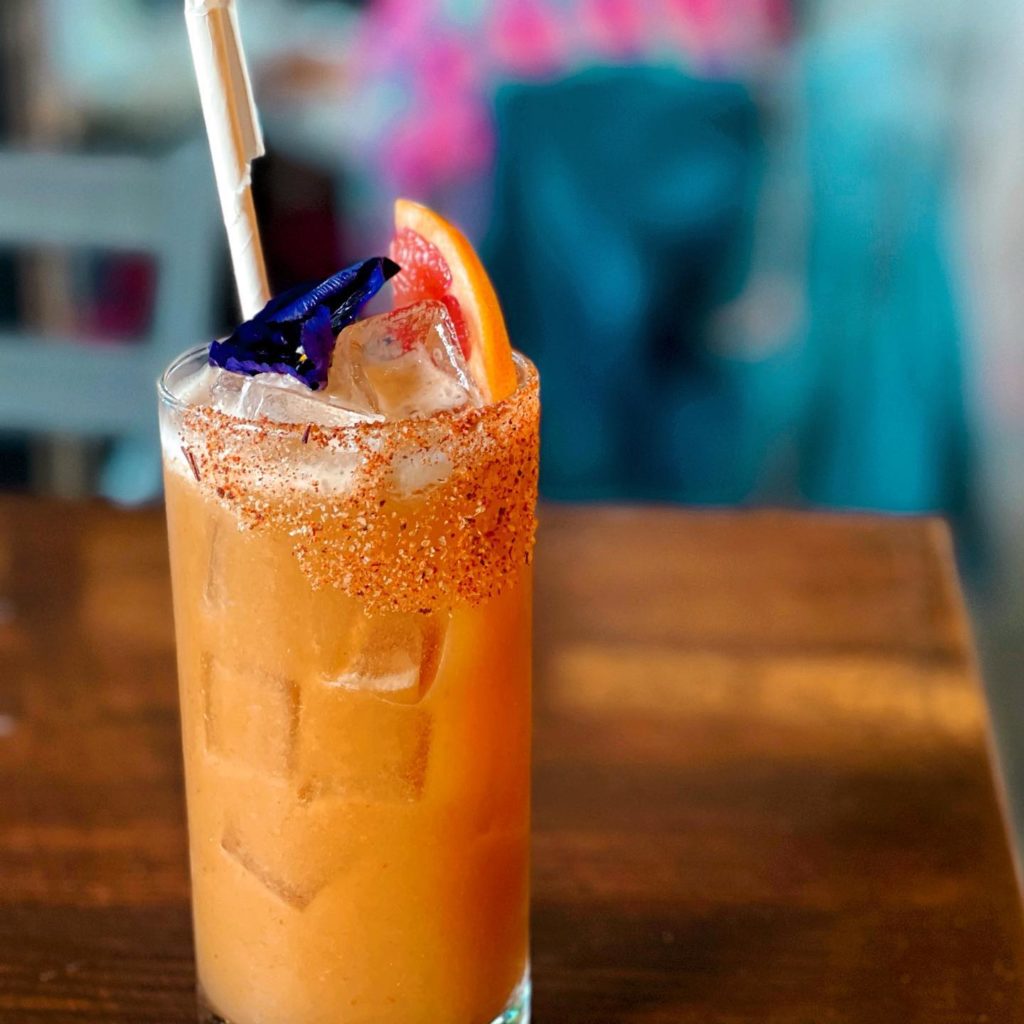

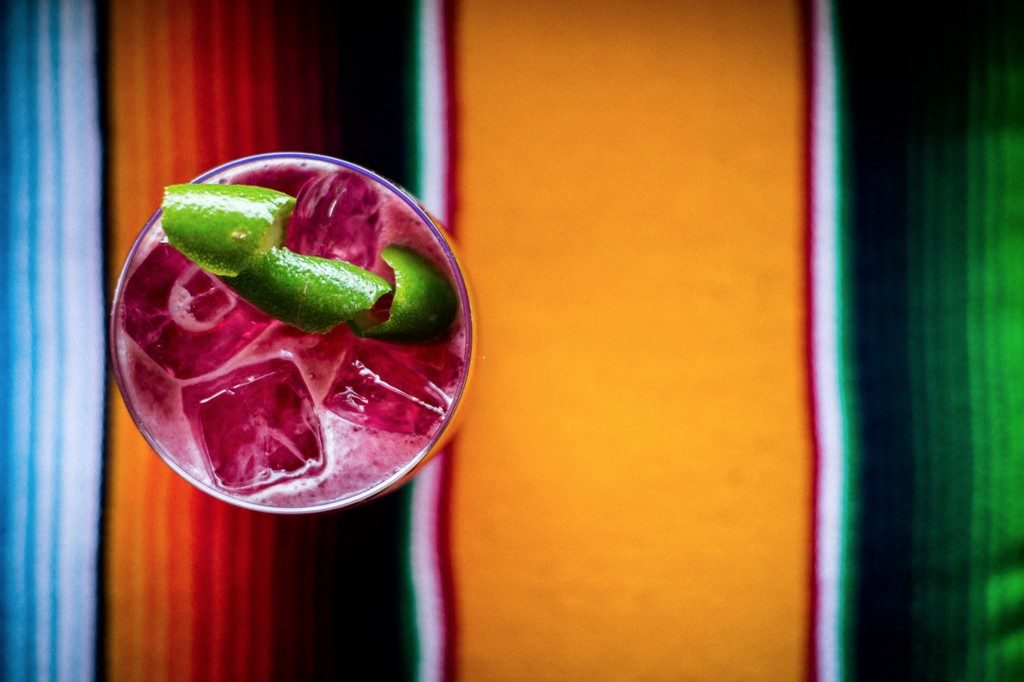
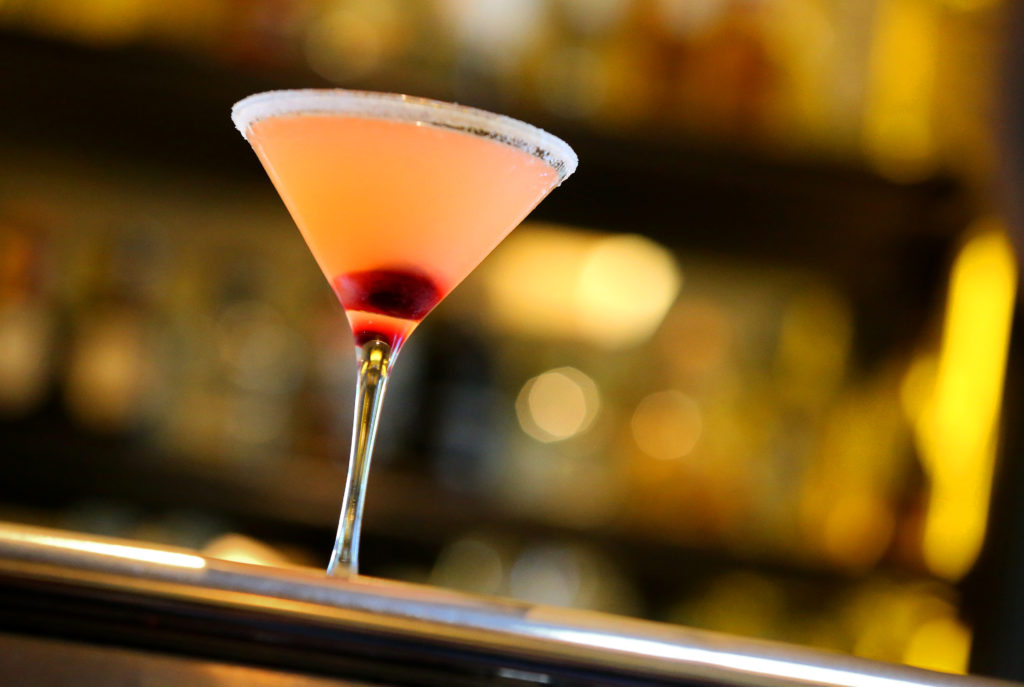

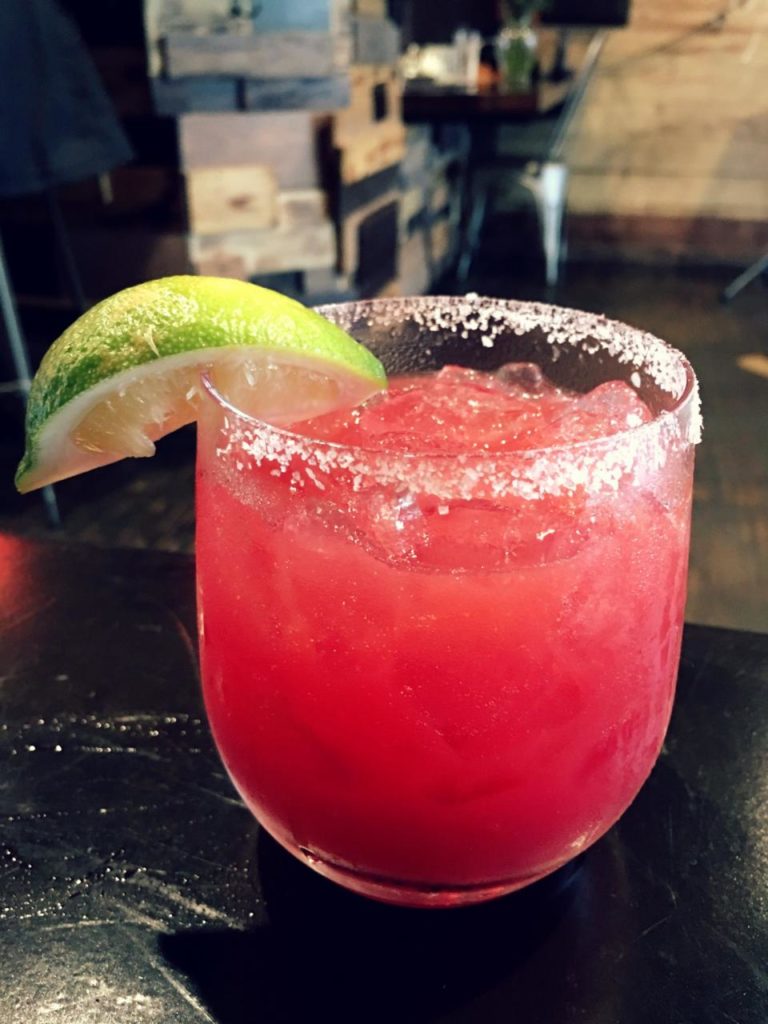

You don’t have to wait until Cinco de Mayo to enjoy the sweet, sour, salty, boozy taste of a well-made margarita.
Often hailed as the quintessential Mexican cocktail, the origins of the margarita remain debated — some claim it was invented in Tijuana in the 1930s while others say the first margarita was concocted by a Dallas socialite at her Acapulco vacation home in 1948.
No matter where it came from or how you like yours — frozen or on the rocks, with or without salt, flavor-infused or classic — Sonoma County serves up some marvelous margaritas. Here are our top picks.
La Rosa Tequileria & Grille, Santa Rosa: La Rosa’s La Diabla is a favorite margarita made with lime, strawberry (or other fruits, your choice) and muddled serrano chiles, served on the rocks. A little spicy, a little naughty. If heat isn’t your thing, try one of their 12 other margaritas, or keep it simple with a sip of tequila from the expansive bar, which features over 180 artisan tequilas and mezcals. 500 Fourth St., Santa Rosa, 707-523-3663, larosasantarosa.com
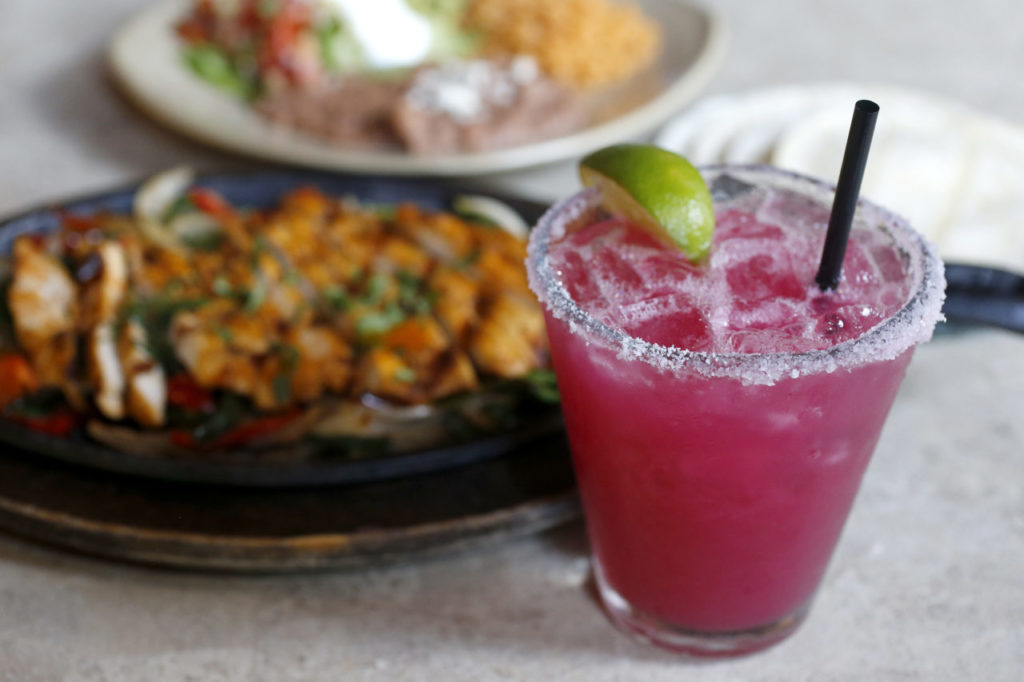
Paradise Sushi, Santa Rosa: Ignore the fact that they’re not made with real tequila, because this sweet little flight of margs is every bit as tasty. Pair with a couple of California rolls, and you’re in for a brilliant evening. 119 Fourth St., Santa Rosa, paradisesushi.net
Lazeaway Club at the Flamingo Resort, Santa Rosa: Grab a poolside table and a fresh margarita and enjoy the “ode to idleness” vibe at the renovated resort. 2777 Fourth St., Santa Rosa, 707-510-4533, lazeawayclub.com
Sweet T’s, Santa Rosa: The secret to the Texas Margarita? Pineapple and a kick of cayenne pepper. But oh, how sweet it is. 9098 Brooks Road South, Windsor, 707-687-5185, sweettssouthern.com
Ricardo’s Bar & Grill, Santa Rosa: A popular hangout for Bennett Valley residents, Ricardo’s serves up tasty martinis and a delicious house margarita that uses Sauza Blue tequila and is served on the rocks in a tall, skinny glass. Or go big with their top shelf — it’s worth the upgrade. Pair it with shrimp tacos from the secret menu and you’ll be more than satisfied. 2700 Yulupa Ave., Santa Rosa, 707-545-7696, ricardosbarandgrillca.com
Cascabel, Santa Rosa: Originally a tequila lounge based out of San Rafael, Cascabel opened a second location in Montgomery Village. They offer up plenty of delicious tequila-focused cocktails, with the Margarita de la Casa as number one on the list. 909 Village Court, Santa Rosa, 707-521-9444, cascabelbayarea.com

El Gallo Negro, Windsor: This Windsor restaurant and mezcaleria serves up Oaxacan-influenced dishes and a margarita for everyone with 11 festive options, including their house margarita, La Margarita, a Mezcal margarita, skinny margarita and the Mucho Caliente. 8465 Old Redwood Highway, Windsor, 707-838-9511, elgallonegro.net
Agave, Healdsburg: Agave offers one of the largest tequila selections in the county and hosts regular tastings. Order a house margarita or go big with La Reyna del Sur, which is made with Herradura silver tequila, fresh squeezed lime and Grand Marnier. Enjoy your margarita al fresco with chef Octavio Diaz’s mother’s speciality, traditional molé from Oaxaca. 1063 Vine St., Healdsburg, 707-433-2411, agavehealdsburg.com
Roof 106, Healdsburg: The Modern Margarita is a wonder of modern alchemy. This classic cocktail is crystal-clear, making for a sneaky drink that’s every bit as good as the original. Maybe better. 106 Matheson St., Healdsburg, 707-723-1106, thematheson.com
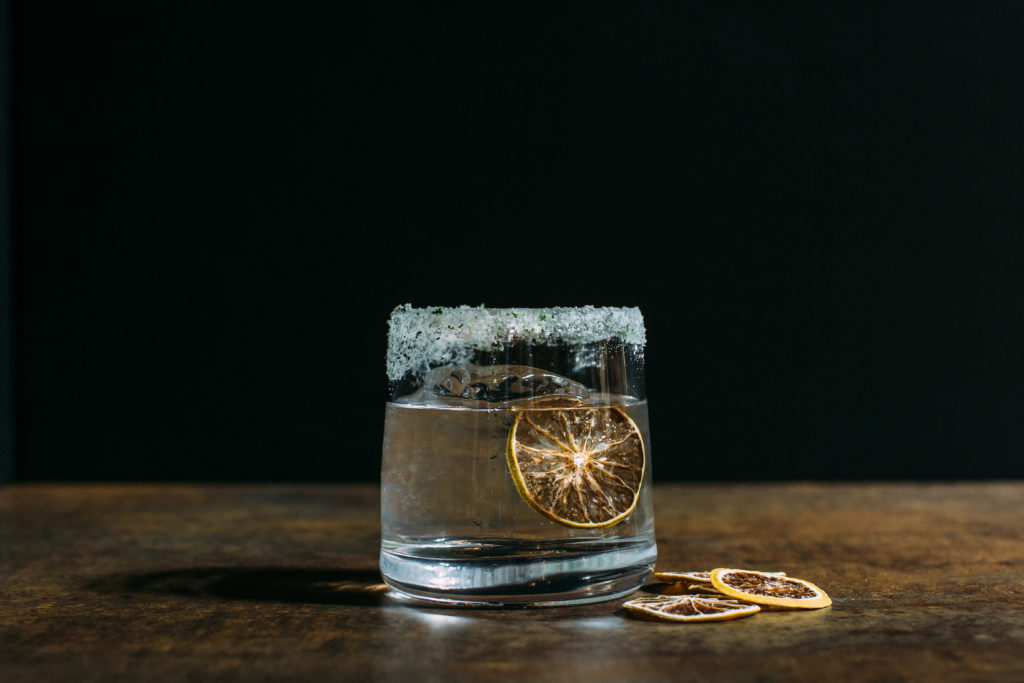
Maya Restaurant, Sonoma: Maya serves up contemporary Yucatan cuisine and the largest tequila selection in town. All of their margaritas use 100% Blue Weber Agave tequila and their house margarita is no joke — it packs a punch with silver tequila, orange liqueur, and fresh lemon and lime juice. For something a bit more fruity, try their pomegranate margarita. 101 E. Napa St., Sonoma, 707-935-3500, mayarestaurant.com
La Casa Restaurant, Sonoma: One of the oldest restaurants in Sonoma knows how to throw down the margaritas — they offer six types — many use recipes that date back to the restaurant’s 1967 opening. Try the Coat Rack, which uses Cazadores Reposado tequila, Cointreau and fresh squeezed lime, or order a house margarita during happy hour. 121 E. Spain St., Sonoma, 707-996-3406, lacasarestaurants.com
Taqueria La Hacienda, Sonoma: Sonoma locals flock to La Hacienda, not just for their hearty portions of Mexican food, which includes the best homemade molé in town, but also for their gigantic margaritas. Skip the house margarita and go top shelf with a blend of their famous margarita mix and El Jimador Tequila Blanco Triple Sec, topped with floats of Grand Marnier and Cointreau. They also serve a margarita using organic tequila. 17960 Sonoma Highway, Sonoma, 707-939-8226, lahaciendasonomabarandgrill.com
Oso Sonoma, Sonoma: Oso’s food is great and so are their cocktails. Pair Oso’s shrimp tacos with a blood orange margarita, which uses Sabé Teq, blood orange puree, lime, agave and salt. 9 E. Spain St., Sonoma, 707-931-6926, ososonoma.com
Mi Pueblo, Petaluma: Mi Pueblo, located in the heart Petaluma’s historic downtown, hosts a popular happy hour, with speciality margaritas, such as their jalapeño margarita. Local fans describe Mi Pueblo’s margaritas as being “the size of a mixing bowl” and therefore shareable for two — but would you really want to share your margarita? 108 Kentucky St., Petaluma, 707-769-9066, eatmipueblopetaluma.com
Plaza Tequila, Petaluma: Popular with happy hour enthusiasts, Plaza Tequila offers margarita lovers plenty of options to pair with their expansive menu. Treat yourself to a top shelf margarita, which is topped off with a float of Cointreau, and sit back and relax on their shaded patio. 600 E. Washington St., Petaluma, 707-776-4949, plazatequila.com
Mi Ranchito, Cotati: Mi Ranchito loves tequila so much they have their own tequila club. Their specialty margaritas run the gamut of colors, tastes and sizes. Try La Borracha, which is topped off with a mini-Corona beer or a refreshing cucumber margarita that uses Milagro silver tequila. 7600 Commerce Blvd., Cotati, 707-795-7600, miranchitocotati.com

El Barrio, Guerneville: One of the hottest spots in Guerneville, El Barrio pairs tequila and mezcal craft cocktails with small Mexican plates. USA Today calls their La Adelita margarita — made with Cebeza tequila, Cointreau, hibiscus, and lime — “sultry.” They also offer mezcal margaritas, like the El Barrio, which uses just a few simple ingredients: Fidencio mezcal, agave and lime juice. Order some Mexican deviled eggs and chill on the patio. 16230 Main St., Guerneville, 707-604-7601, elbarriobar.com
Underwood Bar and Grill, Graton: A popular hangout for locals, including winemakers and artists, Underwood offers a top notch craft cocktail program, which of course includes a margarita. Their Mercury Margarita uses Herradura Blanco tequila, Grand Marnier, Cointreau, house-made sweet & sour, and fresh orange juice. It’s a perfect match with their signature grilled hamburger. 9113 Graton Road, Graton, 707-823-7023, underwoodgraton.com
El Coronel Mexican Restaurant, Sebastopol: This family-friendly establishment, with an outdoor patio, makes for a great spot to enjoy one of nine speciality margaritas — especially if you love a more fruity twist. Their Pink Cadillac margarita stars Chambord, giving it a distinct raspberry flavor, and the Georgia Peach features peach Schnapps. 1015 Gravenstein Highway S., Sebastopol, 707-829-7010, elcoronelrestaurant.com
Rocker Oysterfeller’s, Valley Ford: This Valley Ford saloon offers contemporary twists on classics, including the margarita, which comprises fresh lime, Arette tequila, Patron Citronage and agave. Enjoy it with their beer-battered fish tacos, served with apple-fennel slaw and a spicy remoulade sauce. Too many margaritas? Sleep it off at their onsite hotel. 14415 Highway 1, Valley Ford, 707-876-1983, rockeroysterfellers.com
Heather Irwin and Sarah Stierch contributed to this article.
The post Where to Get the Best Margaritas in Sonoma County appeared first on Sonoma Magazine.
]]>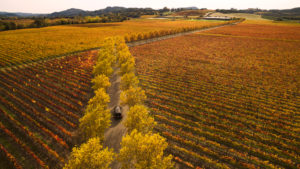
Visitors and locals will love this four-day itinerary featuring some of the best restaurants, wineries and activities Sonoma County has to offer.
The post Holiday Guests Coming? Here Are 4 Perfect Sonoma County Day Trips appeared first on Sonoma Magazine.
]]>









When you live in Sonoma County, you’re never lonely for out-of-town visitors. Family, friends, college roommates, even casual acquaintances are all eager to catch up with you and take in all that the region offers.
Now through New Year’s is high season for house guests, with the number of invading out-of-towners larger than the kids’ gift lists. For local hosts, it can be a challenge deciding where to take restless visitors, especially those on a budget. Farm-to-table restaurants and taquerias are a given. Winery tasting rooms? Natch.
Go any direction in Sonoma County, and you will wind up somewhere intriguing. You’re never far from good food, natural beauty and wine tasting. But with so many choices, we’ve creamed off a few foolproof excursions that will fill up a day and make your guests’ stay in Sonoma County more memorable.
Click through the gallery for a four-day itinerary that includes some not-so-obvious explorations of Sonoma County, guaranteed to please your guests as much as you.
Meg McConahey contributed to this article.
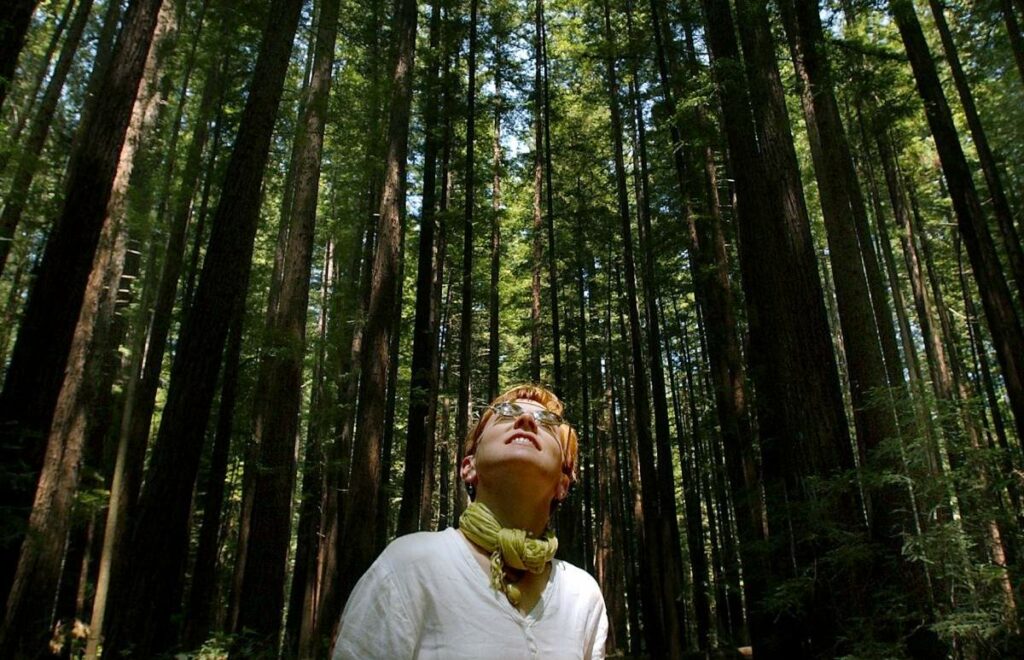
Day 1: Into the Armstrong Woods and to the coast
Armstrong Redwoods State Natural Reserve in Guerneville is a great place to introduce visitors to the natural superlatives of Sonoma County. Magnificent, 1,200-year-old Sequoia sempervirens, commonly known as coastal redwoods, tower in a way that makes humans feel very small and very serene. Redwoods are among the natural wonders of the world and among the planet’s oldest living organisms. And they’re an easy drive from anywhere in the county.
The Armstrong reserve features a 1½-mile, ADA-accessible trail, making this an easy outdoors experience for everyone in your group. Arrive early and with jackets to combat the marine chill. At 7:45 a.m., you’ll find an empty parking lot and the quiet woods, sans Segways and smartphone selfie-taking hordes. By contrast, visitors to Marin’s Muir Woods have to make a reservation.
After an hour among the gentle giants, depart as the parking lot begins to fill. Those arriving have had their breakfast, so now it’s time for yours. Coffee Bazaar in Guerneville provides house-roasted coffee and pastries. Or drive a little farther west, along the Russian River, to Duncans Mills’ Gold Coast Coffee and Bakery.
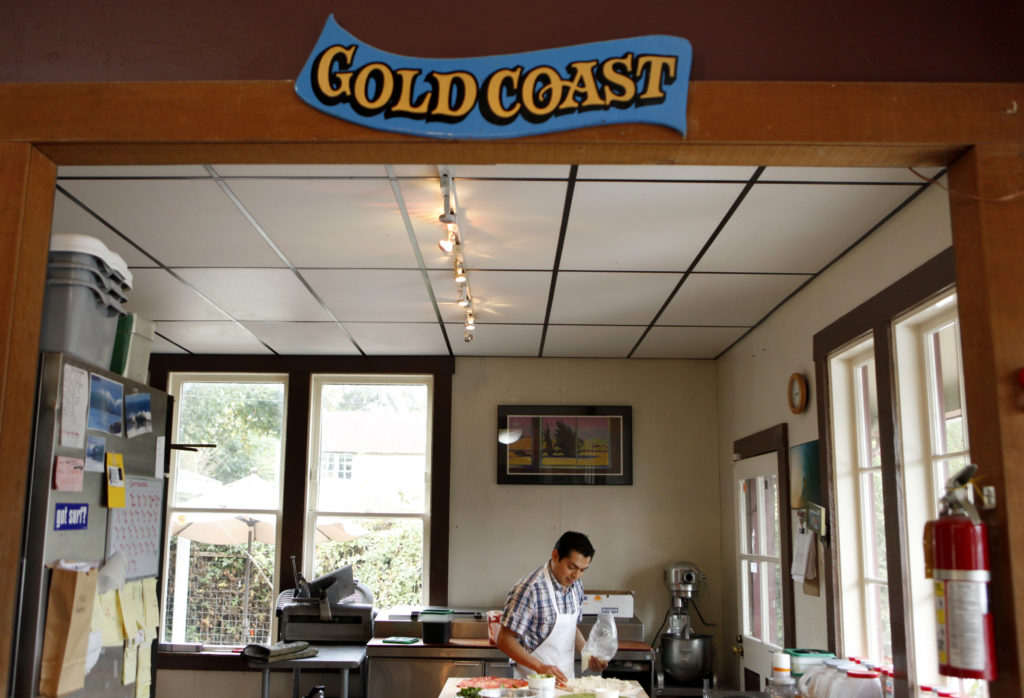
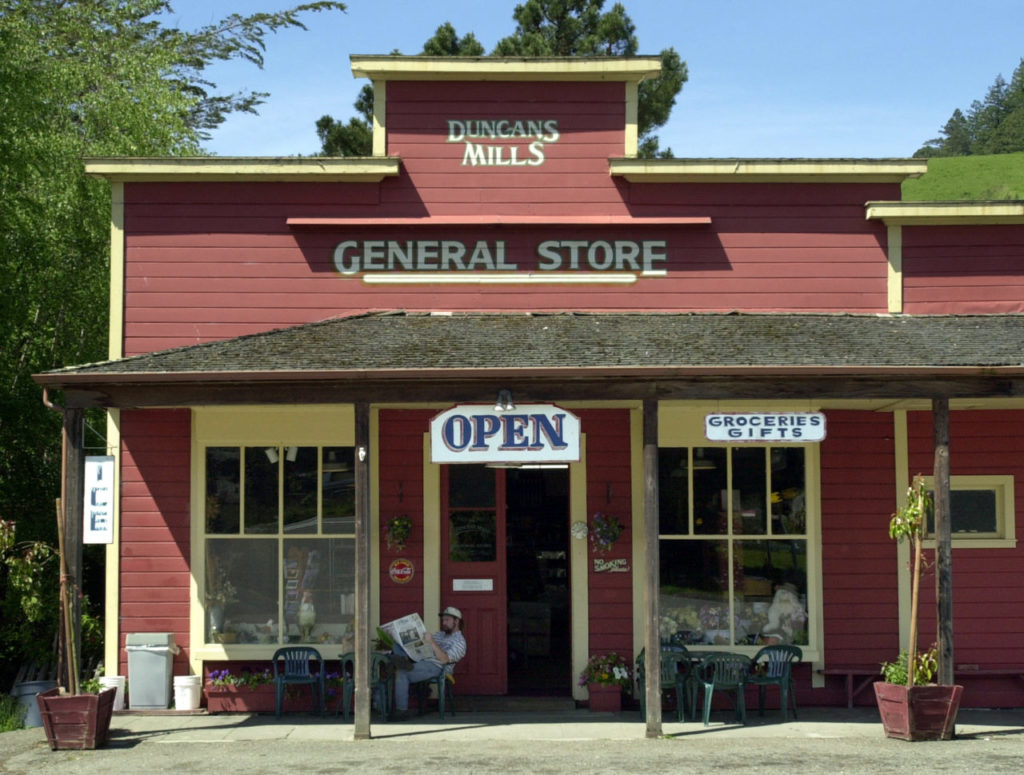
Founded in 1877, Duncans Mills is a quaint station on the way to the coast from the river towns, with a charming general store and a depot museum next to where the Northwestern Pacific Railroad once ran. If you still have Christmas shopping to do, then Duncans Mills is a good place to browse. Don’t miss Jim Raidl’s Jim and Willies, a real curiosity shop of quirky antiques and curios with a friendly proprietor.
On the road again, continue west. For some sea air and wide-open ocean views to amaze visitors from land-locked places, stop at the Vista Trail in Jenner at the mouth of the Russian River. If you’re lucky, you’ll spot some harbor seals.
After watching waves crash in the fresh sea air, you’ll be ready for the drive south on Highway 1 to Bodega Bay. This is the classic Sonoma Coast scene of crashing waves, and trails along the bluff are accessible to most people. Check out the whimsical wind spinners at Candy & Kites, the colorful array of saltwater taffy at Patrick’s and the Japanese prints at Ren Brown Collection Fine Art Gallery.
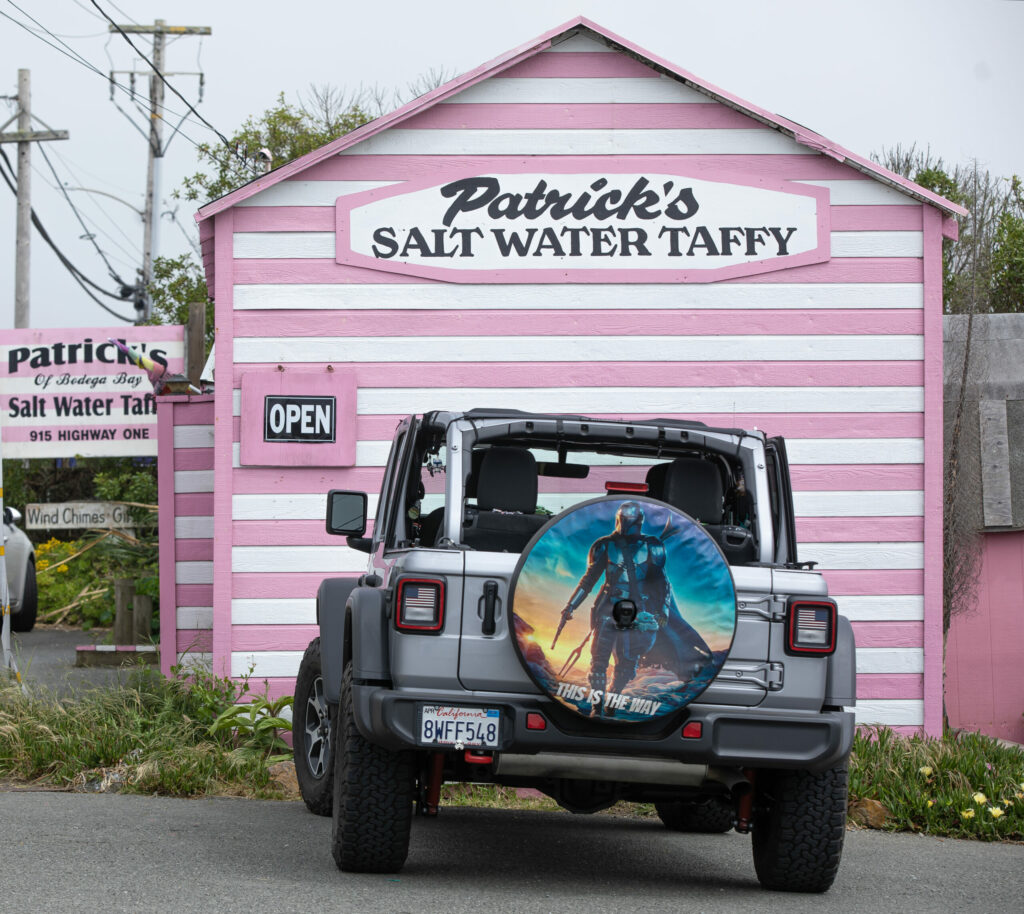
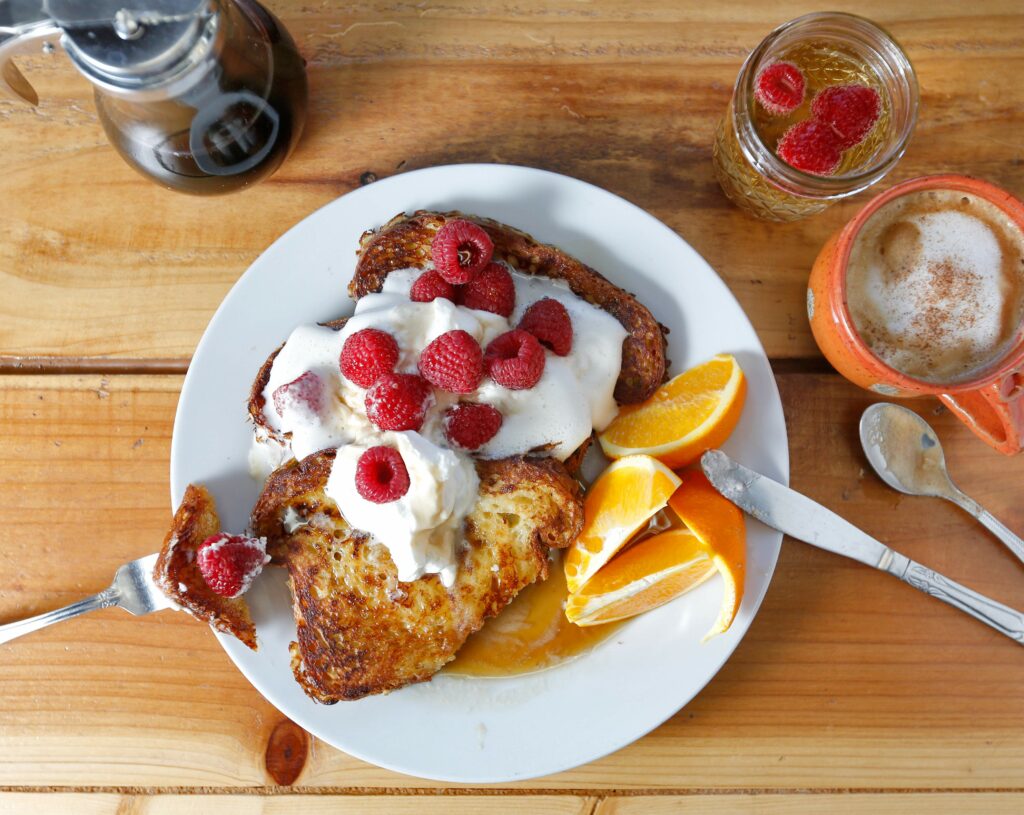
Start heading inland for a hit of Alfred Hitchcock in the tiny town of Bodega. Snap a “The Birds” selfie outside the old Potter School, immortalized in the scene where schoolchildren run screaming and flailing from their classroom. It’s a private residence, so stay on the road. Then swing by the nearby Saint Teresa of Avila Church, also featured in the film.
You’ll be hungry by now. For lunch, consider the Estero Cafe in Valley Ford just a few minutes’ drive away. The restaurant pays homage to local farmers with its hand-lettered chalkboard menus and homestyle food. Its inventive brunches, sandwiches and salads make it one of the county’s top foodie destinations.
Day 2: Healdsburg for the holidays
Start your day by taking in one of the most spectacular gems of Sonoma County — Lake Sonoma. Then head to Healdsburg (a 10-minute drive) for a leisurely breakfast at Costeaux French Bakery.
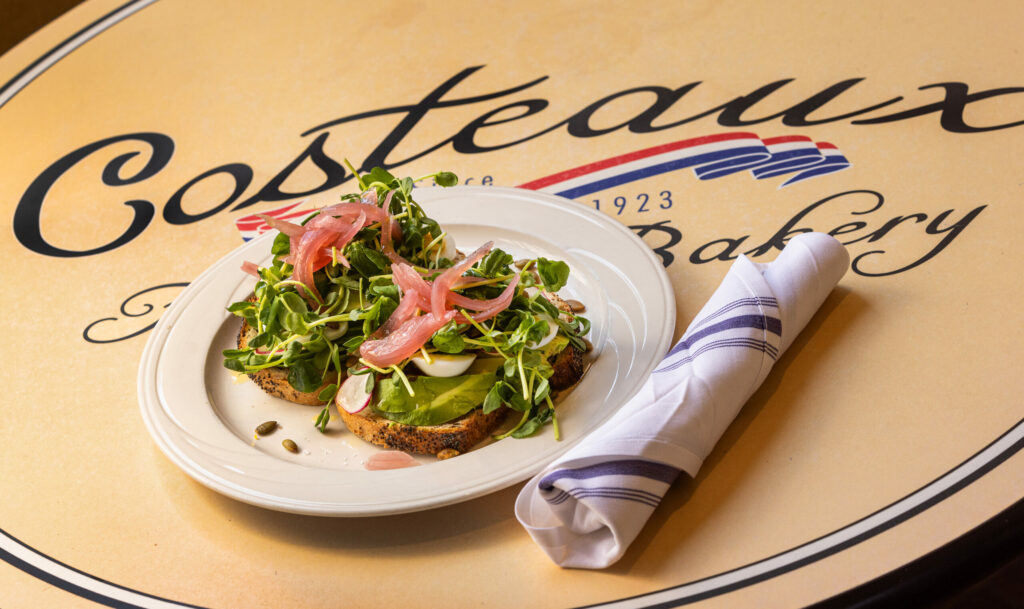
Costeaux French Bakery is a frequent winner in baking competitions, and its fresh breads are served in Sonoma restaurants. But not many people know that Costeaux serves great breakfasts and lunches.
After breakfast, let the bookworms and audiophiles in the group browse the fiction, vinyl and CD selection at Levin & Company. Take the stairs to the mezzanine for its collection of local art, jewelry and crafts. Next, visit the antique markets — like Shoffeitt’s Off the Square and Antique Harvest — all within easy walking distance of the plaza.
No Healdsburg visit is complete without a winery stop, or two. Lambert Bridge boasts a tasting room with a large fireplace, making it a cozy place for sipping wines in colder months. The Healdsburg Bubble Bar, nestled in a quaint 1906 Queen Anne Victorian near the plaza, offers a wide assortment of sparkling wines.
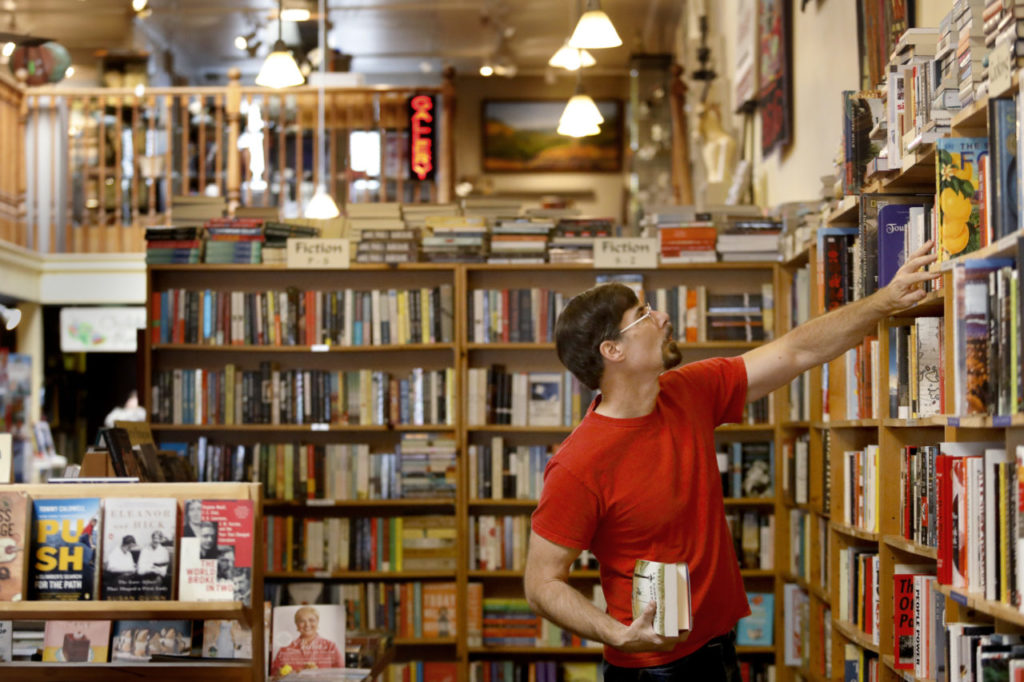
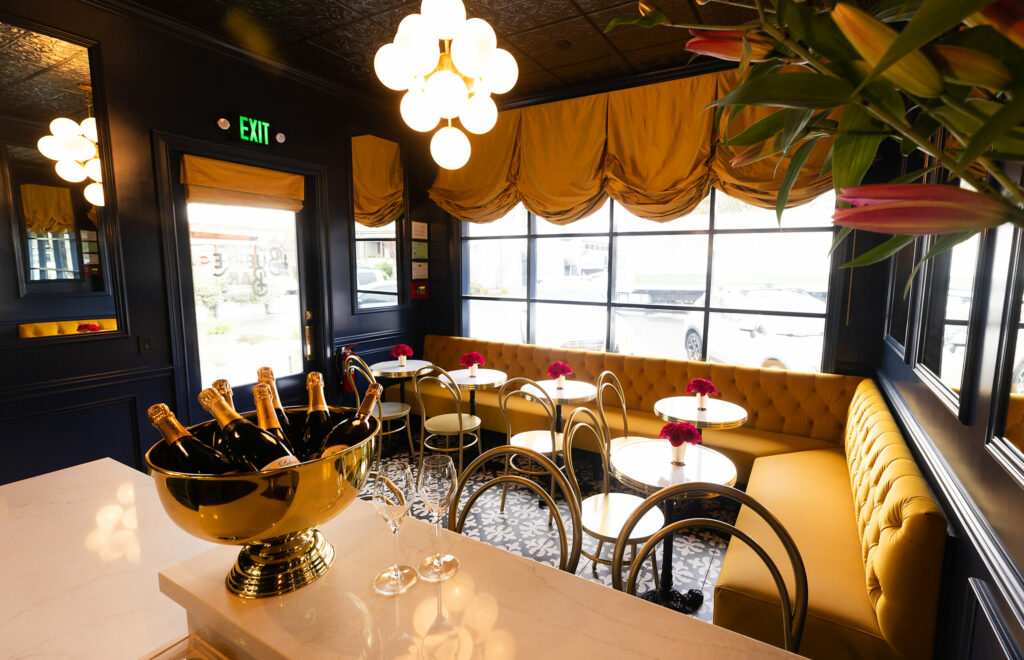
As the sun goes down, head to Barndiva for a craft cocktail and dinner, and watch the outdoor lights twinkle over the quirky art on the patio. Don’t miss the eclectic collection of British Cigarette Cards at the Gallery Bar.
Day 3: In search of lost time, and more wine, in Sonoma Valley
Winter is a good time to check out the new museum exhibit in Jack London State Historic Park. Even if it’s too cold or wet to hike, you can take cover in the House of Happy Walls museum dedicated to the great writer and his wife, Charmian.
Right outside the park gate, Benziger Family Winery offers vineyard tram tours that will get you out of the tasting room and among the vines, which have their own sculpted beauty in winter.

Make it an outdoorsy day at Sonoma Botanical Garden, one of Sonoma County’s secret spots. Few travel writers have discovered it, meaning you may have this 20-acre garden of rare Asian plants all to yourself. Easy paths wind past ponds and through dense plantings of trees and shrubs with something of interest in every season. There is a nice gift shop for garden lovers as well as golf cart tours by arrangement for those with mobility problems.
In the town of Sonoma, the walkable square offers places to sip, shop and dine. For celebratory sparkles during the holidays, there’s SIGH Champagne bar. No reservations needed, and they always offer three flights of French, Californian and other tantalizing sparklers. If you have teetotalers or beer drinkers in your party, this is a great tasting room option. They also offer draft beer, regular wine and non-alcoholic beverages, as well as snack-sized bites, both savory and sweet.
Sonoma Plaza offers holiday cheer and attractions for history buffs, from the Sonoma Mission to the barracks and Toscano Hotel, all within two blocks. There’s a big parking lot behind the barracks on First Street East.
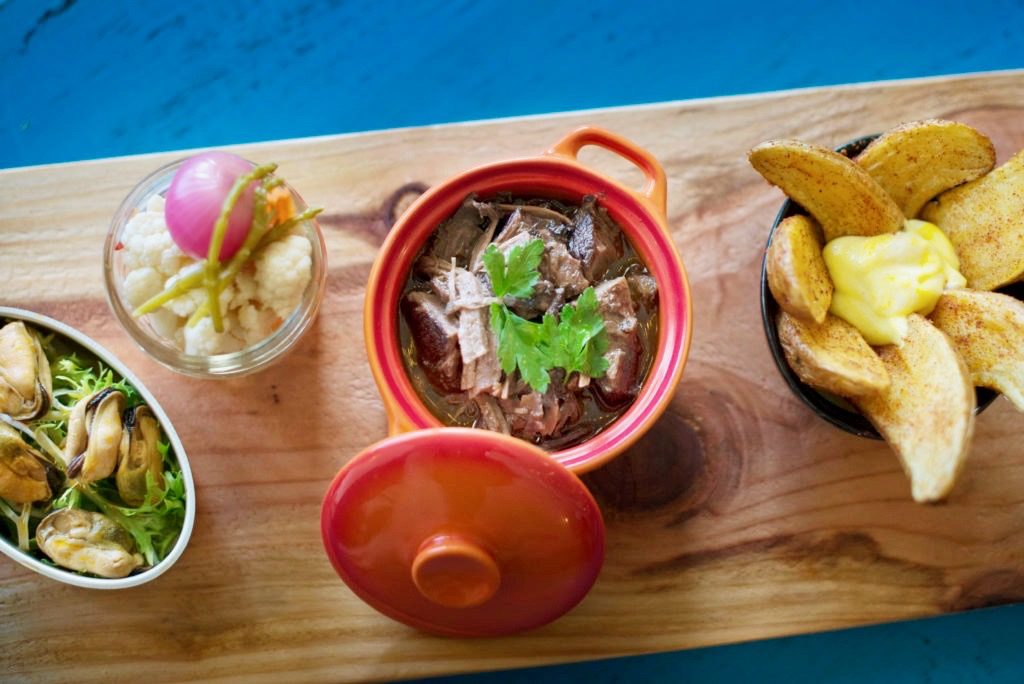
When you’re ready for a bite to eat, consider Tasca Tasca (TT Tapas). Tasca stands for tavern or pub in Portugal. Chef Manuel Azevedo offers updated Portuguese tapas with a fresh Sonoma spin. They’re also open late. Or head down Broadway to HopMonk Tavern for bar bites and beer, washed down with live music on the weekends.
Day 4: Petaluma, Sebastopol and a farm-to-table finale in Forestville
The age of Petaluma, settled in the 1850s, might not impress visitors from Europe, but the downtown’s quaint storefronts, heritage homes and retro memorabilia will make even your English uncle or Swedish aunt melt. But first, start with breakfast at Della Fattoria, one of the country’s finest bread bakers, famous for its Meyer lemon rosemary boule. Try the breakfast toast with ricotta cheese, banana slices, toasted pecans and honey.
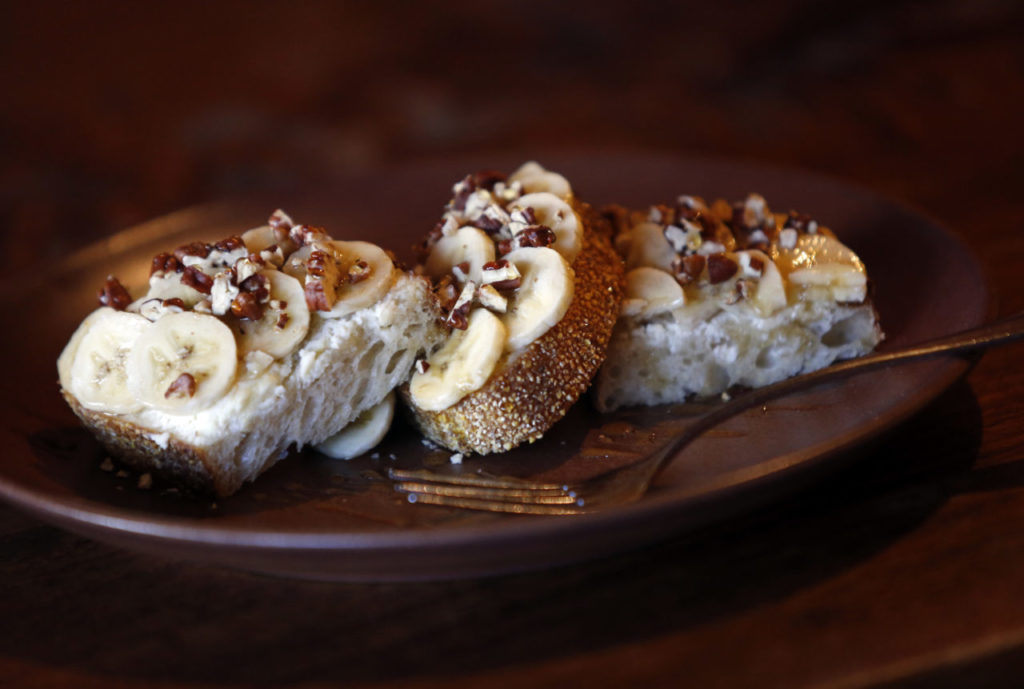
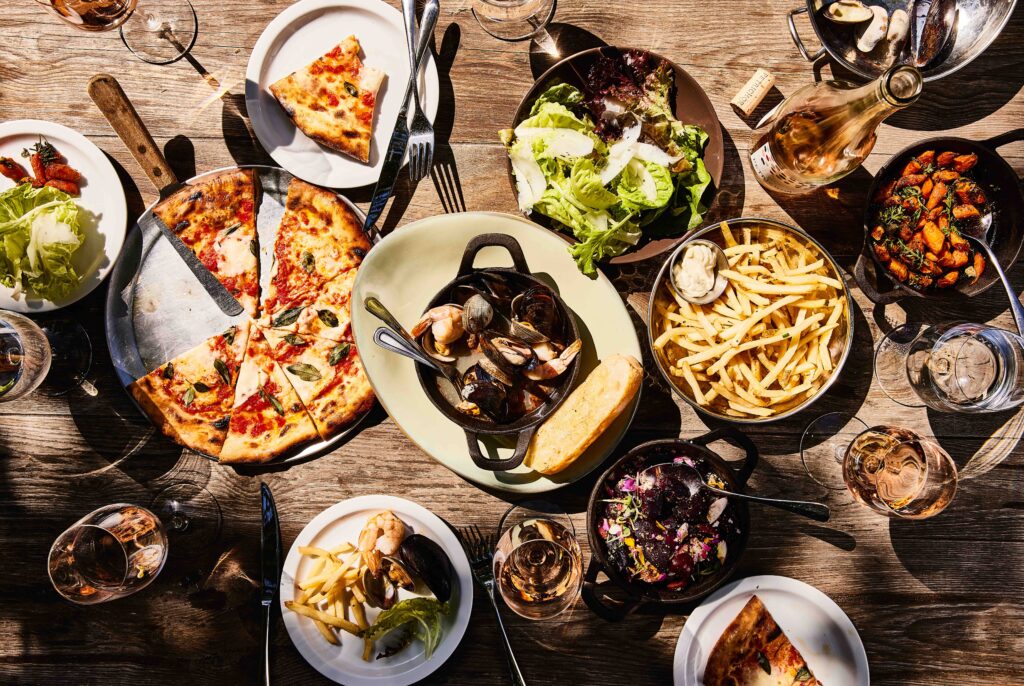
Downtown, check out the vintage guitars and mandolins at Tall Toad Music and the 1,800 varieties of heirloom seeds at The Seed Bank, owned by Baker Creek, one of the country’s leading purveyors of heirloom seed.
For the afternoon, get behind the wheel and drive the 17 miles to Sebastopol’s The Barlow. Designed to look like old farm industrial buildings — without the dirt and rust — this marketplace is good for browsing. Watch local makers in action at restaurants, wineries, breweries and cideries, and art, jewelry, glass, crafts, design and clothing studios.
If you want to arrange for a farm-to-table grand finale, you could make reservations at Farmhouse Inn’s upscale but surprisingly low-key Michelin-starred restaurant in Forestville. For a more affordable but still delicious option, Farmhouse Inn’s casual eatery Farmstand serves woodfired dishes and pizza.
The post Holiday Guests Coming? Here Are 4 Perfect Sonoma County Day Trips appeared first on Sonoma Magazine.
]]>
With over 400 wineries to choose from, it can be a bit overwhelming to plan a visit to Napa Valley. We're here to help.
The post The Best Napa Wineries for First-Time Visitors appeared first on Sonoma Magazine.
]]>









Napa Valley is widely considered one of the premier wine destinations in the world. Millions of people come here each year to sip wine, eat good food and stay in luxury resorts. But with over 400 wineries to choose from, it can be overwhelming to plan a first visit.
To help visitors create a perfect trip itinerary, we have put together this list of Napa wineries that offer a great introduction to the superlatives of the region. And, because the ambiance and setting is just as important as the wine, we have created a photo gallery above that offers a peek at each winery.
Domaine Carneros
Every visit to Napa Valley should begin with bubbles. Founded by the famed Taittinger family, Domaine Carneros produces French-style sparklers from sustainably grown estate vineyards. Take in the vineyard views from a table on the patio — you’ll feel like you’ve been transported to a French countryside chateau.
Tasting to try: Domaine Carneros’s “A Journey to Southeast Asia” pairs sparkling wines with a menu inspired by the cuisines of Vietnam, Thailand and India. It includes savory and sweet bites and four sparkling wines: Ultra Brut, Estate Brut Cuvée, Brut Rosé and Verméil Demi-Sec. $99 for a 90-minute experience.
1240 Duhig Road, Napa. 800-716- 2788. domainecarneros.com
Schramsberg
Founded in 1862, Schramsberg is one of the oldest sparkling wine producers in California. The historic property was purchased by Jack and Jamie Davies in 1965 and is now listed as a California Historical Landmark, complete with a Victorian mansion. Shortly after buying the winery, the Davies made their first vintage of Blanc de Blancs — the first commercial use of chardonnay in a sparkling wine made in the United States.
Tasting to try: The cave tour experience at Schramsberg is educational, starting with a tour of the historic property and caves followed by an all-sparkling wine tasting, or three Schramsberg sparkling wines and three red wines from sister winery, Davies Vineyards. Cave tastings start at $85. By appointment only.
1400 Schramsberg Road, Calistoga. 800-877-3623. schramsberg.com.
Artesa
Both locals and visitors to Wine Country tout the views and wine at Artesa, where the hillside tasting room and winery overlooks 350 acres of vineyards. Opened in 1991 by Spanish winemaking family Codorníu Raventós, the winery offers estate-grown Chardonnay and Pinot Noir crafted by winemaker Paula Borgo. (“Artesa” means “handcrafted” or “artisan” in Catalan.)
Tasting to try: After snapping selfies by the winery’s impressive entrance, enjoy the classic “Taste of Artesa” pairing of Ibérico ham and wine by the modern Mediterranean tasting bar, or on the patio, which offers 360-degree views — on a clear day you can see San Francisco. $105 per person. Reservations recommended.
1345 Henry Road, Napa. 707-224-1668. artesawinery.com
Ashes & Diamonds
Midcentury-modern design and excellent wines make this one of the hottest destinations in Wine Country. The winery has been featured in a variety of lifestyle publications, including Architectural Digest, Vogue and Goop, but tastings here remain relaxed and casual, and come with great music playlists curated by winery owner Kashy Khaledi.
Tasting to try: It’s hard to go wrong with pizza and wine. The “A&D Wines + Shroomy Schmaltzy” tasting features pizza with locally foraged wild mushrooms, aged mozzarella and crème fraîche paired with three wines. Yum! $45 per person. Reservations required.
4130 Howard Lane, Napa. 707-666-4777. ashesdiamonds.com
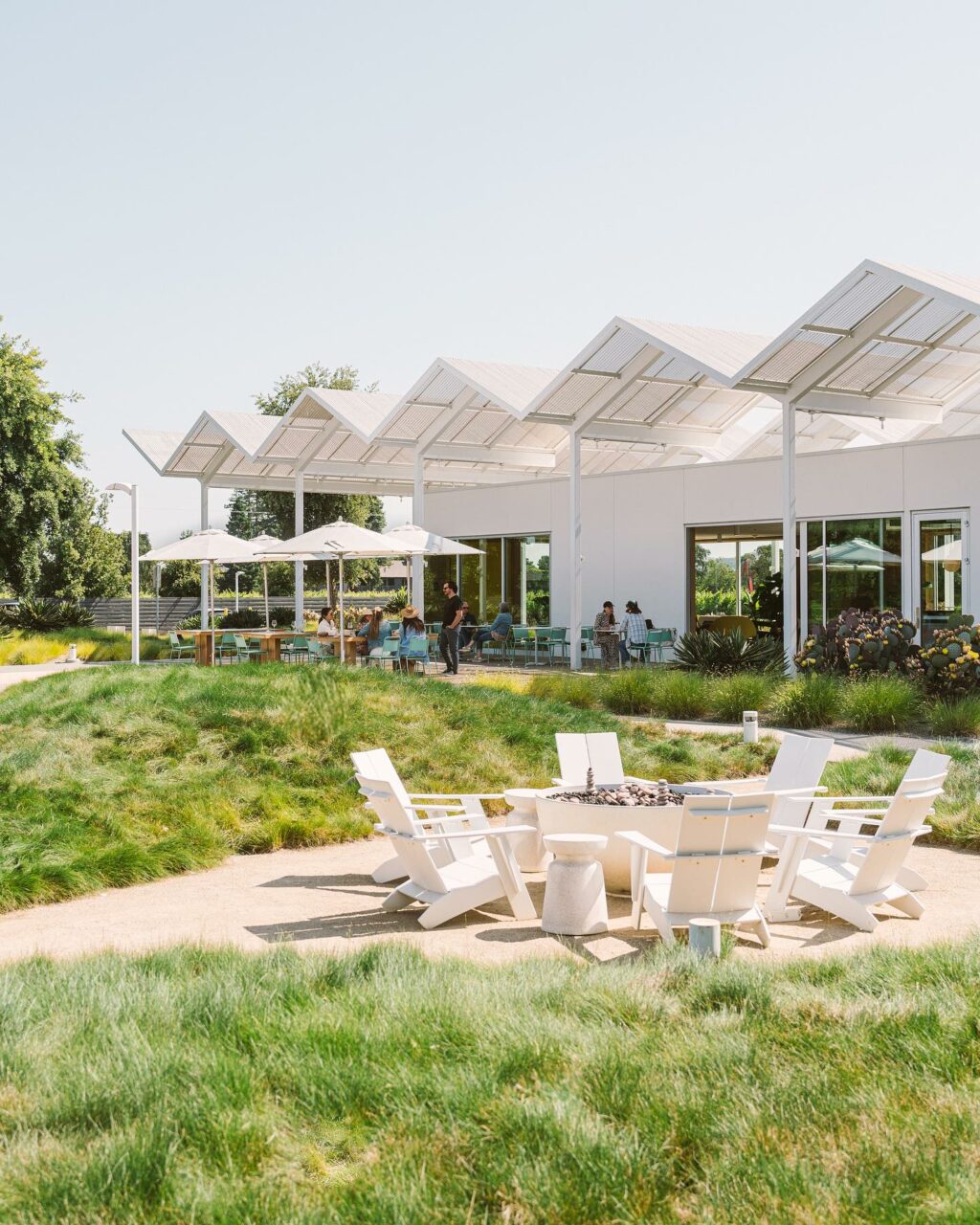
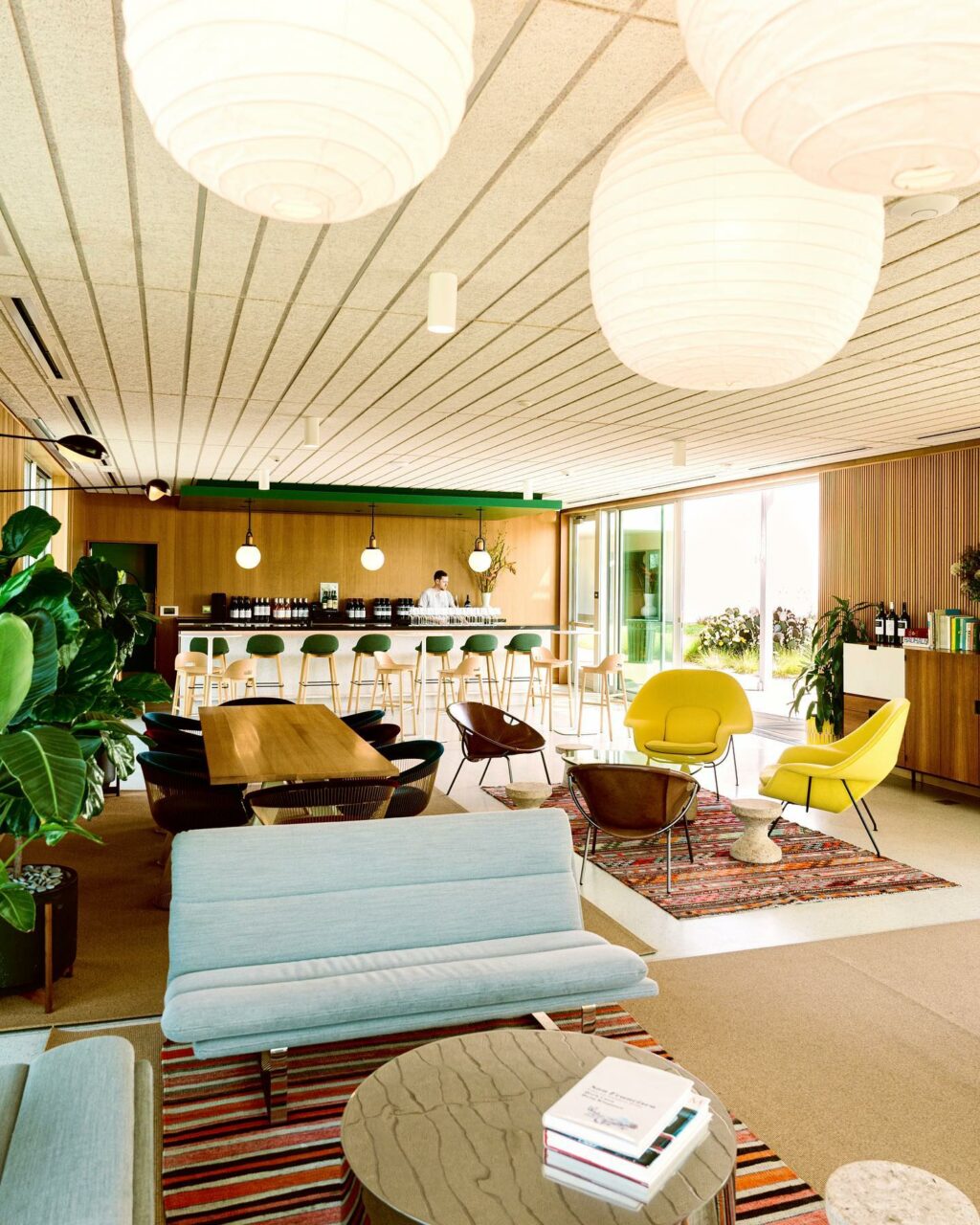
Beaulieu Vineyard
“Beau lieu” means “beautiful place” in French, which was an apt name for this Rutherford property thought the de Latour family when they bought it in the early 20th century. One of the oldest wineries in California, Beaulieu Vineyard (or simply “BV”) is a must-visit for wine lovers seeking a touch of heritage with their estate Cabernet.
Tasting to try: The reservation-only “Legacy Experience” starts with a tour of the winery followed by a tasting of a selection of reserve wines in the winery’s Legacy Room. $130 per person. Reservations recommended.
1960 St. Helena Hwy., Rutherford. 800-373-5896. bvwines.com
Beringer
The first winery to have both a red and a white wine named “Wine of the Year” by Wine Spectator, Beringer has been crafting wines for nearly 150 years, making it the oldest continually operating winery in California. If that isn’t enough to convince you to visit, the gardens and the stately Victorian-era tasting rooms, housed in the Beringer family’s former home — the Rhine House — should seal the deal.
Tasting to try: The “Legacy Cave Tour” winds through the old winery and into the cave to explore the hand-carved tunnels. The tour includes a tasting of three wines. $35 per person. Reservations recommended
2000 Main St., St. Helena. 707-257-5771. beringer.com
Castello di Amorosa
It’s no surprise that some refer to Dario Sattui, a fourth generation vintner and the man behind Castello di Amorosa, as a modern-day Don Quixote. Sattui spent 15 years building this medieval-style Tuscan castle in Napa Valley as a place to showcase his wines. The result: a 107-room, eight-level, 136,000-square-foot building complete with drawbridge, secret passageways, torture chamber — and tasting rooms.
Tasting to try: The “Diamond Estate Tour” includes a guided tour of the castle and its production area, followed by a tasting of five current-release reserve and small-production wines. $75 per person. Reservations required. Adults only.
4045 St. Helena Highway, Calistoga. 707-967-6272. castellodiamorosa.com
Charles Krug
Charles Krug, an immigrant from the German state of Prussia and one of the pioneers of Napa Valley winemaking, founded this winery in St. Helena in 1861. Robert Mondavi, another winemaking legend, got his start here after he convinced his parents, Cesare and Rosa Mondavi, to purchase the historic winery in 1943. The winery has remained a Mondavi property for over 75 years and four generations.
Tasting to try: Charles Krug’s “Tour and Tasting” experience offers a taste of winemaking history and five signature, current release wines paired with a gourmet cheese and charcuterie board. $90 per person. Reservations required. Adults only.
2800 Main St., St. Helena. 707-967-2229. charleskrug.com
Chateau Montelena
We can thank this Calistoga winery, founded in 1882, for putting California wine on the international wine map. Yes, there once was a time when American wine was the laughingstock of France and its wine producing neighbors. But that all changed when Chateau Montelena’s 1973 Chardonnay won the famous Paris Tasting. Today, the winery continues to produce delicious and accessible wines, including their legendary Chardonnay and collectible Cabernet Sauvignon.
Tasting to try: The “Montelena Estate Collection” showcases the winery’s Estate Cabernet Sauvignon by offering a comparative tasting of four vintages. Don’t worry, you will get to taste the Chardonnay, too. Don’t leave the property without exploring its beautiful Chinese garden, lake and vineyards. $125 per person. Reservations required. Adults only.
1429 Tubbs Lane, Calistoga. 707-942-5105. montelena.com
Duckhorn
Wine lovers flock to Napa Valley for Cabernet Sauvignon, but on a first visit it is also worth seeking out Merlot. The best place to taste the resurgence of the ruby red is at Duckhorn Vineyards in St. Helena. Duckhorn Merlots have been named “wine of the year,” “Merlot of the year” and “just plain darn delicious” by a variety of publications, including Sonoma Magazine, so you don’t want to miss a taste while in Napa Valley.
Tasting to try: The unpretentious tasting room at Duckhorn is surrounded by beautiful gardens. Make a reservation on the veranda for the “Portfolio Tasting Experience” and enjoy five current-release wines: Paraduxx, Goldeneye, Migration, Decoy, Canvasback and Calera. Splurge on a cheese plate; it is a good excuse to linger. $65 per person. Reservations required. Adults only.
1000 Lodi Lane, St. Helena. 707-963-7108. duckhorn.com
Far Niente
Another Napa Valley landmark, Far Niente was founded in 1885 by John Benson, who made his money in the California gold rush. (Another fun fact: Benson’s uncle was famous American impressionist painter Winslow Homer.) The historic winery, surrounded by 13 acres of landscaped gardens, is located next to a hillside with 40,000 square feet of caves that age the winery’s award-winning Cabernet Sauvignon and Chardonnay.
Tasting to try: The 90-minute “Tour and Tasting” experience boasts a sweet ending — a tasting of the winery’s lauded late-harvest wine, Dulce. Don’t miss a chance to see the oldest bottle of wine in California, an 1886 Far Niente Sweet Muscat, which the winery proudly displays. $130 per person. By appointment only.
1350 Acacia Drive, Oakville. 707-944-2861, farniente.com
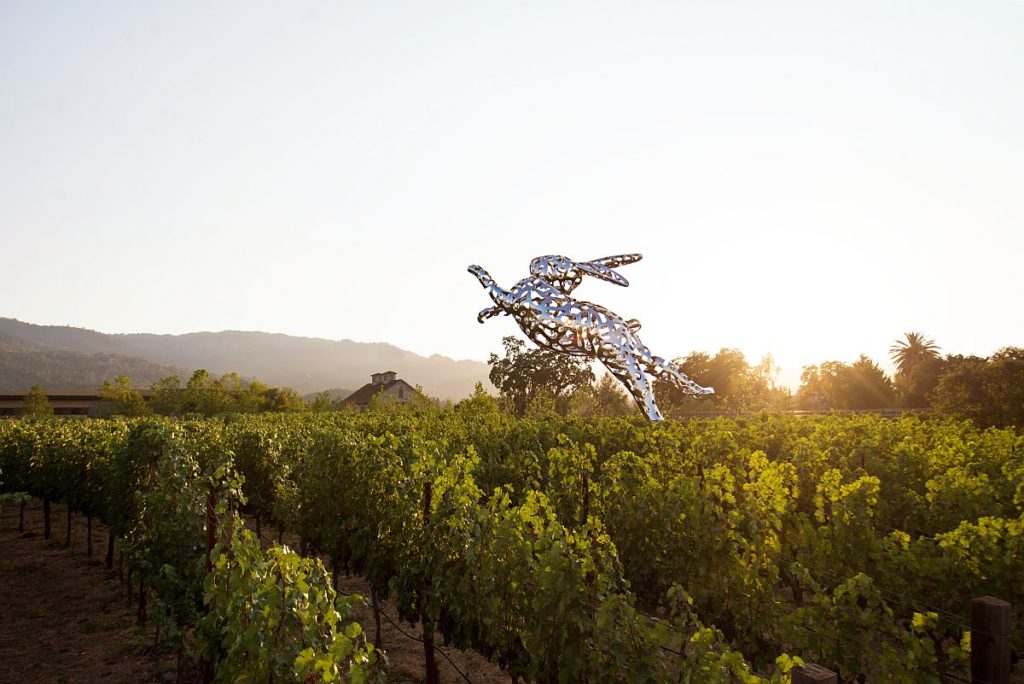
Hall Napa Valley
One of the best things about Napa Valley is the diversity of wine tasting experiences available here. One minute, you’re sipping sparkling wine in a 100-year-old wine cave; the next, you’re tasting bold red blends surrounded by contemporary art. At Hall, pair eco-friendly wines with fine art — the winery is the brainchild of Kathryn Walt Hall (philanthropist and former ambassador to Austria) and her husband, Craig.
Tasting to try: The “HALLmark Tour and Tasting” includes a tour of the innovative production facilities in St. Helena, which will impress any techie, as well as the organic gardens. Then, enjoy a seated tasting where you will nibble on cheese alongside a flight of four wines. And don’t forget to snap a selfie with the Bunny Foo-Foo sculpture outdoors. $75 per person. Reservations recommended.
401 St. Helena Highway, St. Helena. 707-967-2626. hallwines.com
Inglenook
Founded in 1879, Inglenook was the go-to wine for the American elite — including presidents — by the turn of the 20th century. Today, Inglenook wines are among the most collected in the country. The winery was purchased by filmmakers Francis Ford and Eleanor Coppola in 1975 with profits from The Godfather films. Dress up and charge your phone for pictures — the property looks like a movie set.
Tasting to try: During the “Private Library Tour and Tasting” explore the chateau and grounds, wine in hand. Then visit the caves, the vineyards and one of the oldest winemaking facilities in the country, with huge redwood barrels. End the experience with a seated tasting of library wines paired with artisan cheese. $150 per person. By appointment only.
1991 St Helena Highway, Rutherford. 707-968-1161. inglenook.com
Robert Mondavi Winery
One of Napa’s most well-known wineries has temporary downtown digs. Robert Mondavi Winery’s Arch & Tower has moved into the city’s historic Borreo building. (The space was formerly occupied by Stone Brewing Co.). Mondavi’s wine tasting experiences will take place at the downtown Napa location while the namesake winery property in Oakville undergoes a multi-year renovation.
Tasting to try: Robert Mondavi founded his namesake winery in 1966, planting Cabernet Sauvignon and Sauvignon Blanc. The “Napa Exploration” tasting introduces you to four Estates-tier wines. Snag a seat on the River Terrace and take in views of the Napa River while you sip and swirl. $65 per person. Reservations required.
930 Third St., Napa. 888-766-6328, robertmondaviwinery.com
Silver Oak Cellars
This Napa Valley winery was founded in 1972 by onetime Colorado oil prospector Raymond Twomey Duncan and winemaker Justin Meyer. Their goal: to make Cabernet Sauvignon aged exclusively in American white oak. Today, Silver Oak Cellars is operated by Twomey Duncan’s sons, David and Tim Duncan, who are committed to sustainable winemaking practices and operations and continue to focus on Cabernet from Napa Valley and Sonoma County’s Alexander Valley.
Tasting to try: The “Silver Tasting and Tour” allows visitors to observe the winemaking process from a glass-enclosed cellar while sipping cab in a modern tasting room built from hand-quarried limestone. Pinot lovers will enjoy the opportunity to taste bottles from Silver Oak’s sister property, Twomey. Tastings start at $65.
915 Oakville Cross Road, Oakville. 707-942-7022. silveroak.com
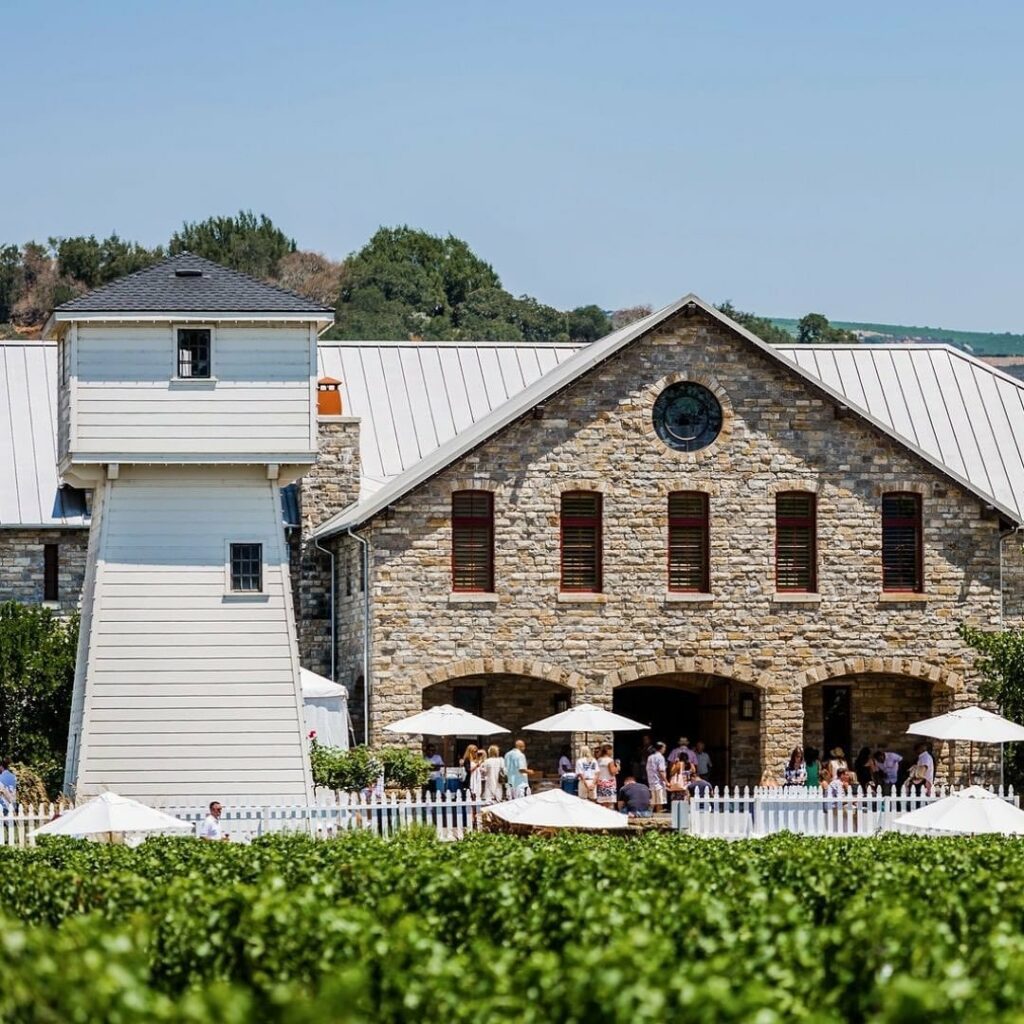
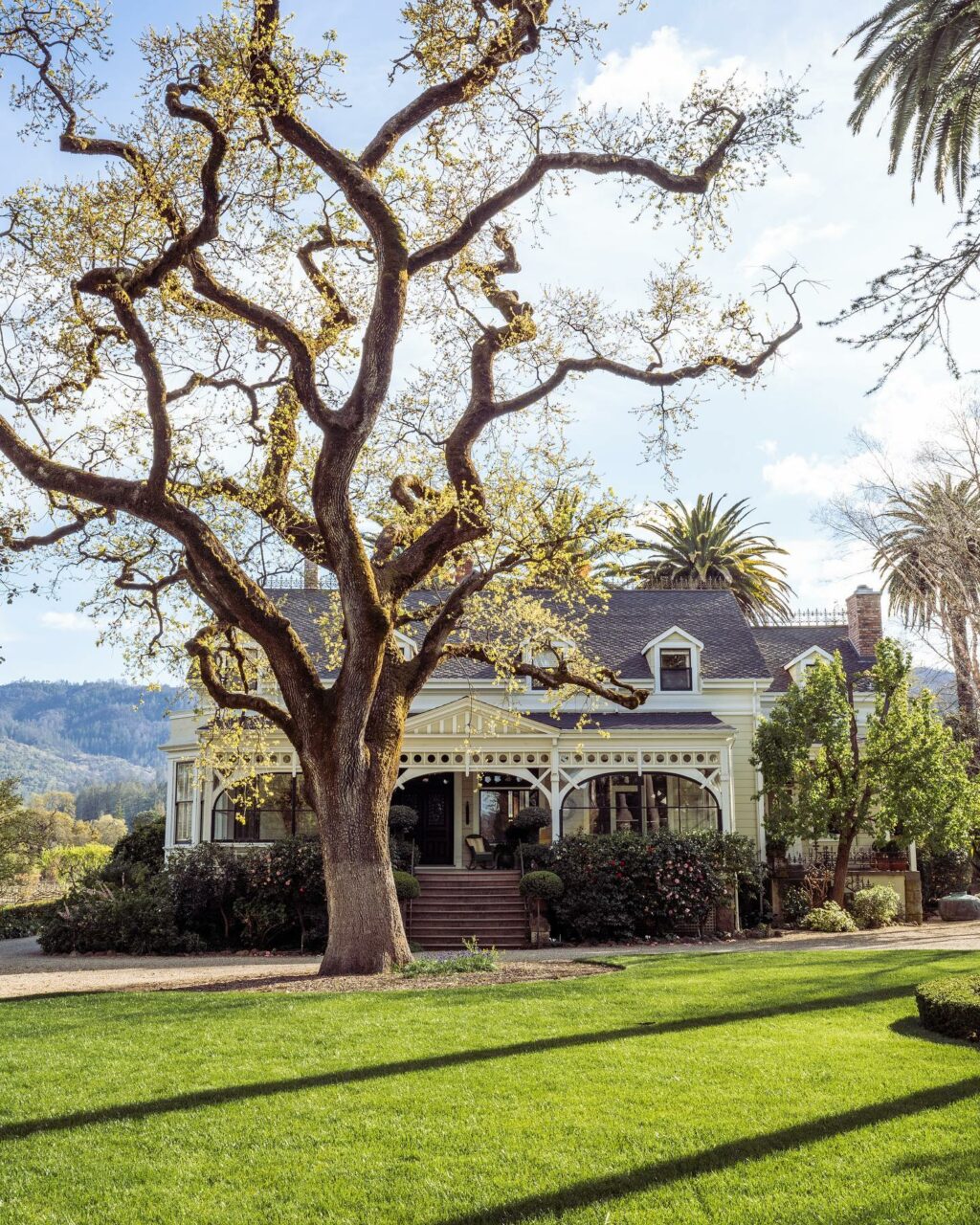
Spottswoode Winery
This family-owned and operated winery is setting the standard for sustainability in Napa Valley. In 1985, Spottswoode was the first in Napa Valley to farm organically. In 2020, the estate earned biodynamic certification and became the first Napa Valley winery to earn B Corp Certification. Most recently, Spottswoode added Regenerative Organic Certification to its long list of eco-friendly accomplishments.
Tasting to try: Private “Estate Tastings” are hosted by appointment Monday through Friday. After touring the estate and learning about the winery’s farming practices, you’ll enjoy a seated tasting of current-release Spottswoode wines. $150 per person.
1902 Madrona Ave., St. Helena. 707-963-0134, spottswoode.com
Tres Sabores
This family-owned, woman-led winery produces organically farmed wines in a postcard setting. Along with vineyards, owner and winemaker Julie Johnson tends to pomegranates, Meyer lemons, olives and more. A plus: leashed dogs are welcome with advance notice.
Tasting to try: Grab a seat on the sunny patio or at a shady picnic table and sip on five current releases while watching hummingbirds in the heirloom garden, sheep “mowing” in the vineyards, and red-tailed hawks soaring above. $60 per person. A locally-sourced cheese and charcuterie platter large enough for four can be reserved for an additional $28. Reservations required.
1620 South Whitehall Lane, St. Helena. 707-967-8027, tressabores.com
Dana Rebmann contributed to this article.
The post The Best Napa Wineries for First-Time Visitors appeared first on Sonoma Magazine.
]]>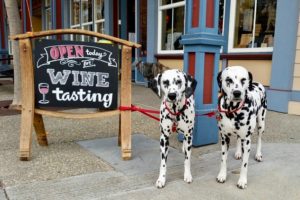
Get ready for Yappy Hour! These Sonoma County wineries welcome pooches and their wine-loving parents.
The post 30 Favorite Dog-Friendly Wineries in Sonoma County appeared first on Sonoma Magazine.
]]>









Sonoma County, with its many renowned vineyards, is a great place to enjoy a day of wine tasting. The region is also a great place for dogs and their owners, with an increasing number of parks, establishments and venues welcoming and catering to canine companions.
But just where should you go if you want to visit a winery while also spending time with your furry best friend? Fortunately, there are plenty of options in the county.
Scroll through our list below to see some of the best dog-friendly wineries in Sonoma County, and click through the above gallery for a peek at some favorites.
Sonoma
Gundlach Bundschu Winery
One of the oldest wineries in California welcomes on-leash dogs to their Rhinefarm. Pack a picnic and enjoy the patio, which overlooks the estate vineyards, or bring your dog into the historic tasting room, a pet-friendly pick for a rainy day. 2000 Denmark St., 707-938-5277, gunbun.com
Larson Family Winery
Larson Family Winery makes a dog-themed wine, Three Lab Cab, named after winery dogs Buster, Bubba and Pete. Dogs are welcome in the tasting room barn and on the lawn and picnic area, where you can play cornhole while your dog relaxes in the sun. 23355 Millerick Road, 707-938-3031, exploretock.com/larsonfamilywinery
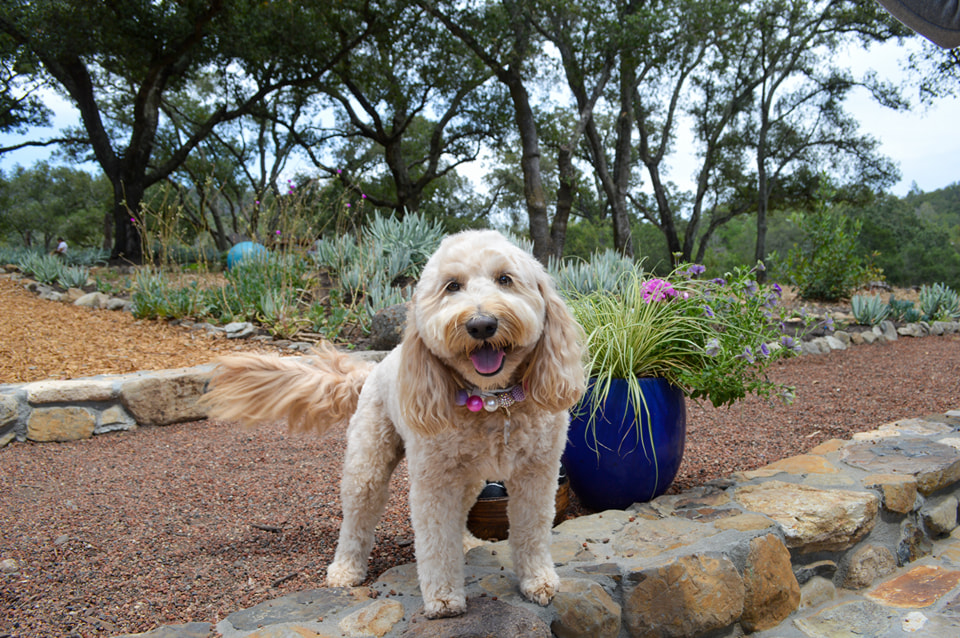
Bartholomew Estate Vineyards and Winery
Located within 375-acre Bartholomew Park in Sonoma Valley, the winery has a variety of great views and trails for humans and canines to enjoy. Leashes are required at all times. 1000 Vineyard Lane, 707-509-0540, bartholomewestate.com
Roche Winery
Watch the world go by, dog by your side, on the patio of this downtown tasting room, with a fire pit and trees providing shade. The tasting room offers barrel tastings, snacks and some of the best people-watching in town. 122 West Spain St., 707-935-7115, rochewinery.com
Glen Ellen
Abbot’s Passage Winery + Mercantile
Coming from a long lineage of winemakers that stretches back over a century and a half, vintner Katie Bundschu is making her distinctive mark with small-lot Rhône-style wines. Her winery is both family-friendly and dog-friendly. Dogs should be on a leash. 777 Madrone Road, 707-939-3017, abbotspassage.com
B.R. Cohn Winery
This Glen Ellen winery offers water bowls and treats for visiting dogs to enjoy. Leashed dogs are welcome on the winery patio and grounds, which include estate vineyards and views of Sonoma and the Mayacamas mountains. 15000 Sonoma Highway, 707-938-4064, brcohn.com
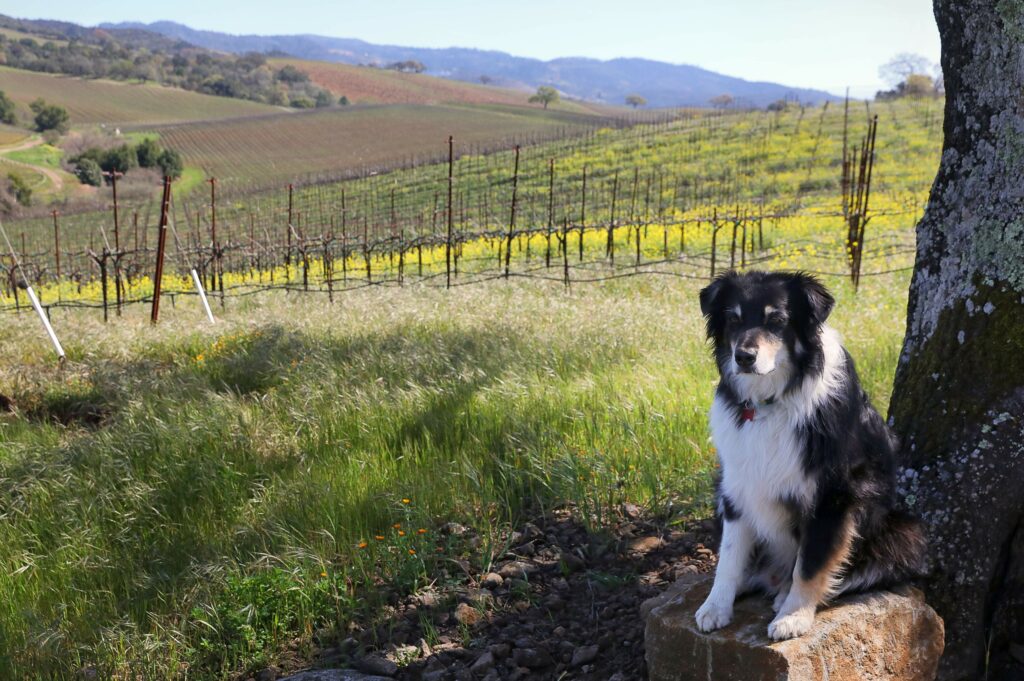
Kenwood
Deerfield Ranch Winery
“May All Fours Be With You” is the motto of Deerfield Ranch’s winery dog, Obi Wine Kenobi. Water is available for pooches, while dog owners can taste some of the wineries delectable vintages. 10200 Sonoma Highway, 707-833-5215, deerfieldranch.com
Kunde Family Winery
Fourth-generation winegrower Jeff Kunde invites dogs to accompany their owners on tastings and to join him on a hike through his family’s historic vineyards through oak woodlands, native grasslands and chaparral. 9825 Sonoma Highway, 707-833-5501, kunde.com
Landmark Vineyards
Welcome throughout the property, dogs are allowed to wander with their owners into the vineyard. Thirsty dogs get a taste of the royal treatment: Fiji water fresh from the bottle served in a bowl. 101 Adobe Canyon Road, 707-833-0053, landmarkwine.com
Muscardini Cellars
Winemaker Michael Muscardini’s golden retriever, Biondi, and staff welcome well-behaved dogs in the tasting room and on the patio and green rolling grounds behind the tasting room. Dogs can look forward to treats, water and toys as well as dog-themed events. 9380 Sonoma Highway, 707-933-9305, muscardinicellars.com
Healdsburg
Amista Vineyards
After taking a self-guided tour of the property with your dog, taste wine on the patio or in the tasting room featuring dog-themed art, while your pup enjoys dog biscuits. The winery hosts an annual fundraiser that benefits Canine Companions for Independence. 3320 Dry Creek Road, 707-431-9200, amistavineyards.com
Bacchus Landing
With a reputation of being “super” dog friendly, this collective of just over a half dozen boutique wineries is a hub of winemaking and tasting activity. Bacchus Landing is equally family-friendly with bocce courts and lawn games as well as a large open patio and five tasting rooms, among them Smith Story Wine Cellars and resident goldendoodle Lord Sandwich. 14210 Bacchus Landing Way, 707-395-0697, bacchuslanding.com
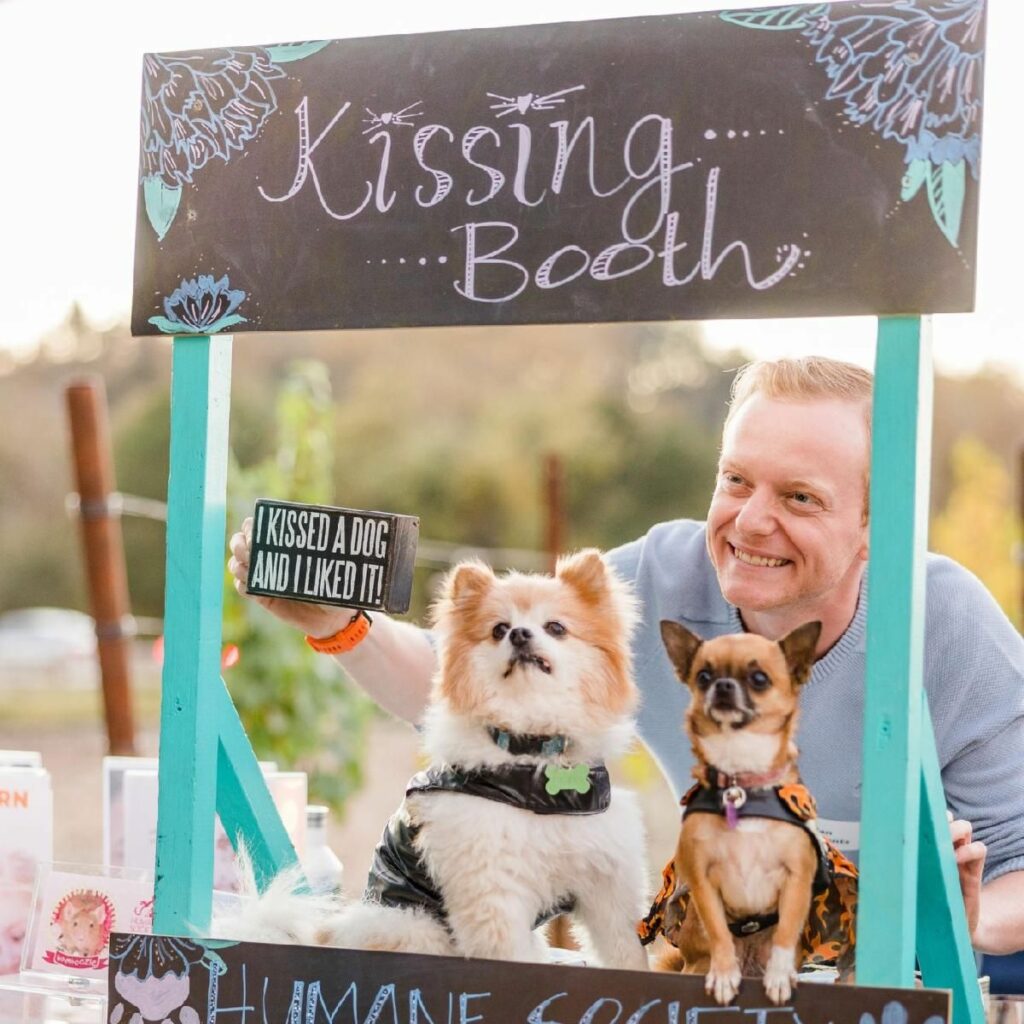
Breathless Wines
Guests can enjoy a flight of sparkling wines on the winery’s garden patio accompanied by their dogs. The winery also hosts fundraisers for Humane Society of Sonoma County. Out of courtesy for other visitors and staff, the winery requests that all animals are leashed and well-behaved. 499 Moore Lane, 707-395-7300, breathlesswines.com
Lambert Bridge Winery
This Healdsburg winery allows dogs to settle into a dog bed and relax with a bowl of water while owners try out the wines. After enjoying a tasting, wander through the estate gardens with your pup. 4085 W. Dry Creek Road, 707-431-9600, lambertbridge.com
Portalupi Wine
This winery’s downtown tasting room is a convenient stop along a dog walk. The family is a supporter of the local Humane Society and donates proceeds from their wine sales to the nonprofit. 107 North St., 707-395-0960, portalupiwine.com
West Wines
The winery, with a tasting room below a large oak with views of the vineyards, invites guests to enjoy a tasting on the dog-friendly patio. West Wines’ Instagram account features an assortment of photos of some of its canine visitors as well as its “winery cat extraordinaire” Jane Bond. 1000 Dry Creek Road, 707-433-2066, westwines.com
Wilson Winery
The Wilsons make a dog-themed wine, Three Dog Zin, which features the family’s three dogs, Molly, Sydney and Victoria. The staff welcomes dogs, offering pups treats and water, while humans sip zinfandel in the tasting room or on the patio overlooking the vineyards. 1960 Dry Creek Road, 707-433-4355, wilsonwinery.com
Cloverdale
BobDog Wines
Named after a beloved Rottweiler that lived at Sky Pine Vineyards 20 years ago, BobDog Wines lives up to its reputation as a dog-friendly winery, where pets are free to walk around on a leash. A portion of wine sales proceeds benefits programs for the protection and care of animals. 31955 Pine Mountain Road, 707-756-2471, bobdogwine.com
Geyserville
Sbragia Family Vineyards
Dogs are welcome in the tasting room, on the patio — even in the vineyards — at this Dry Creek Valley winery. With its views of the vineyard and surrounding hills, the patio terrace is a particularly nice spot to taste wine while your dog enjoys some treats and a water bowl. 9990 Dry Creek Road, 707-473-2992, sbragia.com
Dutcher Crossing Winery
Dogs are welcome in the tasting room, where they can try on winery-branded dog collars for purchase while their owners taste estate zinfandel and other small-production wines. The back patio and lawn is a great spot for nibbling on cheese and charcuterie, and playing catch. 8533 Dry Creek Road, 707-431-2700, dutchercrossingwinery.com

Sebastopol
Dutton-Goldfield Winery
Canine companions are celebrated at the winery, with special dog cookies offered to pets. Winery partner Theresa Dutton serves on the Northwest regional board of Canine Companions for Independence, a nonprofit that provides service and therapy dogs to those in need. 3100 Gravenstein Highway N., 707-823-3887, duttongoldfield.com
Horse & Plow
Located in a historic West County barn near local vineyards and apple orchards, Horse & Plow welcomes dogs and their owners to the tasting room. Treats and water are provided to pups. 1272 Gravenstein Highway N., 707-827-3486, horseandplow.com
Marimar Estate Vineyards and Winery
This vineyard, owned and operated by the Spanish-American Torres family, welcomes dogs in outdoor areas. Visitors will also find some larger than life dogs on the winery grounds—10-foot metal sculptures of the owners’ springer spaniels, Chico and Bonita. 11400 Graton Road, 707-823-4365, marimarestate.com
Taft Street Winery
Taft Street Winery is a family-friendly business — and that includes dogs. Well-behaved pups on a leash are welcome on the winery’s back patio. The winery also provides treats and water bowls. 2030 Barlow Lane, 707-823-2049, taftstreetwinery.com
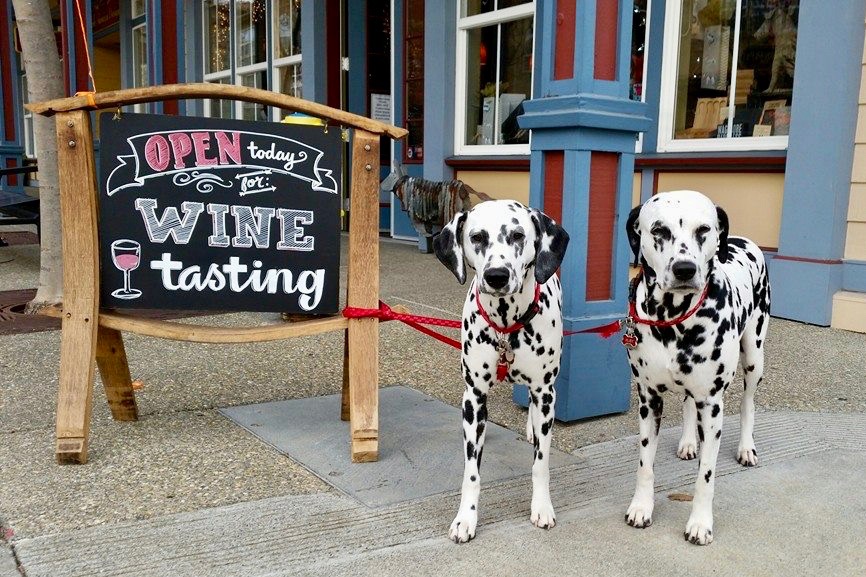
Windsor
Mutt Lynch Winery
Winemaker Brenda Lynch’s winery is both an ode to wine and to furry friends. The tasting room hosts “Yappy Hour” events and offers water, treats, toys and possible playmates, as staff members often bring their pups to work. The winery also raises funds for animal rescue organizations through its Wines That Give Back program. 9050 Windsor Road, 707-687-5089, muttlynchwinery.com
Bricoleur Vineyards
Bricoleur’s Essentials Picnic tasting ($75 per person) is the perfect excuse to treat yourself and your furry friend to an alfresco lunch by the estate pond with a glass of refreshing sparkling wine. Dogs are welcome in all outside areas at Bricoleur Vineyards, though only official service animals are allowed in the Winery Barn. All dogs should be leashed and never left unattended. 7394 Starr Road, 707-857-5700, bricoleurvineyards.com
Martinelli Winery
The historic Martinelli Winery & Vineyards welcomes well-behaved dogs on a leash for its Vineyard Terrace Tasting ($50 per person). The tasting includes a flight of estate wines to sip on the terrace overlooking the Hop Barn Hill Vineyard, with the option to add a picnic lunch and bottle service. Only service animals are allowed inside the tasting room. 3360 River Road, 707-525-0570, martinelliwinery.com
La Crema
Located within Saralee’s Vineyard in the Russian River Valley, La Crema Estate also welcomes dogs. The site’s landmark historic barn has been converted into a tasting and wine education facility. Dogs should be on a leash at all times. 3575 Slusser Road, 707-525-6200, lacrema.com
Santa Rosa
Balletto Vineyards
Is Balletto pet-friendly? Yes! The winery says it usually has dog treats and water bowls at the ready for visiting dogs. Just make sure your dog is on a leash during the entire visit. 5700 Occidental Road, 707-568-2455, ballettovineyards.com
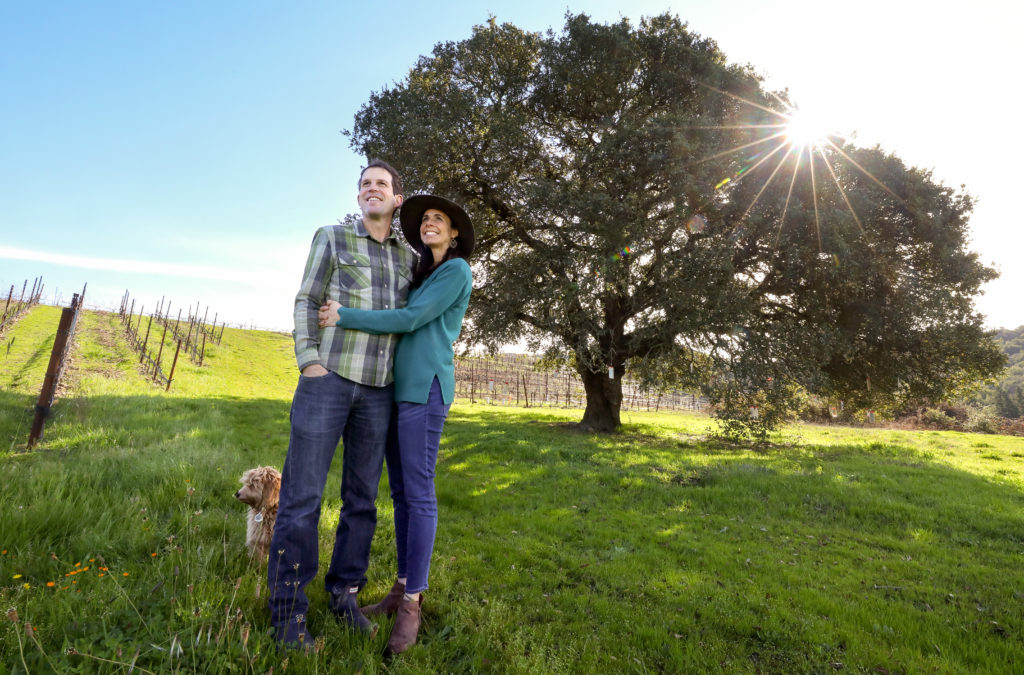
Belden Barns
This family-run winery prides itself on being dog-friendly and kid-friendly. The property, which is located on Sonoma Mountain, is also a working farm that produces a diverse array of fruits and vegetables. 5561 Sonoma Mountain Road, 415-577-8552, beldenbarns.com
Matanzas Creek Winery
Well-behaved dogs on a leash are welcome both inside and outside at Matanzas Creek, where aromatic lavender gardens line the property. For International Dog Day this year, the winery is hosting a pup-focused celebration for dog owners and lovers from 4-7 p.m. on Aug. 24. The event will include a selection of estate wines to taste, live music performances, “Burgers and Birria” by Bayou on the Bay, a complimentary painting session, and a plush dog toy and Matanzas Creek pop-up water bowl to take home for your furry companion. General admission is $60 per person and $50 for wine club members. Purchase tickets on Tock. 6097 Bennett Valley Road, 707-521-7019, matanzascreek.com
Freestone
Black Kite Cellars
This family-owned boutique winery will welcome dogs to the estate for its three-day-long Pooches & Pinot celebration, held between 10 a.m. to 5 p.m., July 12-14, at the Jasper House, Black Kite Cellars’ newly opened wine tasting room in Freestone. The event will include signature tasting flights of Pinot Noir and Chardonnay as well as healthy “bark-cuterie boards” with dog treats and a Black Kite Cellars bandana for visiting pups. Plenty of water will also be available for the dogs. Pooches & Pinot tickets are $67 per person. Purchase tickets on Tock. 12747 El Camino Bodega, 707-322-4863, blackkitecellars.com
The post 30 Favorite Dog-Friendly Wineries in Sonoma County appeared first on Sonoma Magazine.
]]>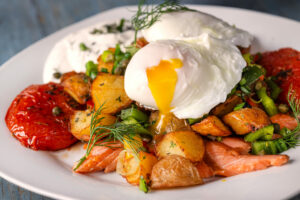
From classic buttermilk biscuits and gravy to indulgent lox and latke Benedict with caviar, here are the best egg breakfasts around.
The post 8 Favorite Breakfasts in Sonoma County appeared first on Sonoma Magazine.
]]>









As a symbol of renewal, fresh eggs get a lot of attention this time of year. Their sunny yolks and over-easy dispositions make them inescapable breakfast workhorses. Here are our favorite egg breakfasts. Click through the above gallery for more.
The Log Lifter
Buttermilk Biscuits and Gravy with Scrambled Eggs
Baker & Cook
Originating in 19th century lumberjack camps, this gut-stuffing breakfast warms the heart and fills the belly for a long day of timbering—or couch surfing. $18.
18812 Highway 12, Sonoma. 707-938-7329, bakerandcooksonoma.com
Greet the Meat
Midtown Corned Beef Hash
J&M’s Midtown Cafe
House-cured corned beef, crisp hash browns, and melted cheese lay a tasty base for gooey poached egg yolks that slowly drizzle over the beautiful mess. Chef’s kiss. $16.
1422 Fourth St., Santa Rosa. 707-545-2233, jm-midtowncafe.com
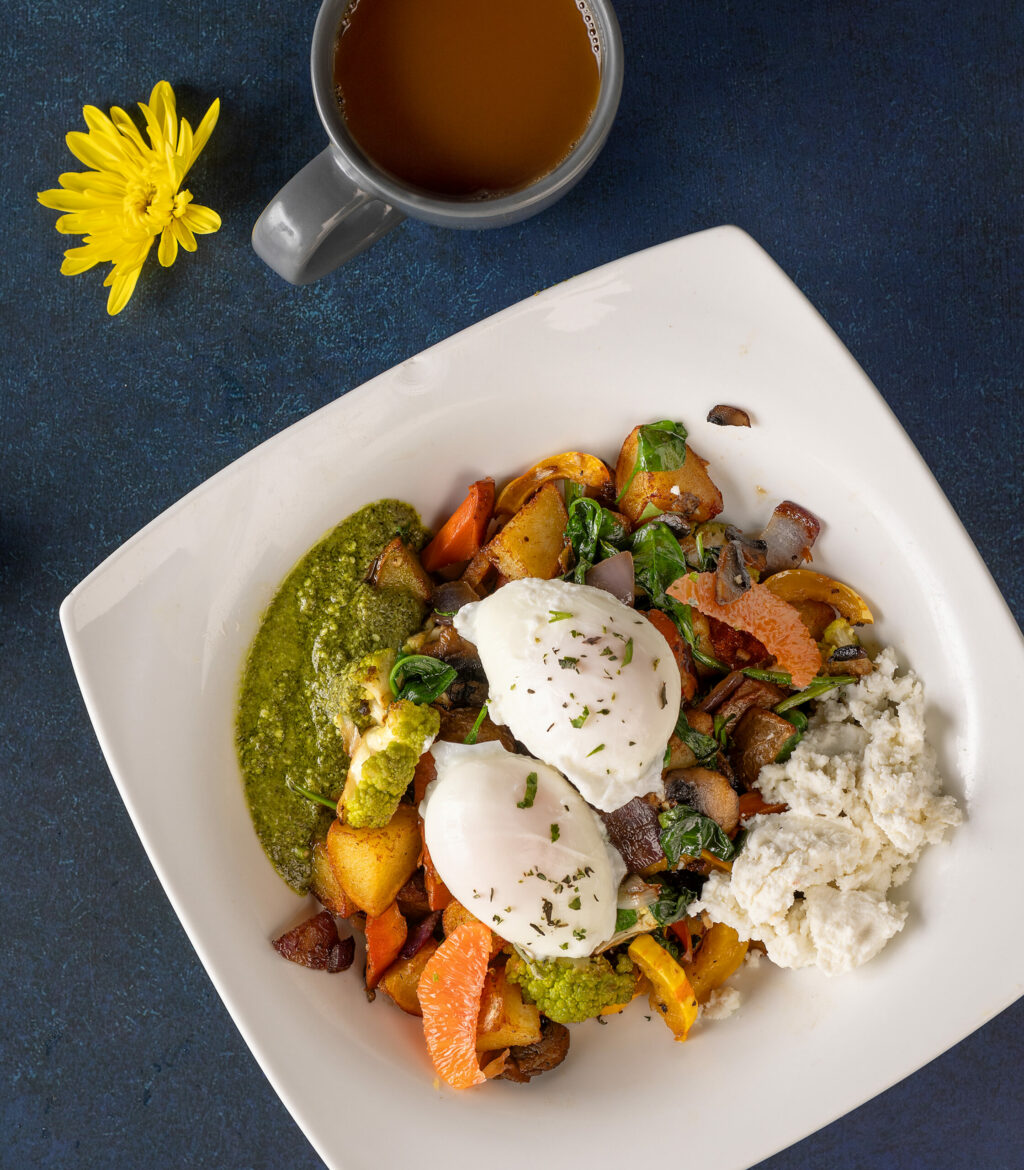
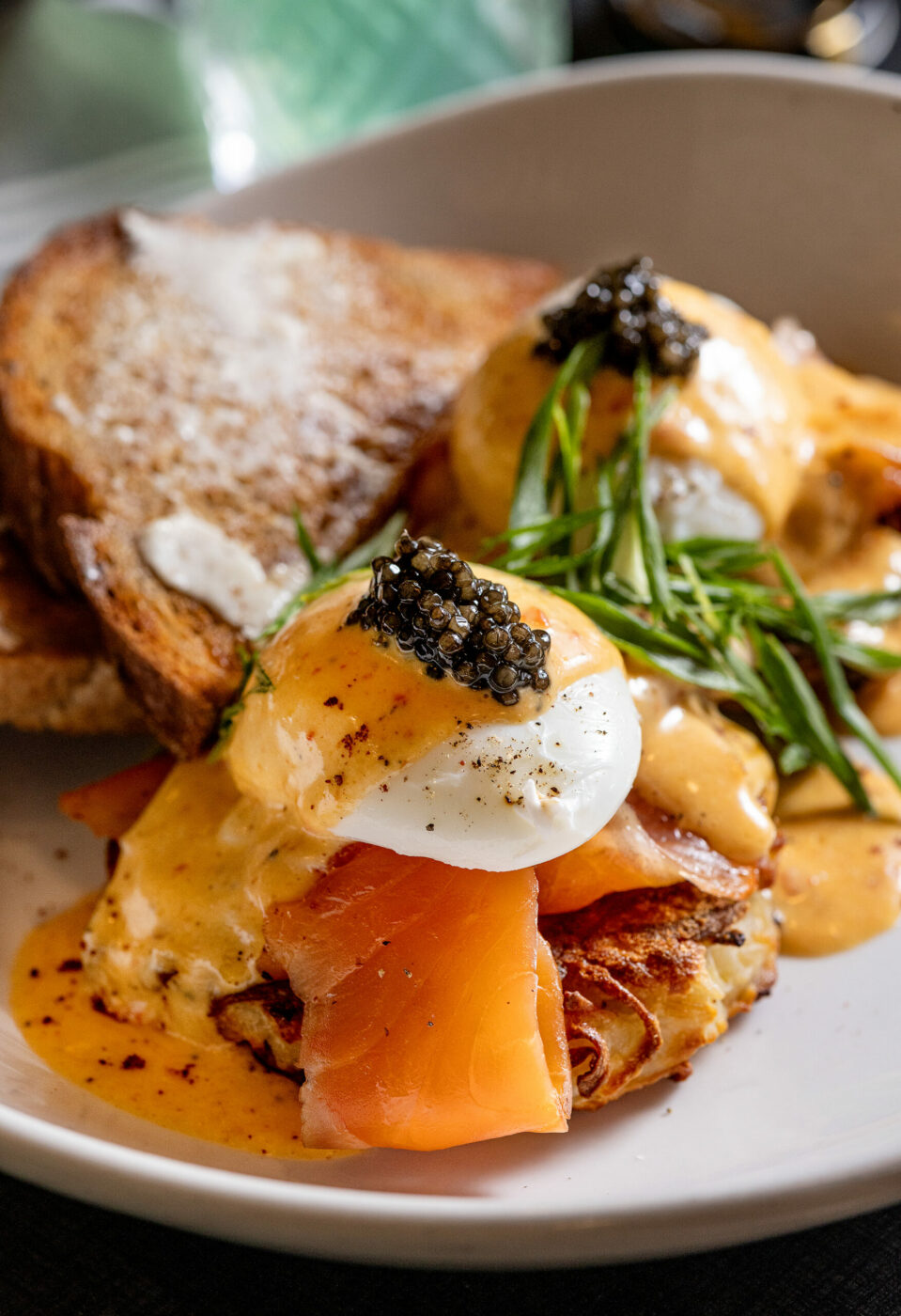
Bling Your Benedict
Lox and Latke Benedict with Caviar
Grossman’s Noshery & Bar
This bougie breakfast substitutes crisp potato latkes and luxurious lox for the usual Benedict players. A schmaltz Hollandaise and caviar pile on the posh. $32.
308 Wilson St., Santa Rosa. 707-595-7707, grossmanssr.com
Hugs and Quiches
Deep Dish Quiche
Costeaux Bakery Cafe
The Godzilla of quiches, this mighty mountain of eggs, ham, bacon, cheese, and crust at this local institution absolutely crushes the competition. $15.
417 Healdsburg Ave., Healdsburg. 707-433-1913, costeaux.com
Morning Nachos
Chilaquiles
La Texanita
Somewhere between crispy and soggy is the perfect texture of tortilla chips smothered in salsa rojo, cotija cheese, and onions, and topped with scrambled or poached eggs. Add carnitas if you’re feeling sassy. $20.
1667 Sebastopol Road, Santa Rosa. 707-527-7331, latexanita.com
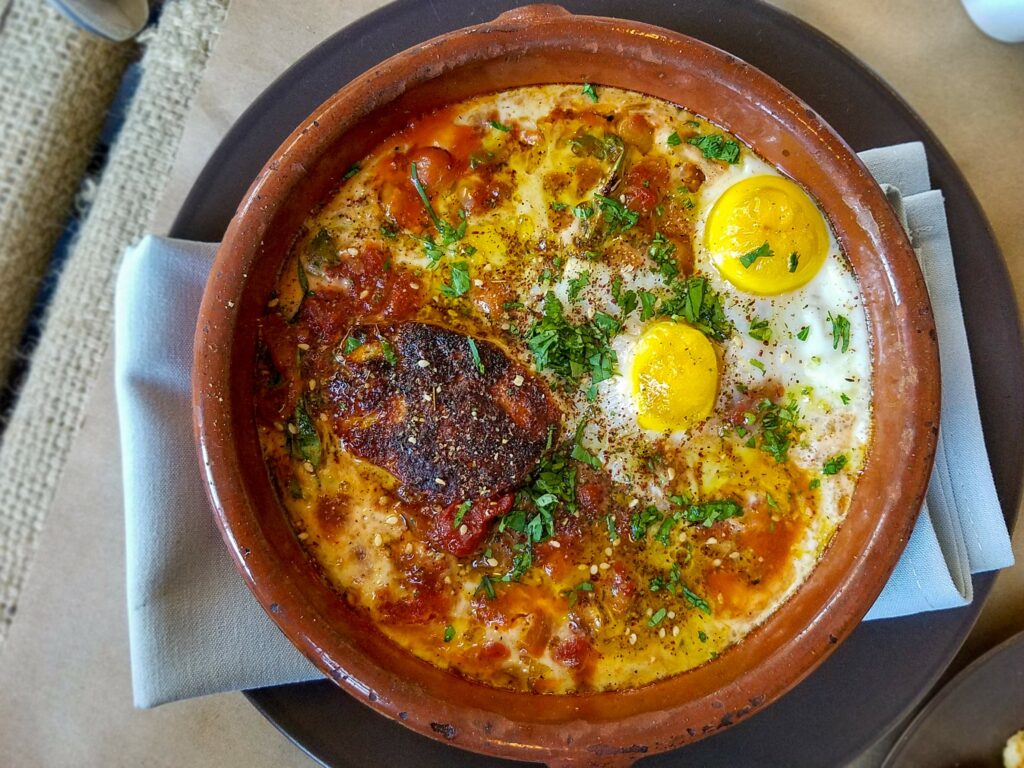
The Mix Don’t Lie
Shakshuka
Pearl
The Arabic origins of this roiling red dish mean “mixed up,” but the piquant (not hot) combination of paprika, chickpeas, tomatoes, peppers, grilled Halloumi cheese, and baked eggs is more beauty than beast. $25.
500 First St., Petaluma. 707-559-5187, pearlpetaluma.com
Morning Motivator
Breakfast Sandwich
Americana
Greet the day with this easy, handheld traveler of a sando. Two overhard eggs, Estero Gold cheese, spinach, and housemade aioli on buttery toasted sourdough.
$15. 162 N. Main St., Sebastopol and 205 Fifth St., Santa Rosa. 707-827-3309, americanasr.com
Très Français
French Folded Eggs
Willow Wood Market Cafe
Velvety curds of steamed egg stippled with fontina cheese and basil will leave you wondering why Americans insist on overcooking and overstuffing this breakfast classic.
$16.75. 9020 Graton Rd., Graton. 707-823-0233, willowwoodgraton.com
The post 8 Favorite Breakfasts in Sonoma County appeared first on Sonoma Magazine.
]]>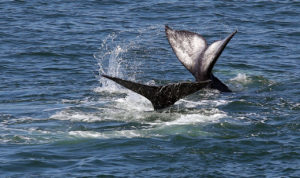
The peak months for whale watching are January through May. Bring binoculars for a spectacular sighting.
The post Where to Go Whale Watching on the Sonoma Coast appeared first on Sonoma Magazine.
]]>









Twice each year, some 20,000 gray whales pass along the California coast as they swim south to breeding lagoons on the west coast of Baja California during winter months, then back to their summer feeding grounds in the Arctic’s Bering Sea in spring. The round trip for these sea giants is roughly 12,000 mile and is considered one of the longest among mammals.
If you’d like to witness this epic journey, the peak months for whale watching are January through May. If the weather is good, whales can be seen within a few hundred yards of coastal headlands. During spring migration, even little whales are a big deal, as the recently born calves cavort with their mothers on their way back to colder waters.
Click through the above gallery for prime whale viewing locations along the Sonoma Coast. For more winter adventures, check out our guide to local waterfalls.
PLEASE NOTE: Always read and obey warning signs along the coast. Ocean conditions can change quickly, and the absence of a particular sign does not mean there is no threat of hazardous conditions. Always keep a safe distance to the ocean and be careful when looking through binoculars and taking photos.
The post Where to Go Whale Watching on the Sonoma Coast appeared first on Sonoma Magazine.
]]>
Stumped on what to do when it gets damp and gray outside? Here are some suggestions on how to make a rainy day a little brighter.
The post 10 Things to Do on a Rainy Day in Sonoma County appeared first on Sonoma Magazine.
]]>









Stumped on what to do when it gets damp and gray outside? Click through the gallery for 10 suggestions on how to make even a rainy day a little brighter.
The post 10 Things to Do on a Rainy Day in Sonoma County appeared first on Sonoma Magazine.
]]>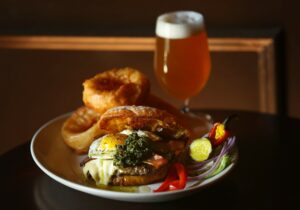
These local spots have the fireplace roaring, plus comforting meals and drinks to keep you warm.
The post Cozy Sonoma Restaurants and Bars for Chilly Days appeared first on Sonoma Magazine.
]]>









On chilly, rainy days, when all you want to do is snuggle up by a crackling fireplace, head to these cozy restaurants, bars and tasting rooms in Sonoma County for a comforting meal and drinks. Click through the above gallery or see the list below for details, and share your favorites in the comments.
Stark’s Steak & Seafood, Santa Rosa: This classic steakhouse does cozy in retro style. You’ll get the Bogie-and-Bacall vibe right away. Manhattans, aged whiskies and absinthe are served by white-coated bar staff. The seats are leather and a baby grand sits in the corner waiting to tinkle out a tune or two. 521 Adams St., Santa Rosa, 707-546-5100, starkrestaurants.com
Monti’s, Santa Rosa: This Montgomery Village restaurant is a hot summer spot for wine and Mediterranean cuisine on the patio. During the colder months, a wood-burning rotisserie keep things hot, and gregarious bartenders keep guests in good spirits no matter the temperature. 714 Village Court, Santa Rosa, 707-568-4404, montismv.com
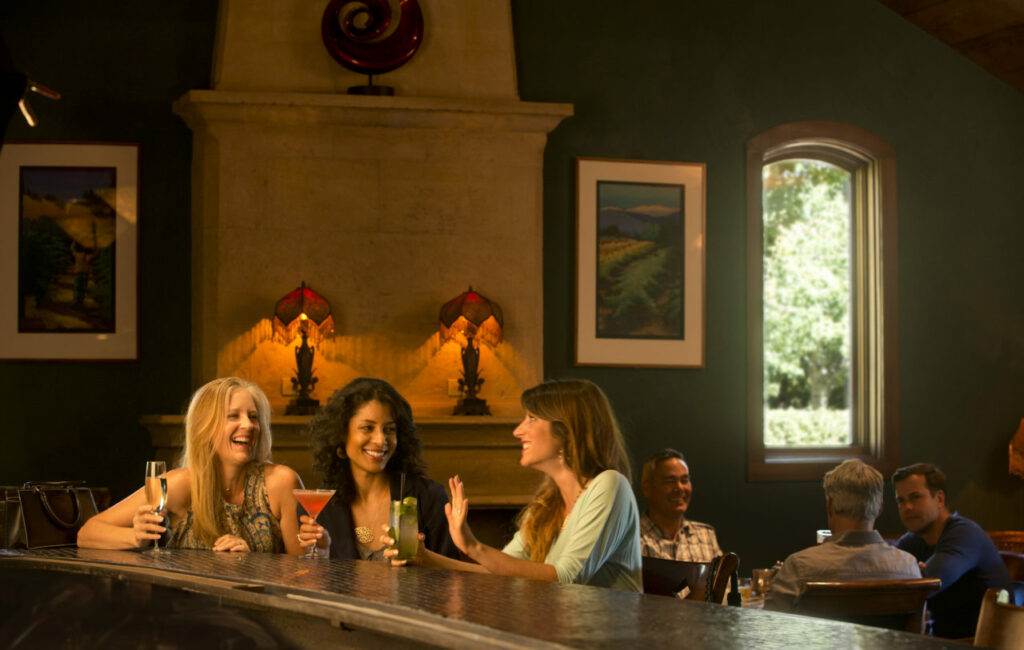
John Ash Front Room, Santa Rosa: The dark, clubby vibe of this hotel lounge is perfect for rainy-day drinks with friends. Cozy leather seats are prime real estate, but bar tables for two are a bit more intimate. 4330 Barnes Road, Santa Rosa, 707-527-7687, vintnersresort.com
El Dorado Kitchen, Sonoma: Escape the hustle and bustle of the busy dining room, and grab a seat in the farm-chic lounge. You’ll be warmed by the fireplace and cutely named cocktails such as the Coda Pendant of rye, apple schnapps, sugar, lemon and Angostura bitters. 405 First St. West, Sonoma, 996-3030, eldoradosonoma.com
The Restaurant at Dawn Ranch, Guerneville: Dawn Ranch’s new restaurant offers a true farm-to-table dining experience, with many of its ingredients grown directly on the property. Warm up by the fire after taking a stroll through the resort’s meadow. 16467 California 116, Guerneville, 707-869-0656, dawnranch.com
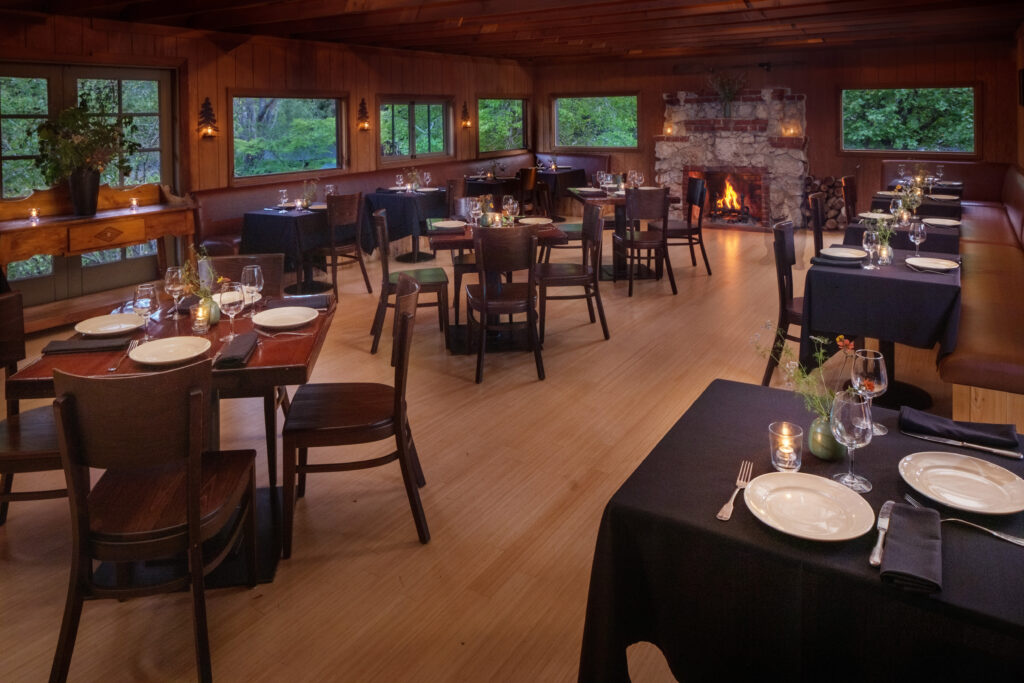

Farmhouse Inn, Forestville: Farmhouse Inn houses an upscale, but surprisingly low-key Michelin-starred restaurant. The ambiance is sophisticated yet cozy, the Cal-French cuisine delicious yet unpretentious, the decor chic and the service snappy. And there’s a fireplace. 7871 River Road, Forestville, 707-887-3300, farmhouseinn.com/restaurant.
Drake’s Fireside Lounge, Bodega Bay: Adjacent to the Drakes Sonoma Coast Kitchen at The Lodge at Bodega Bay, this pretty retreat woos with a large stone fireplace framed by gorgeous views of Bodega Head, Doran Beach and the Pacific Ocean. Life is nice when you’re bundled in your favorite sweater, supping on a juicy cheeseburger and sipping on a cocktail. 103 Highway 1, Bodega Bay, 707-875-3525, lodgeatbodegabay.com/the-fireside-lounge
The Matheson, Healdsburg: Enjoy a woodfired pizza fireside at The Matheson’s Roof 106. This buzzy rooftop bar in Chef Dustin Valette’s new restaurant complex has fire pits and a warm ambiance. 106 Matheson St., Healdsburg, 707-723-1106, thematheson.com/roof-106
Ram’s Gate Winery, Sonoma: Feel as though you’re in a mountain lodge while taking in the Carneros views. There are multiple tasting experiences and spaces to enjoy by appointment ($40-$160; some are seasonal and many offer food pairings), and each space is warmed by a roaring fireplace. 28700 Arnold Drive, Sonoma, 707-721-8700, ramsgatewinery.com
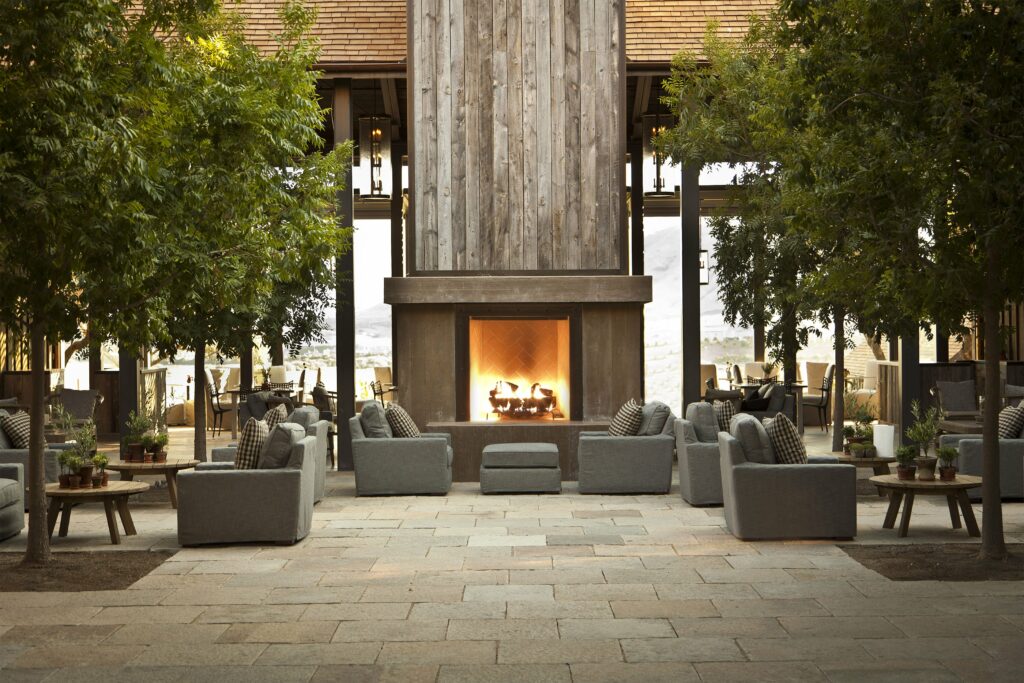
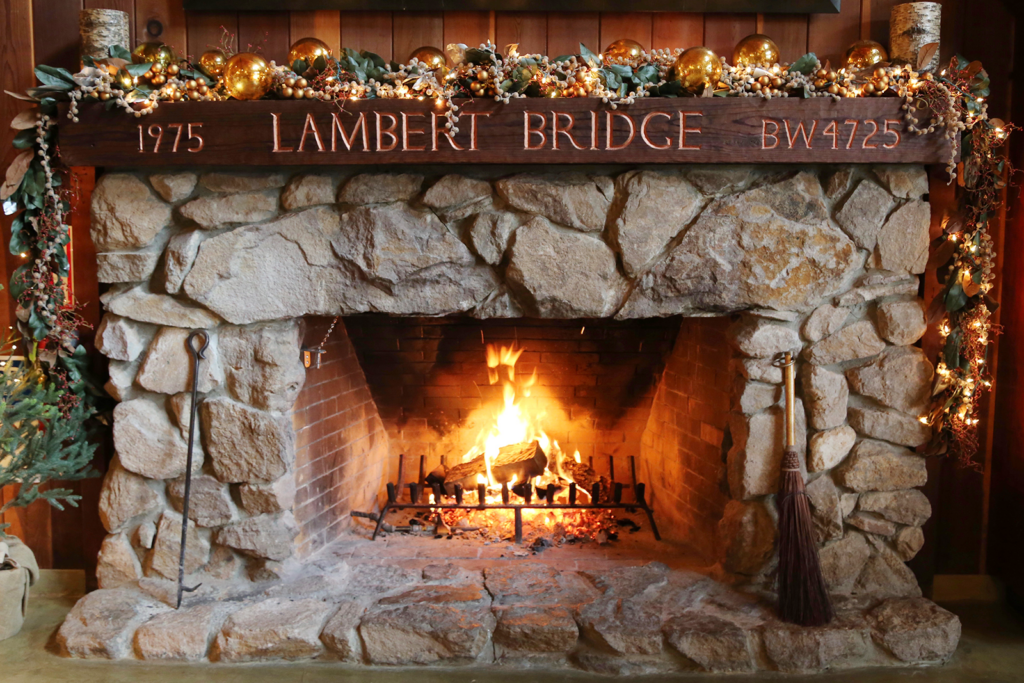
Lambert Bridge, Healdsburg: Specializing in Bordeaux varieties, Lambert Bridge also boasts a tasting room featuring a large fireplace, vaulted ceilings and a bar made of a single felled redwood tree. Glass walls provide a view into the barrel room. The Barrel Room Tasting Experience is $75 and includes four hand-selected wines. 4085 West Dry Creek Road, Healdsburg, 707-431-9600, lambertbridge.com
Zina Lounge, Sonoma: It’s an unusual set-up, but all the more fun for being so different. Technically, Zina could be called a wine and food pairing, since you sit with an intimate group at a communal table in what is the Zina Hyde Cunningham Winery tasting room in the lobby of the Ledson Hotel on the Sonoma Plaza. The setting is fine-dining posh, trimmed in gleaming wood with a flickering fireplace flanked by leather couches. 480 First St. East, Sonoma, 707-996-9779, zinawinery.com
Kendall-Jackson Wine Estate & Gardens Tasting Room, Santa Rosa: Visit this winery estate for a tasting of their sustainably-produced wines and a stroll through the gardens. On cold days, cozy up by the fireplace in the tasting room. The Estate Tasting is $35; reservations required. 5007 Fulton Road, Santa Rosa, 800-769-3649, kj.com
Lonnie Hayes, Heather Irwin, Maci Martell, Julie Fadda Powers and Carey Sweet contributed to this article.
The post Cozy Sonoma Restaurants and Bars for Chilly Days appeared first on Sonoma Magazine.
]]>
In 1976, Christo's large-scale artwork "Running Fence" was installed over 24.5 miles of Sonoma and Marin farmland. The artist made as much of an impression on the local community as his artwork did.
The post From the Archives: Memories of Christo’s Running Fence appeared first on Sonoma Magazine.
]]>









This article was originally published in 2016, 40 years after the installation of “Running Fence.” Christo, who made monumental art around the world, died at 84 on May 31, 2020. Jeanne-Claude, his artistic and life partner, died at 74 on Nov. 18, 2009.
The hamlet of Valley Ford hasn’t changed much in the last four decades. There’s more traffic, of course: It’s located on scenic Highway 1, and Bodega Bay is just 8 miles to the west. But Dinucci’s Italian Dinners is still there, serving the family-style meals that made its initial reputation more than a century ago.
Local ranchers still come to the Valley Ford Market for coffee and the latest talk on lamb prices and government regulation. And the land itself seems immutable: The rolling pastures broken by eucalyptus windbreaks — speckled with fat sheep and sleek cattle — present a prospect as timeless as the nearby Pacific Ocean.
But something happened here 40 years ago that changed everything. A discreet monument marking that event stands at the Valley Ford post office, a single, corroded metal pole 18 feet high, with a small commemorative plaque at its base. It was at this spot that “Running Fence” came through, completed on Sept. 10, 1976.
If you saw the fence then, you can stand next to the pole now, close your eyes and see it again, with almost shocking clarity. You can understand now that it meant much more than you thought it did at the time of its installation.
Joe Pozzi remembers when a slight-framed man with long hair, massive horn-rimmed glasses and craggy features came to his family’s ranch near Estero de San Antonio. It was in 1972, and Pozzi and his siblings were engaged in the quotidian duty required of anyone involved in a dairy operation: milking the cows.
“We were in the barn and we saw Dad outside talking to this guy,” recalled Pozzi, then a pre-teen. “And when Dad came into the barn, we asked him what was going on, and he said, ‘Oh, some damn hippie wants to build a fence for us. I told him to come back later.’”
That “hippie” was Christo — Christo Vladimirov Javacheff — now hailed as the world’s foremost installation artist and one of the great creative visionaries of the past five decades. While it’s true that he came to the Pozzi ranch to build a fence, it wasn’t as an itinerant laborer hoping to make a few bucks stringing barbed wire.
“Christo was Bulgarian and his English wasn’t that great then, so Dad misunderstood him,” Pozzi said. “But Christo came back with his partner, Jeanne-Claude, and my mom brought out the bread, cheese and salami, like the west county Italian farmers always did when they had visitors. And Christo had this book with him, about something called the hanging curtain at Rifle Gap.”
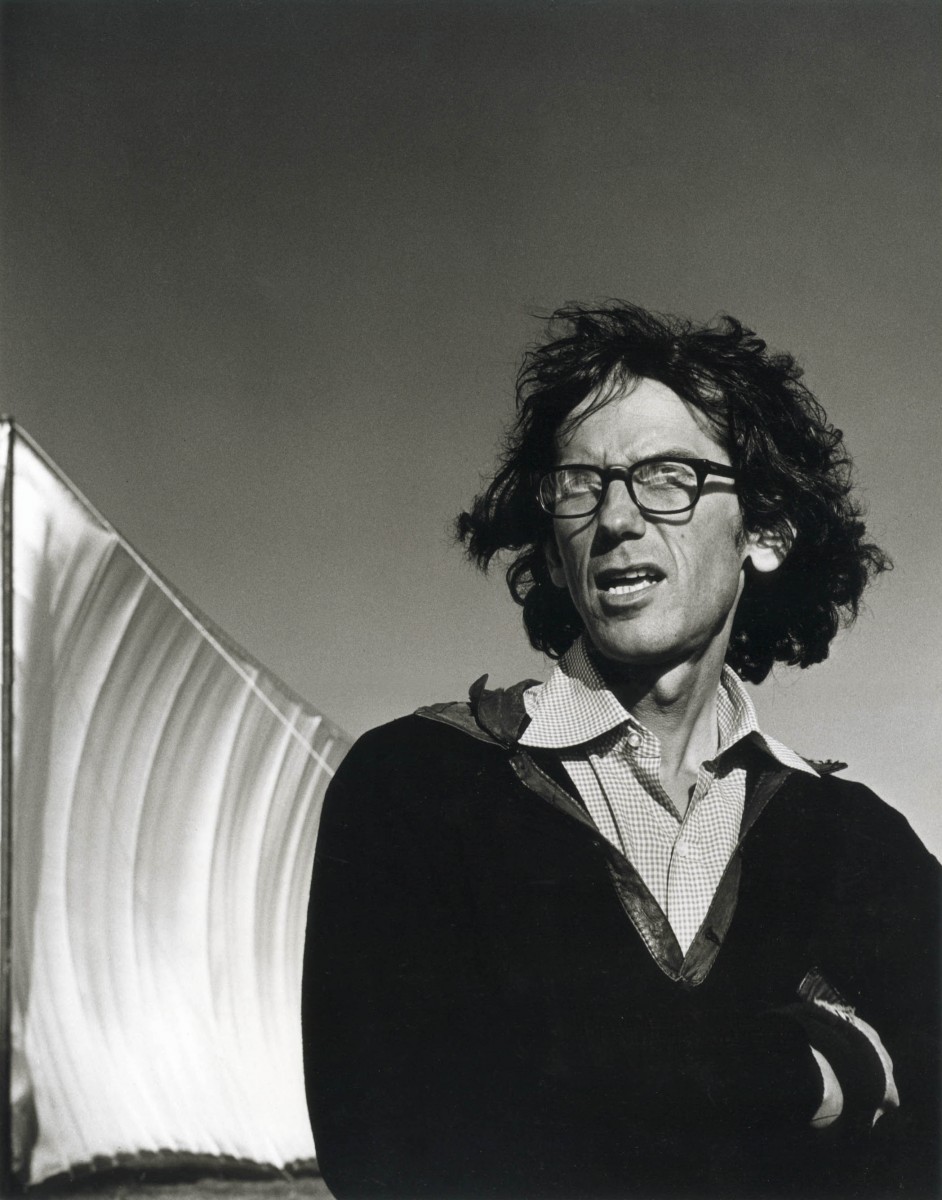
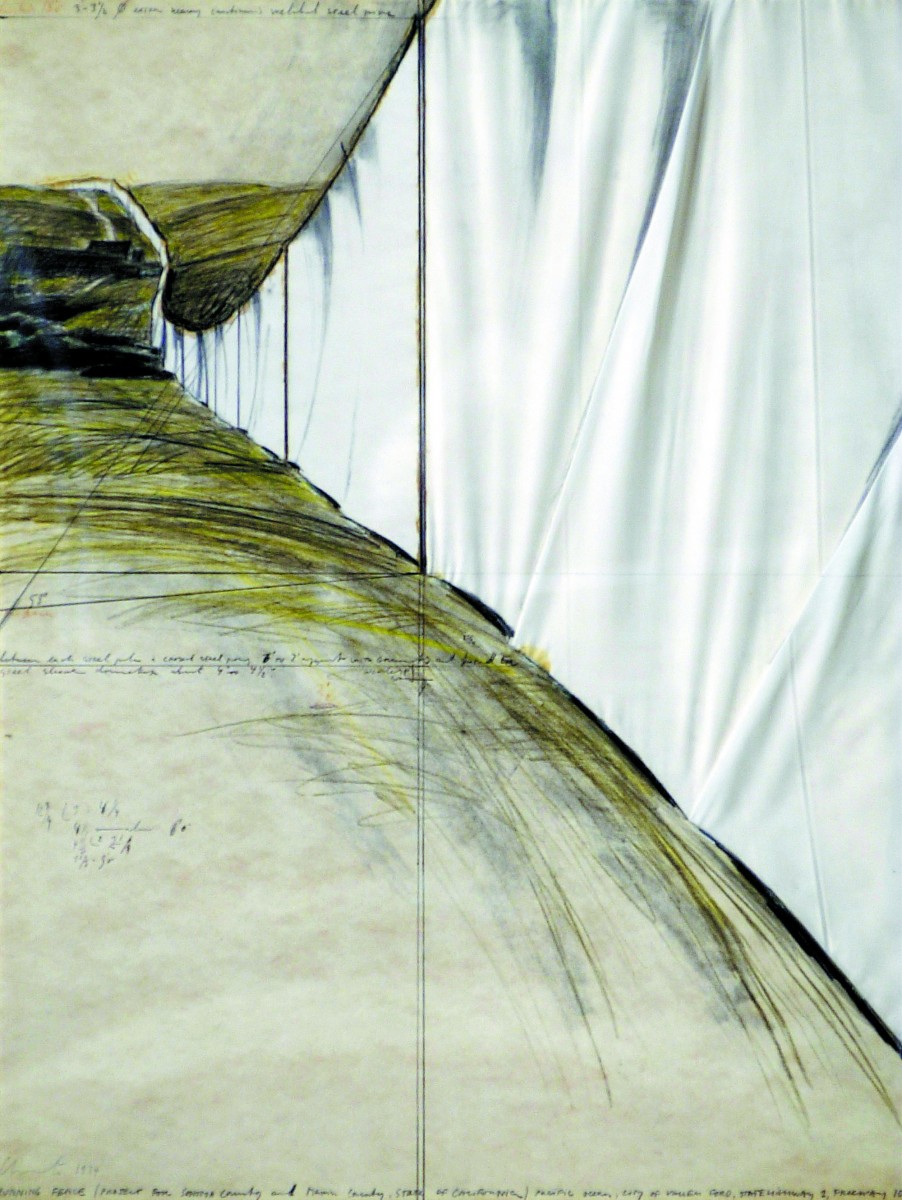
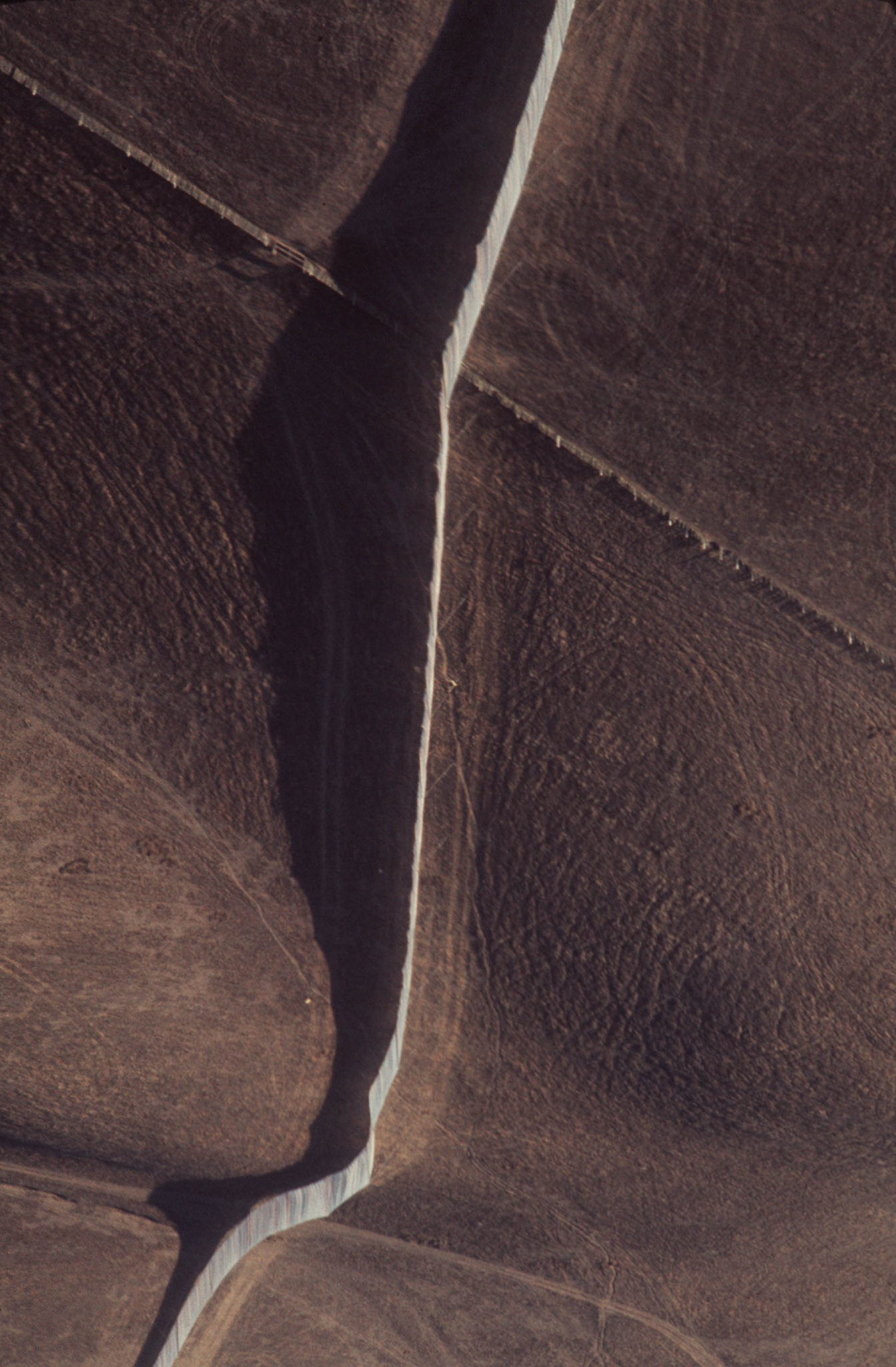
That was Rifle Gap, Colo., and “Valley Curtain” was a project that Christo and Jeanne-Claude had recently completed, a 200,200-square-foot swath of fabric draped across a steep mountain pass. As everyone ate the antipasti, the Pozzis politely listened to Christo’s proposal. He planned another project, this one for Sonoma and Marin counties, a fence of fabric running sinuously across the land from Highway 101 to the sea. It would be about 25 miles long and almost 20 feet high.
By the end of the visit, Pozzi said, his parents still weren’t completely clear on the concept, but they were sure of one thing: They liked Christo.
“He was incredibly charismatic,” Pozzi said, “but it was more than that. He was genuine. There was a warm human quality to him that you just felt. There was nothing slick or pretentious about him. Ranchers and farmers intuitively sense character in a person. He didn’t get the ‘Running Fence’ built because he sold anybody around here on the idea. They got behind him because they liked and trusted him.”
Christo returned to the Pozzi ranch several times over the next few months, and ultimately formed a deep bond with the family. At the same time, he visited other dairy farmers and ranchers who owned land along his proposed route for the fence. He ate at their tables and drank their wine.
Christo was in no hurry, Pozzi said, as he and Jeanne-Claude seemed to relish the human contact. It was evident they enjoyed immersing themselves in the west county’s agrarian culture.
“Everyone came to understand Christo was an artist, an important artist, and that the ‘Running Fence’ was a major art project,” Pozzi said. “But that wasn’t why he appealed to us. It was more that he shared similar qualities with the agricultural community. It’s something of a paradox. We’re independent, but we also rely on each other, we’re ready to help out at a moment’s notice. And we like to get things done, to conceive a project and then work hard to see it through. Christo had a project that he wanted to get done. He wasn’t going to step on anyone to do it, but it was important to him, and he asked for our help.”
Christo and Jeanne-Claude ultimately enlisted 59 families whose properties fell within the proposed route of the fence. The ranchers and farmers weren’t merely acquiescent, however; they had become committed partisans for the project.
At the same time, news of the fence generated fierce push-back, primarily from environmentalists concerned about impacts on the land, and also from locals who were offended by promotion of the project as “art.” They formed the Committee to Stop the Running Fence, and vowed to send Christo fleeing from Sonoma.
The upshot of the discord was a seemingly endless series of meetings convened by the California Coastal Commission, the Marin County Planning Commission and the Sonoma County Planning Commission. The process was rancorous and dragged on for more than three years.
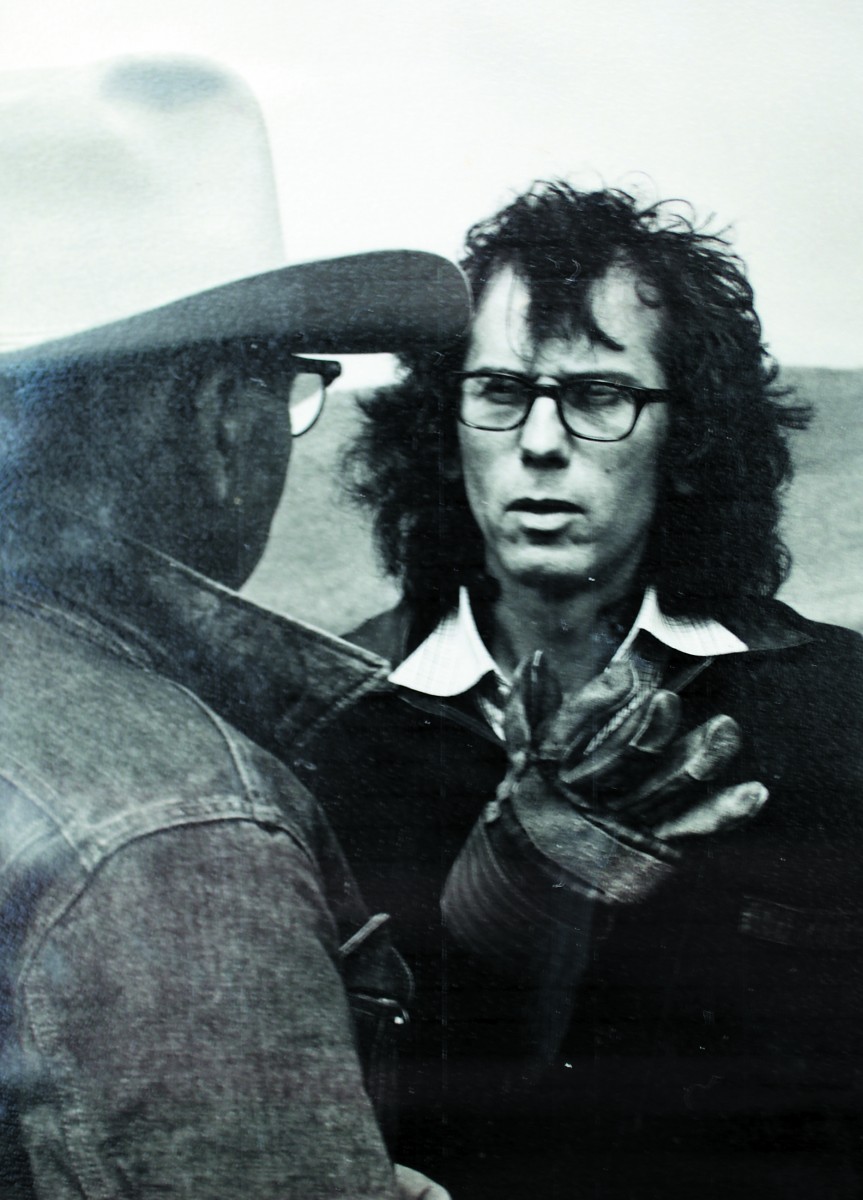
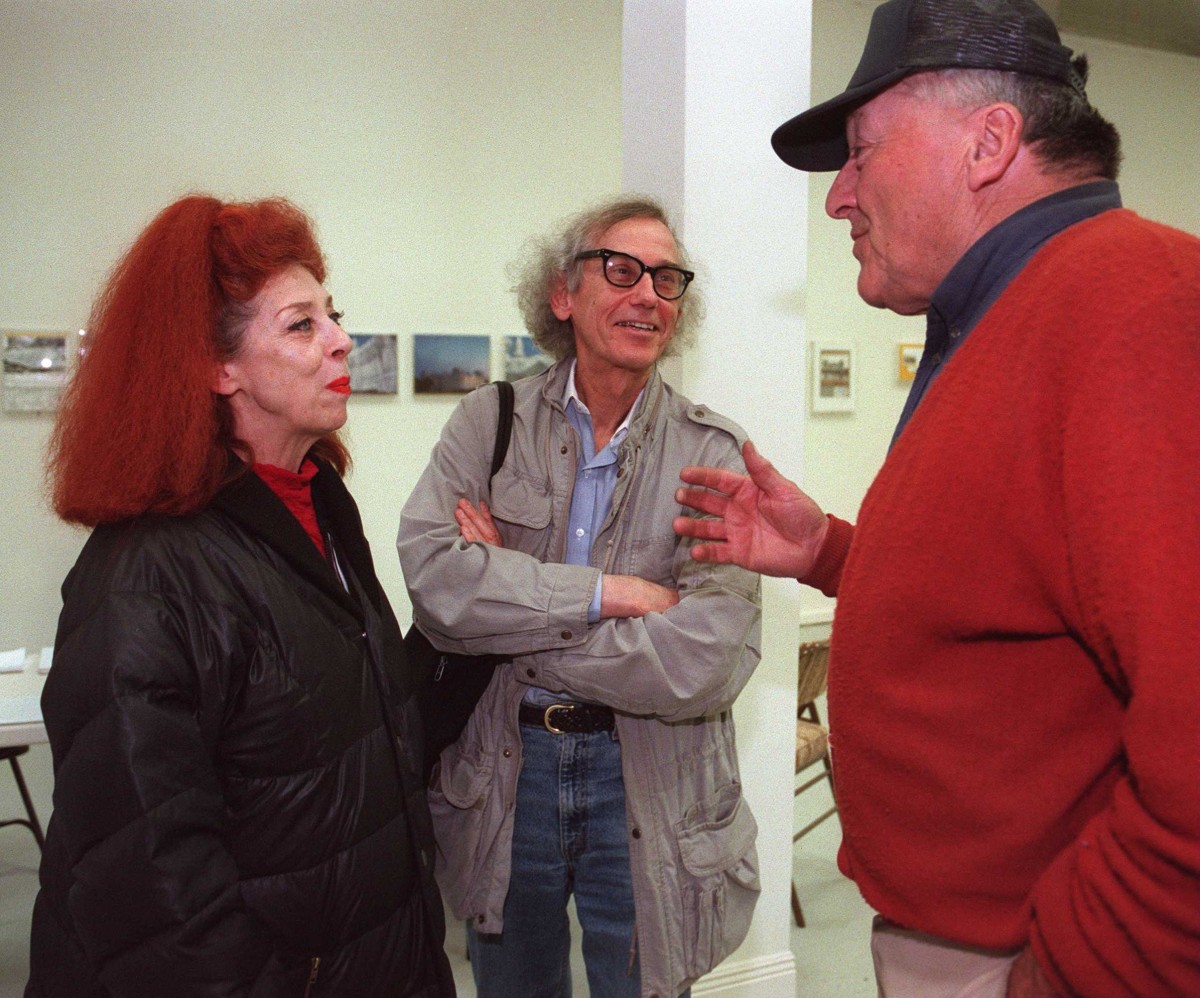
“I remember at one point somebody declaring that the fence was ‘fascist art,’” said Brian Kahn, then a freshman Sonoma County supervisor who had been newly appointed to fill a vacancy. “I didn’t physically roll my eyes, but I rolled them internally. I was perplexed by the furor. The fence drew all these incredibly intense emotions that — from my perspective, at least — it didn’t warrant. Politics and art don’t mix well, and my bias has always been to let artists do what they want.
“But the fence came along just at a point when land-use policy was the primary matter of concern in the county, and it seemed to galvanize emotions on all sides of the issue. In a way I didn’t realize at the time, it focused people on the landscape and the impact our land-use policies would have on the future of the county.”
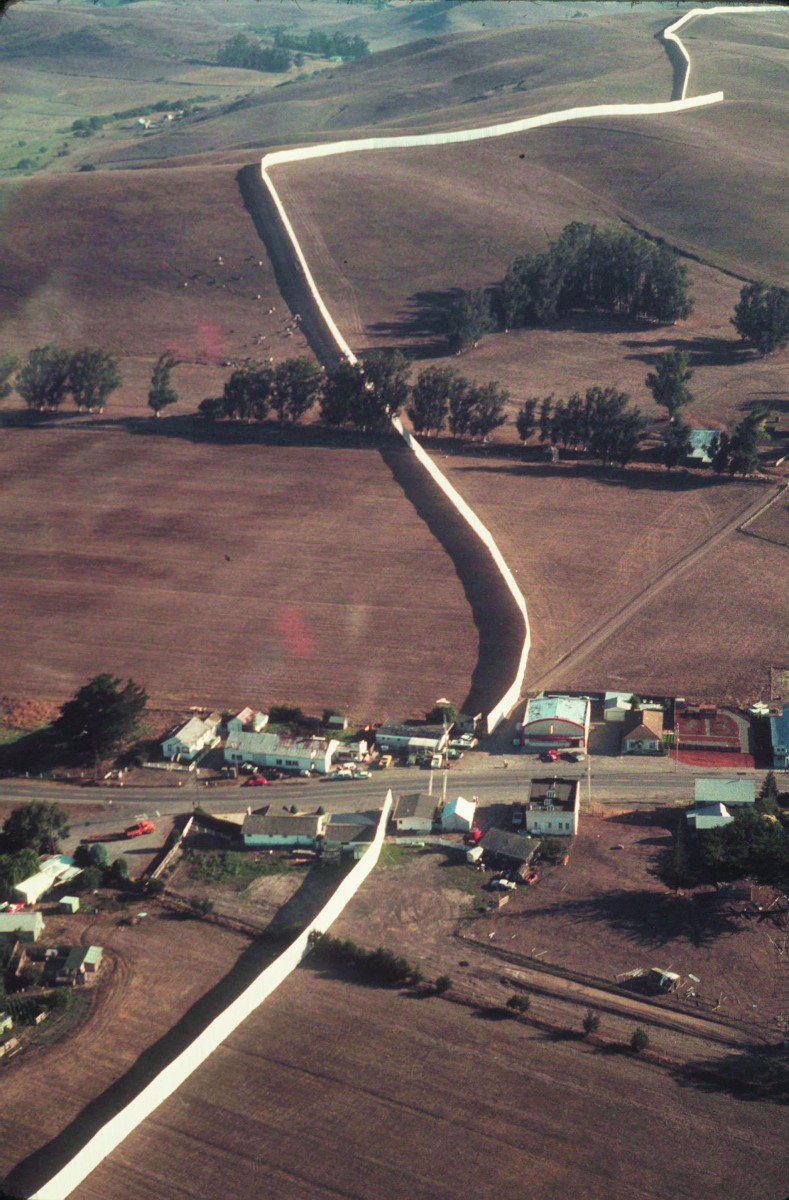
But if opponents inveighed furiously against the project at the meetings, supporters — mainly ranchers and dairy farmers — spoke passionately in its favor. Christo seemed utterly serene. He spoke in defense of his art, and his disposition was always sunny; he never seemed worried, or even slightly anxious.
“He said on more than one occasion that the process, all the meetings, the environmental impact studies, were part of his art,” said Barbara Gonnella, owner of the Union Hotel in Occidental and Joe Pozzi’s sister. “And that was the absolute truth. If he hadn’t been able to build the fence in the end, I’m sure he would still have considered the project a success.”
Earlier this year, Gonnella hosted a screening of a film about “Running Fence” that was funded by the Smithsonian Museum of Modern Art. For Gonnella, the documentary had special resonance because it featured one of the last interviews with Jeanne-Claude before her death from a brain aneurysm in 2009.
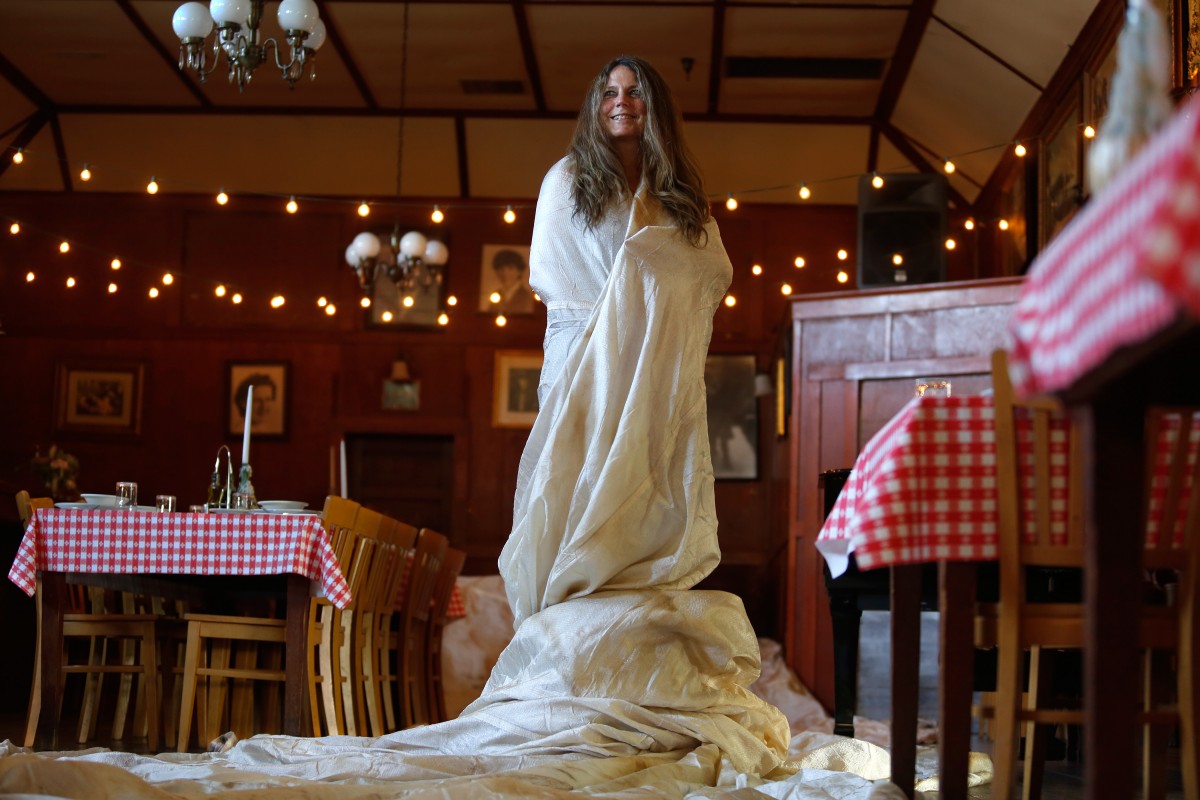
“By the 1990s, their work was a complete collaboration,” Gonnella said. “It was never just ‘Christo.’ It was always ‘Christo and Jeanne-Claude,’ and to me, that emphasized their connection with each other and humanity at large. Christo’s art is about more than just objects and materials, more about themes, even. It incorporates the landscape and the people on it, and the relationships he builds with those people.
“Our family is still in close contact with him. When our mother died, he was the first person to send flowers. When he’s in the area, he eats at the Union Hotel. My daughter just came back from visiting his latest installation (“The Floating Piers” on Lake Iseo, Italy). He’s still part of our lives. His work still affects us. He still affects us.”
Ultimately, of course, the fence went up. Scores of volunteers laid out the route, sank the posts, strung the cables, hung the fabric. Christo was right there among them, wearing an OSHA-required hard hat, blissfully shouldering his share of the grunt labor.
“I was 13 at the time,” Pozzi said, pointing out the path the fence took across the gentle hills south of Valley Ford, now empty save for grass undulating in the wind and myriad grazing sheep. “I think I was the youngest volunteer on the installation. It was an incredible experience, and then, two weeks after it went up (in 1976), we took it down. Two months later, you couldn’t tell it had been there. But my memory of it is still so vivid. It changed people’s lives, and for the better.”
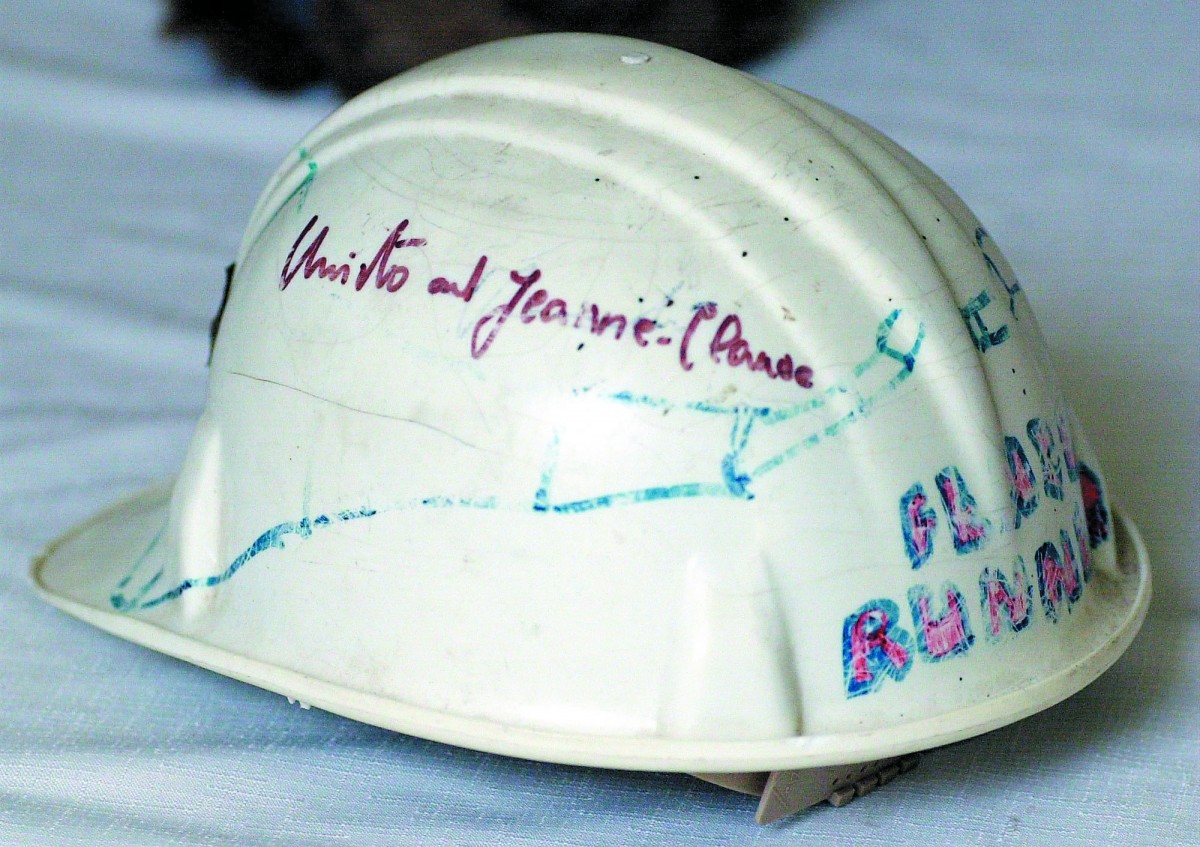
Dave Steiner, a Sonoma Mountain grape-grower who was appointed to the Sonoma County Planning Commission shortly after the fence went up, said people shouldn’t confuse Christo’s melding of government processes into his art with reflexive acquiescence to official dictates.
“Great artists don’t yield to cultural or political pressures,” Steiner said. “They are naturally subversive, and Christo certainly was in that mold. When the Coastal Commission didn’t grant him a final permit to run his fence into the sea, he did it anyway. He used government to make a point in his work, but in the end, he was happy to defy government. That defiance was part of his work, too. And I think anybody who was around here at that time and had his or her head screwed on straight said, ‘Right on!’ when that happened. The fence was always supposed to run into the sea. The entire project would have been diminished if it had stopped at the shore.”
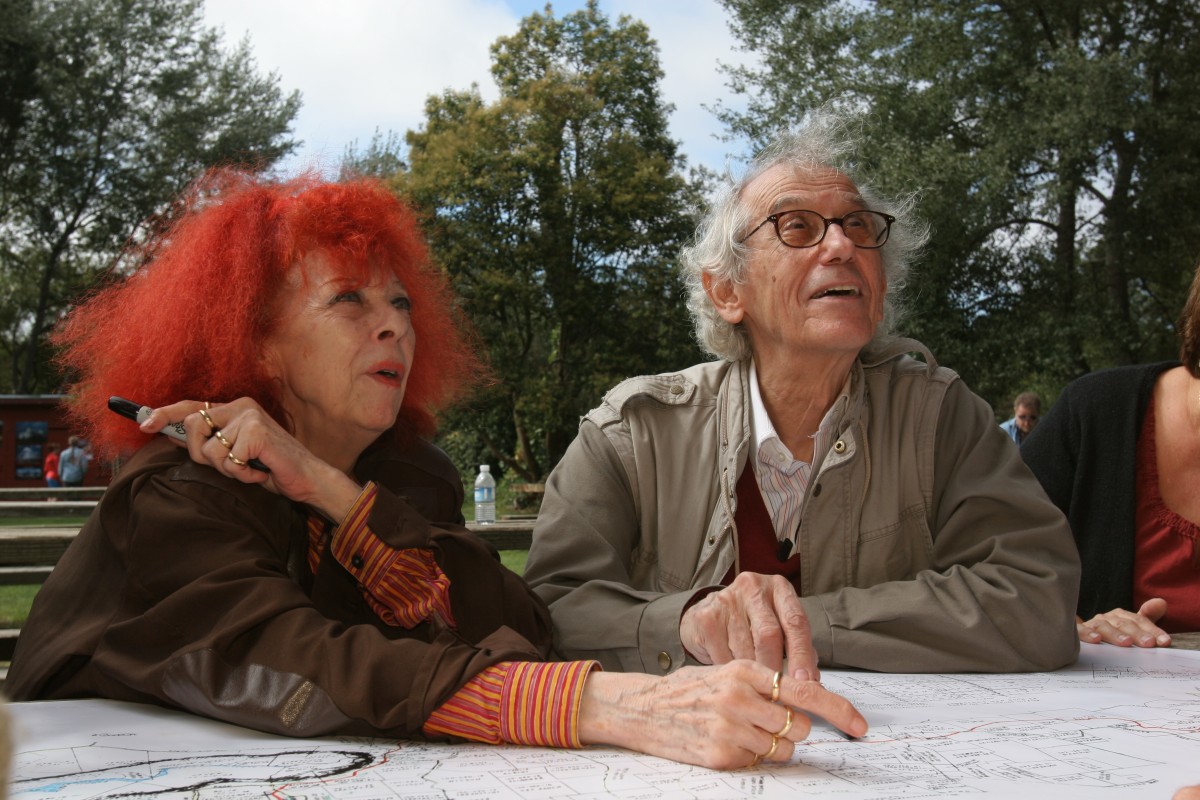
After serving as a Sonoma County supervisor and the president of the California Fish and Game Commission, Brian Kahn moved to Montana. For a time, he directed the Montana Nature Conservancy. He now devotes himself to journalism, authoring books on environmental policy and field sports, and hosting “Home Ground,” a public-issues radio show broadcast across the intermountain West.
But he still gets back to Sonoma County with some regularity, and for the most part, he’s happy with what he sees.
“Through the mid-’70s, the county was focused on — actually divided by — a proposed general plan,” he said. “It was going to determine whether growth would be contained and orderly, or largely unregulated. The plan finally was adopted in 1978, and I’m convinced the fence was a major factor. It made people think about the land and their relationship to it. And when I drive around the county now, I see that the plan has pretty much held together.
“Santa Rosa and Rohnert Park may have merged more than was intended, but Sonoma Valley, the west county — those landscapes are largely intact, despite all the population pressures. It’s a wonderful thing to see. It’s a tremendous collective accomplishment.”
Indeed, the shift toward popular support of a general plan seemed to coincide with the completion of “Running Fence.” The project not only brought Sonoma County to the attention of the world, it also, somehow, brought the people of Sonoma County together.
“It was strange,” said Gonnella as she sat in the shadowed dining room of the Union Hotel following the lunchtime rush. “Once the fence started going up, once people could drive out and see this miraculous thing unfolding across the land, all the bitterness, all the protests, just kind of — stopped.”
She paused, looking out a window. Her eyes were moist, and when she spoke again, her voice was charged with emotion.
“I was only 17 then,” she said. “I loved living out in the west county. Everybody knew each other, most of the families were from the same region in northern Italy. But when the fence came, I got a sense of something bigger. The way it looked running across the hills, shimmering, changing colors in the light and the wind. I was so young, and it was so — so romantic. So incredibly romantic. I felt like my heart was going to burst.”
Selected Christo Installations
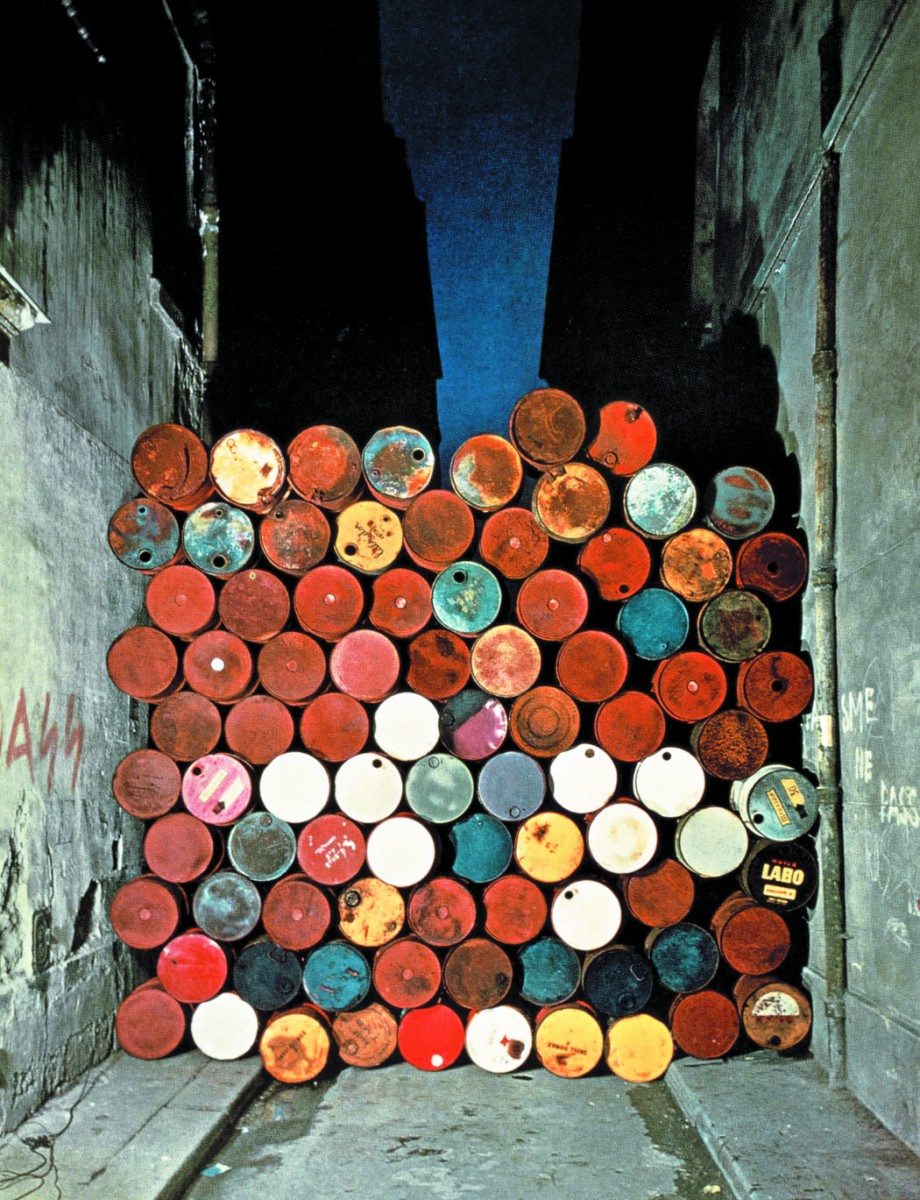
1962 – “Oil Barrels”- Germany
Jeanne-Claude and Christo created a piece in response to the building of the Berlin Wall, blocking off the Rue Visconti in Paris with a wall of oil drums. They convinced police to allow the installation to remain for a few hours.
1972 – “Valley Curtain” – Colorado
An orange curtain made from 200,200 square feet of woven nylon fabric was stretched across Rifle Gap in the Rocky Mountains. An earlier attempt was shredded by wind and rock.
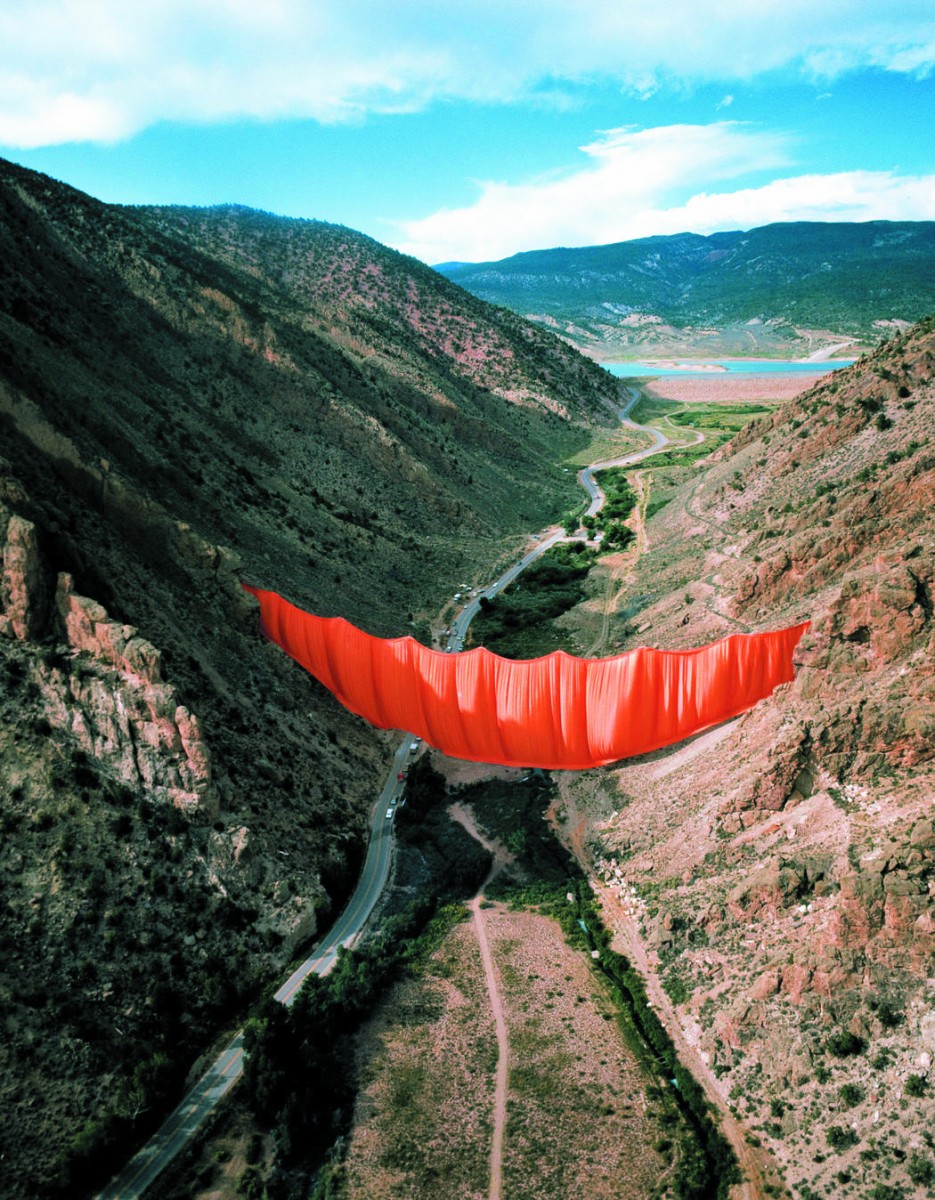
1976 – “Running Fence” – California
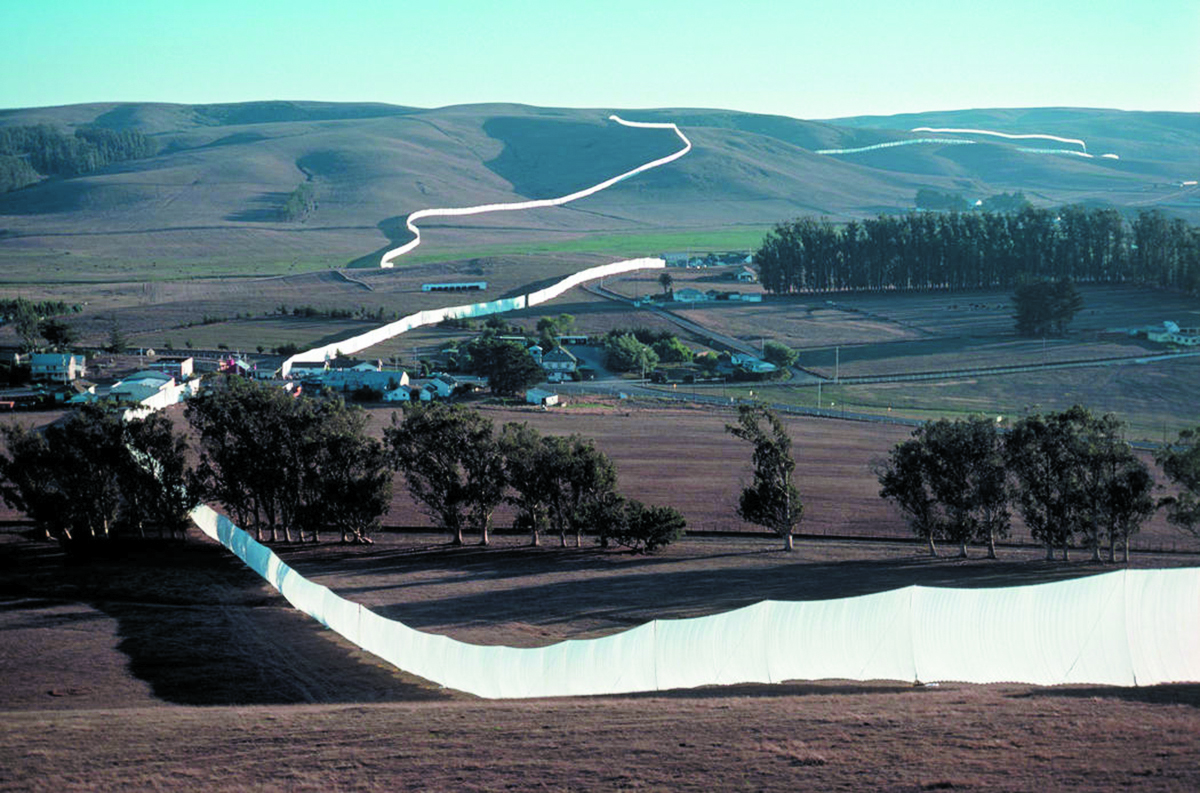
1983 – “Surrounded Islands” – Florida
Eleven islands on Biscayne Bay were surrounded with 6.5 million square feet of floating pink woven polypropylene fabric covering the surface of the water and extending out from each island into the bay.
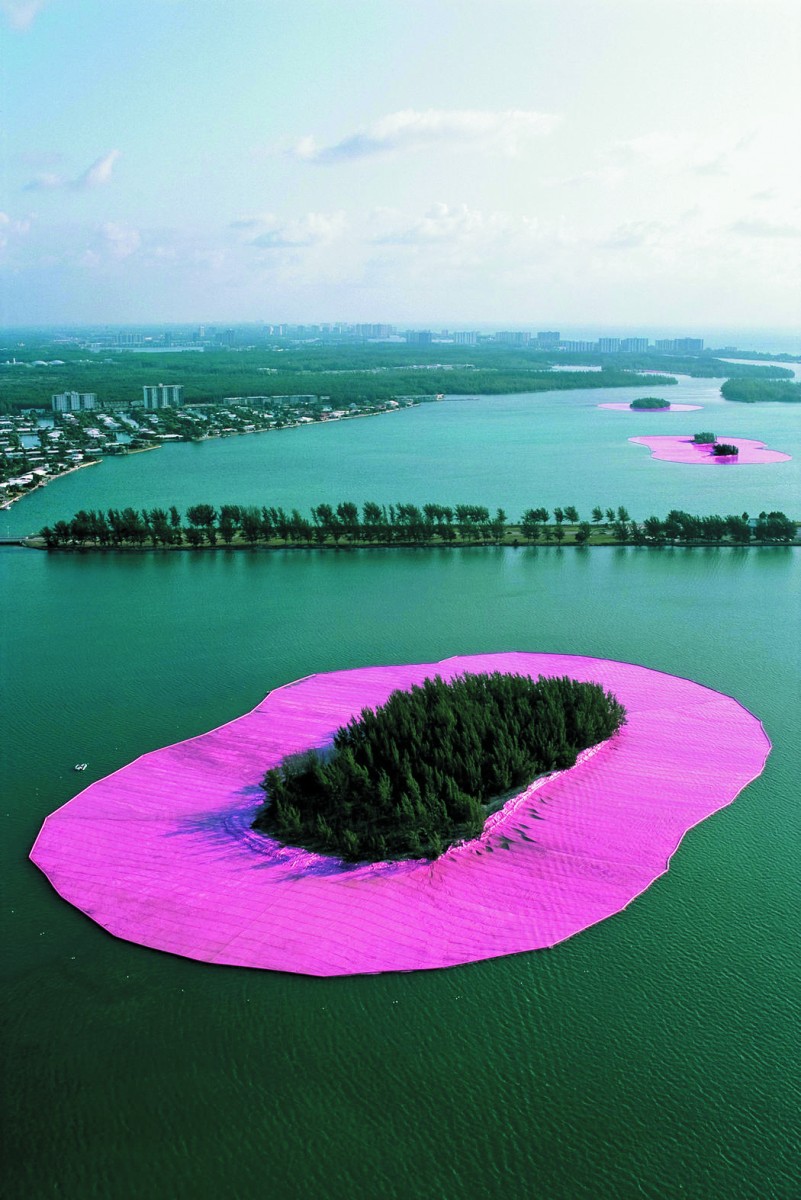
1991 – “The Umbrellas” – the U.S. and Japan
A temporary work realized in two countries at the same time, it was comprised of 3,100 opened umbrellas in Ibaraki (12 miles of them) and on Tejon Pass, along Highway 5, in Southern California (18 miles).
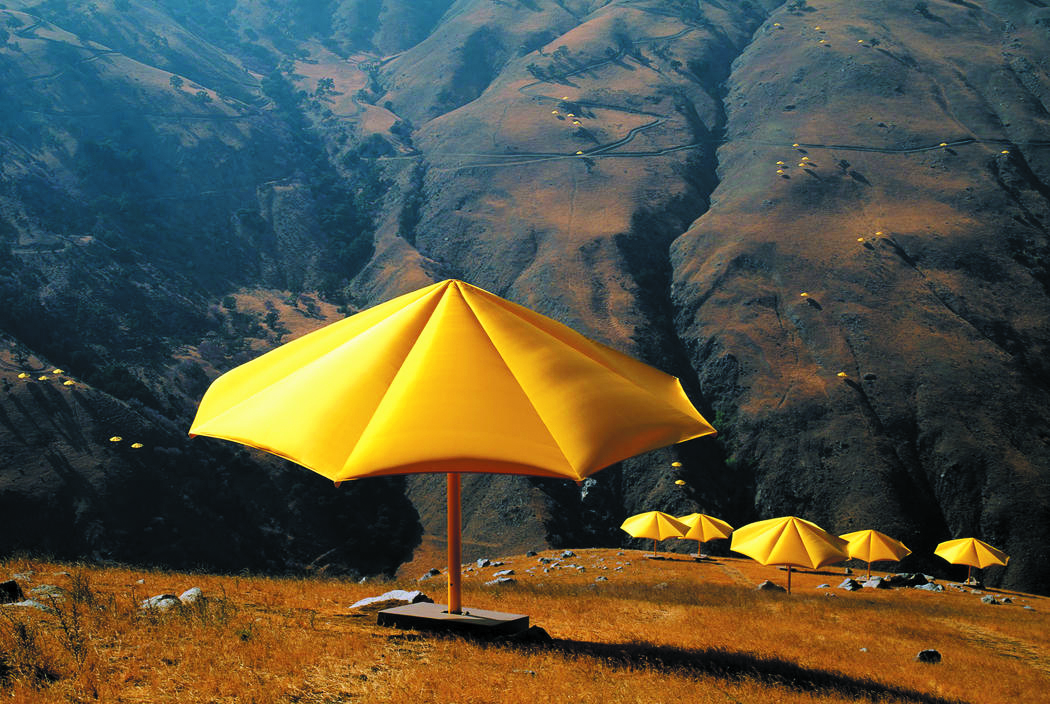
2005 – “The Gates” – New York
More than 7,500 gates made of saffron-colored fabric panels were installed in New York City’s Central Park, a golden river appearing and disappearing through bare tree branches.
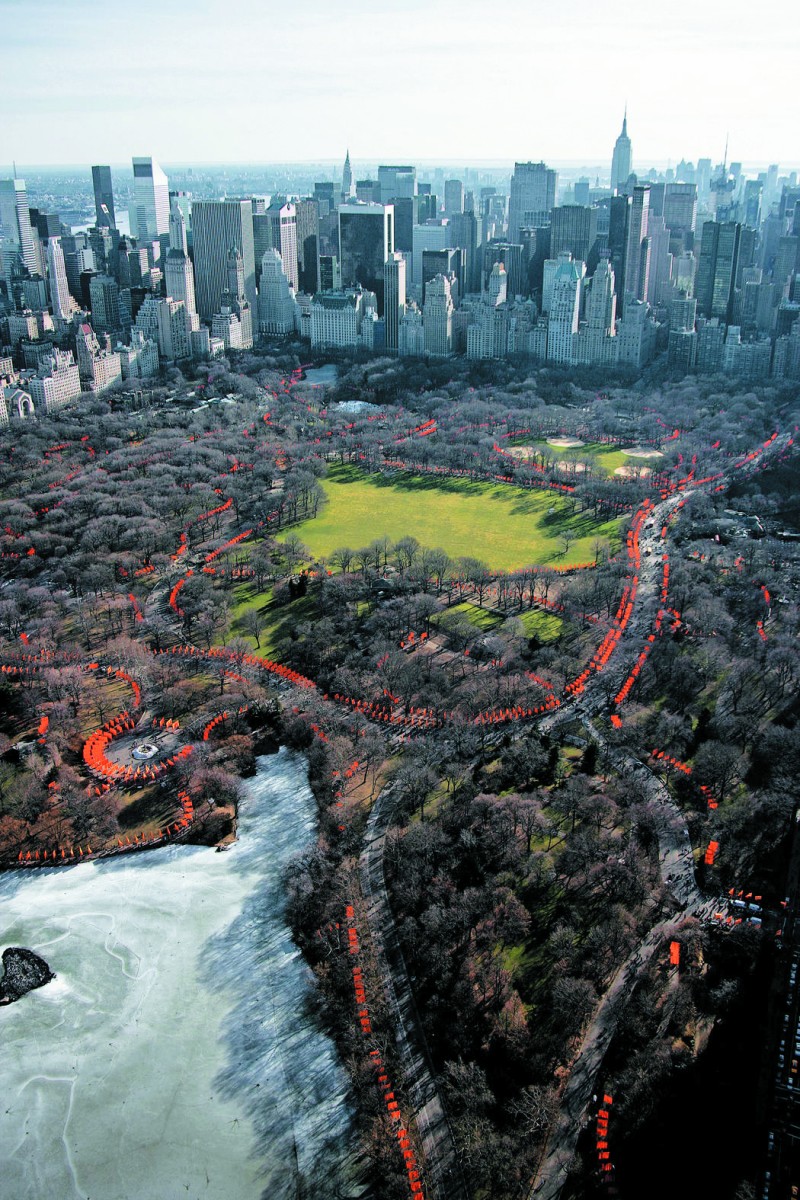
2016 – “The Floating Piers” – Italy
From June 18 to July 3, Lake Iseo in Lombardy was partially covered in 62 miles of shimmering yellow fabric, supported by a modular dock system of 220,000 high-density polyethylene cubes floating on the surface of the water.
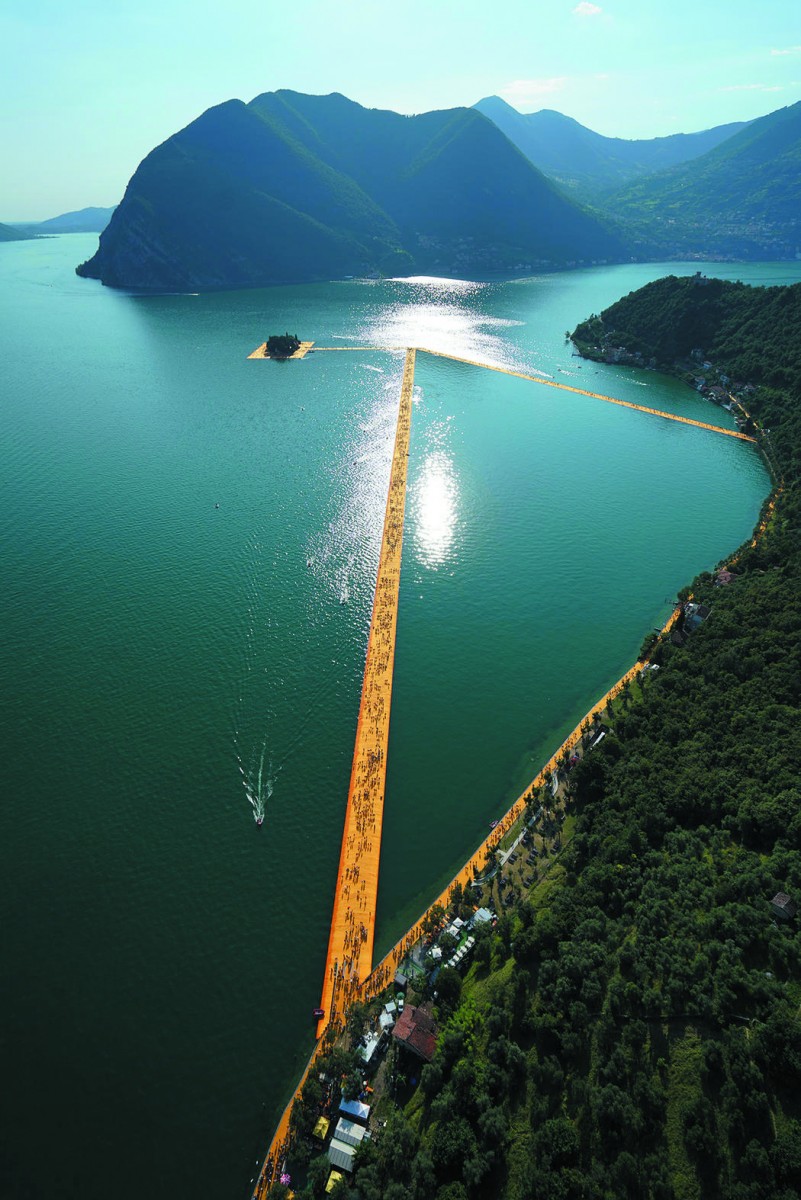
The post From the Archives: Memories of Christo’s Running Fence appeared first on Sonoma Magazine.
]]>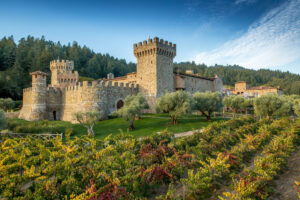
Medieval fortresses and parterre gardens, swimming pools and outdoor art galleries, riding horses and trolleys — there’s plenty of reason to venture outside the tasting room in Wine Country.
The post 12 Unique Winery Experiences in Sonoma and Napa Wine Country appeared first on Sonoma Magazine.
]]>









Weary, somewhat bleary of the spin-sniff-sip-swallow-or-spit wine tasting experience? These Sonoma and Napa wineries offer a little something extra to pair with your cabernet.
Medieval fortresses and parterre gardens, swimming pools and outdoor art galleries, riding horses and trolleys — there’s plenty of reason to venture outside the tasting room on your next Wine Country trip.
A trip to Germany at Schug Carneros Estate Winery
French, Italian and Spanish accents abound at Sonoma and Napa wineries, so a visit to Walter Schug’s German-styled winery in Carneros is as refreshing as a trocken riesling.
Schug, who died in 2015 at age 80, grew up at Staatsweingut Assmannshausen in Germany’s Rhine Valley. Bit by the winegrowing bug, he eventually made his way to Napa Valley, as winemaker for Joseph Phelps Winery. In 1983, he founded his own winery estate yard in Sonoma Carneros, the production facility and tasting room designed with the peaked roof and timber framing typical in the Rhine. All the original winemaking equipment came from Germany and some of it remains, most strikingly the 669-gallon wood oval aging casks, some of them elaborately carved.
Riesling is no longer in the Schug repertoire, the grape not ideally suited to Sonoma’s sunny climate. Instead, Schug took the pinot noir (spatburgunder) route, adding chardonnay, cabernet sauvignon and other varietals to the mix. His children continue the business, with German-American Johannes Scheid the winemaker.
The Cave Tour & Tasting Experience ($75) includes a walk around the property and through the production area and caves, followed by a seated tasting of current-release and Heritage Reserve wines, served with snacks.
602 Bonneau Road, Sonoma, 707-939-9363, schugwinery.com
Outdoor art gallery at The Donum Estate
Wineries have long been places for visitors to view art and photography on the walls of tasting rooms. Sculptures welcome guests at estate entrances and within sight of tasters.
Now, Donum has taken artistic displays well beyond the usual, dotting its 200-acre Carneros estate with 50-some large-scale, open-air sculptures from artists including Ai Weiwei, Keith Haring, Subodh Gupta and Doug Aitken. Adding to the high-end artistry: the tasting area designed by Danish architect David Thulstrup, known for his interior design of world-class Noma restaurant in Copenhagen.
The basic way to enjoy Donum is to book its Carneros Experience ($95), which includes a walking tour of the estate and tastes of its rosé, chardonnay and pinot noir. The Explore Experience ($175) is a two-hour, all-terrain-vehicle tour of the estate and tasting of wines served with seasonal bites and, of course, views of the artwork.
24500 Ramal Road, Sonoma, 707-732-2200, thedonumestate.com
Living history at Buena Vista Winery
Founded in 1857 by Agoston Haraszthy, Buena Vista is the second-oldest winery in California and is often referred to as the oldest premium winery in the state. (The oldest winery in California is D’Agostini Winery, which was founded in 1856.)
Haraszthy, a vivacious and eccentric pioneer, immigrated from Europe in 1840 in search of the good life. Following in the footsteps of the forty-niners, he found the perfect terroir for “purple gold” and, as the self-proclaimed “Count of Buena Vista,” he established a reputation as an experimental vintner, a shrewd businessman and a flamboyant evangelist. (He died as he had lived — dramatically — in an alligator-infested river in the jungles of Nicaragua.)
The legend of Haraszthy and his winery is now recreated by Buena Vista owner Jean-Charles Boisset, a modern-day version of the eccentric count. The best way to get a taste of the winery’s history (and some wine) is to reserve the Barrel Tasting & Winery Tour ($50), which takes visitors on a stroll through the winery grounds and into the Champagne Cellar for a taste of current release wines. Next, the tour continues into the wine caves where guests can sample wine from the barrel.
18000 Old Winery Road, Sonoma, 800-926-1266, buenavistawinery.com
Horsing around among the vines at Jack London State Park
They say, “don’t drink and drive,” but can you drink and ride?
At Triple Creek Horse Outfit in Glen Ellen, the riding is sensibly taken care of before the drinking. And what a ride it is. Triple Creek offers guided horseback tours at Jack London State Historic Park in the magical Valley of the Moon. The park features fine riding trails through Jack and Charmian London’s Beauty Ranch, which wind around acres of vineyards, through open oak woodlands and under shady groves of majestic redwoods.
All Triple Creek Horse Outfit rides include a complimentary wine tasting at nearby VJB Cellars in Kenwood. The winery also has a gourmet Italian deli and sells wood-fired pizza, gelato and more. Private rides (one hour to two hours) are $145 to $225 per rider. Questions are best addressed via email at triplecrik@gmail.com. Bookings can be made online.
2400 London Ranch Road, Glen Ellen, 707-888-0034, triplecreekhorseoutfit.com
Humming bees and lavender fields at Matanzas Creek Winery
Matanzas Creek Winery in Bennett Valley has been a haven for wine enthusiasts and lavender-lovers since 1991. Guests to the winery can sip sauvignon blanc on a terrace overlooking fields of lilac and amethyst; the soothingly seductive perfumes wafting in the breeze to the hum of bees shifting busily among the blossoms.
The end of June/beginning of July is prime lavender season at Matanzas Creek Winery. The fields are organically farmed and are cut, bundled and hung to barn dry after reaching full bloom. Then the dried blossoms are used in culinary, bath, body and home products sold in the winery’s lavender market.
Tastings (from $35) are by appointment. Picnic tables (with bottle service) can be reserved for two hours ($25 on weekdays; $50 on weekends). Bocce courts can be rented for two hours daily ($20 per person).
6097 Bennett Valley Road, Santa Rosa, 707-528-6464, matanzascreek.com
An all-terrain adventure at Chenoweth Wines
Of the more than 400 wineries that call Sonoma County home, the grand estates have a knack for getting all the attention. But when you make the turn onto the retired tractor-lined driveway at Chenoweth Wines, it’s the unpretentious setting that makes you happy you’ve arrived.
With 800 acres of land, from redwoods to vineyards, the Chenoweth estate offers plenty to see. But it’s how you get to see it — buckled into an all-terrain vehicle — that adds even more bragging rights to a busy day of wine tasting.
ATV tours ($125 per person) take about 1 1/2 hours and traverse the Chenoweth ranch, redwood grove and vineyards and make stops for wine tasting outdoors. At tour’s end, guests can stay and enjoy their own picnic in the redwood grove. Tours are limited to eight guests and can be booked by calling 707-829-3367 or emailing joinus@chenowethwines.com.
5550 Harrison Grade Road, Sebastopol, 707-331-2734, chenowethwines.com
A taste of history at Three Sticks Wines
The historic Vallejo-Casteñada Adobe is the longest occupied residence in Sonoma and one of the town’s few remaining buildings from California’s Mexican period.
Constructed in 1842 by Captain Salvador Vallejo (the infamous brother of General Mariano Vallejo), the adobe has been carefully restored by Three Sticks owners Bill and Eva Price, who now house a private tasting room for their Three Sticks wine label in the historic building.
Visitors can tour the adobe and take in its history while tasting a flight of pinots and chardonnays ($65) or finish the experience with a food and wine pairing prepared in partnership with the celebrated chefs at El Dorado Kitchen.
New this season is the Oysters & Chardonnay pairing ($95) that includes a flight of three single vineyard chardonnays and half a dozen oysters on the half shell (three types of oysters). Guests get to learn about terroir (how environmental factors like soil, topography and climate impact the wine) and merroir (how the bivalves’ marine surroundings influence their flavor).
143 W. Spain St., Sonoma, 707-996-3328, threestickswines.com
Cabernet on a cable car, Sonoma Valley Wine Trolley
Lack a designated driver? Think limousine tours are for tourists? Biking and wining a precarious pair? The Sonoma Valley Wine Trolley might just be what you’re looking for.
Built from the blueprints of an 1890s San Francisco cable car, the trolley safely trundles wine enthusiasts on a six-hour ride through Sonoma Valley.
The journey begins at Sonoma Plaza and then makes three stops at local wineries for private tasting experiences (the stops change with the seasons and include wineries such as Ravenswood, Imagery Estate, Paradise Ridge, Gloria Ferrer and B.R. Cohn).
Included in the package is a guide, a boxed lunch, views of the bucolic Wine Country landscape and plenty of bottled water. Daily Sonoma tours begin at 10:15 a.m. and end at 4:30 p.m. The tour is $125 and reservations can be made online. Tasting fees at the wineries range from $30 to $40 per person.
Wine wonderland at Francis Ford Coppola Winery
Bringing the kids on a wine tasting trip may not seem the best of ideas, that is unless you are destined for Francis Ford Coppola’s winery.
The famous filmmaker’s Geyserville estate is a wonderland with wine: film memorabilia (including Don Corleone’s desk from “The Godfather”) and Oscars are on display; its two swimming pools (3,600 square feet in total) are surrounded by chaise lounges, cabanas and bocce courts; and there is always plenty of wine for the adults.
Seated tastings on the terrace are $40. Bocce courts can be reserved 11 a.m., 1 p.m. and 3 p.m. Thursday-Monday. ($50 per person, plus tax; available for parties of eight to 24 guests).
Cabana reservations, which is the only way to access the pool, become available on the winery’s website in late spring. (The pool is typically open from mid-June to early October.) It is a popular place to be during summer in Wine Country, so make sure to make your cabana reservations early.
300 Via Archimedes, Geyserville, 707-857-1400, thefamilycoppola.com
Tulips and trees at Ferrari-Carano Vineyards and Winery
Ever experienced a tulip emergency? Healdsburg’s Ferrari-Carano Vineyards and Winery has a tulip hotline set up in the late winter/early spring months for fans eager not to miss the winery’s 10,000 tulips in bloom.
The five-acre winery gardens also feature over 2,000 species of trees and shrubs, a variety of perennials and annuals (the tulips and daffodils take center stage in the spring), waterfalls that flow into fish-filled ponds and bronze sculptures from renowned artists Dennis Smith, Douglas Van Howd and Jane DeDecker.
The Italian/French parterre gardens accentuate classic geometric shapes. The enclosed garden at the front of Villa Fiore (the estate winery) has a parklike setting, its design more relaxed and its emphasis on color and texture.
Take in views of the gardens and surrounding vineyards from the winery’s Sycamore Grove terrace during the Wine & Brunch experience (10:30 a.m. to 1 p.m. on Sundays; $85 per person).
The brunch includes a flight of reserve wines paired with a seasonal, Italian-inspired menu with dishes such as Prosciutto Benedict with roasted potato and estate garden greens; Yannis Sausage & Farm Fresh Egg Strata topped with Valley Ford Estero Gold Cheese; and TCHO Dark Chocolate Panna Cotta for dessert. Advance reservations and prepayments are required (reservations are refundable up to 72 hours prior to visit).
8761 Dry Creek Road, Healdsburg, 707-433-6700, ferrari-carano.com
Portal to the middle ages at Castello di Amorosa
It’s no surprise that some refer to Dario Sattui, a fourth generation vintner and the man behind Castello di Amorosa, as a modern-day Don Quixote.
Some 20 years ago, Sattui began a 15-year quest to build a medieval-style Tuscan castle in Napa Valley as a place to showcase his wines. The result: a 107-room, eight-level, 121,000-square-foot castle complete with drawbridge, secret passageways, torture chamber and tasting rooms.
Seated and standing tastings ($60 and $50) give visitors access to the two main levels of the castle via a self-guided tour (strategically posted QR codes make it easy to learn about the winery at your own pace).
The Diamond Estate Tour & Reserve Wine Tasting ($70) and the Cheese & Charcuterie Wine Pairing Tour ($85) include guided tours that take visitors through the two main levels and also into the production area, underground cellars, torture chamber and armory. Reservations required for all tastings.
4045 St Helena Highway, Calistoga, 707-967-6272, castellodiamorosa.com
Gondola glides to the tune of old English bells at Sterling Vineyards
A one-of-a-kind aerial tram glides you on a 360-degree scenic ride up a tree-covered hill to the winery. Debarking at the summit, visitors can then begin to explore the chalk-white stuccoed, many-verandaed winery. Its architectural inspiration? The Greek villages on the island of Mykonos where Sterling founder, Peter Newton, once lived.
High in the towers at Sterling Vineyards are eight bells that once hung in London’s Church of St. Dunstan’s-in-the-East. When the Anglican church, founded in the Saxon 10th century, was badly damaged by the Great Fire of 1666, it was repaired and a Christopher Wren steeple added. (St. Dunstan’s was much later mortally damaged during the London Blitz in 1941.)
The bells found their way to Calistoga in the 1970s and soon visitors can continue to enjoy the timelessness of their reverberations at Sterling Vineyards.
1111 W. Dunaweal Lane, Calistoga, 800-726-6136, sterlingvineyards.com
Linda Murphy and Dana Rebmann contributed to this article.
The post 12 Unique Winery Experiences in Sonoma and Napa Wine Country appeared first on Sonoma Magazine.
]]>